The Honourable Scott Brison came to campus Feb. 28, for a town hall with students, faculty and staff about the federal budget.
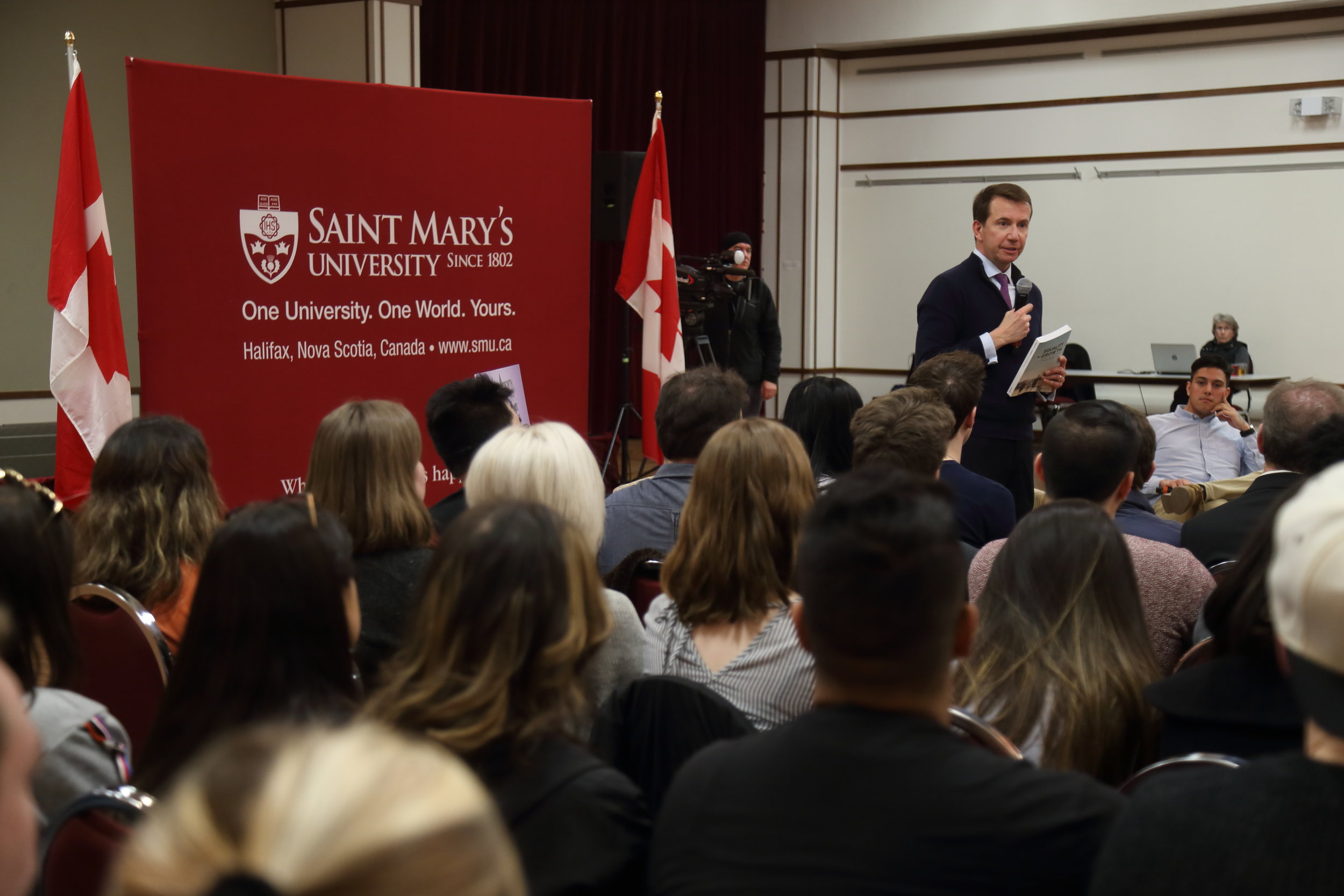
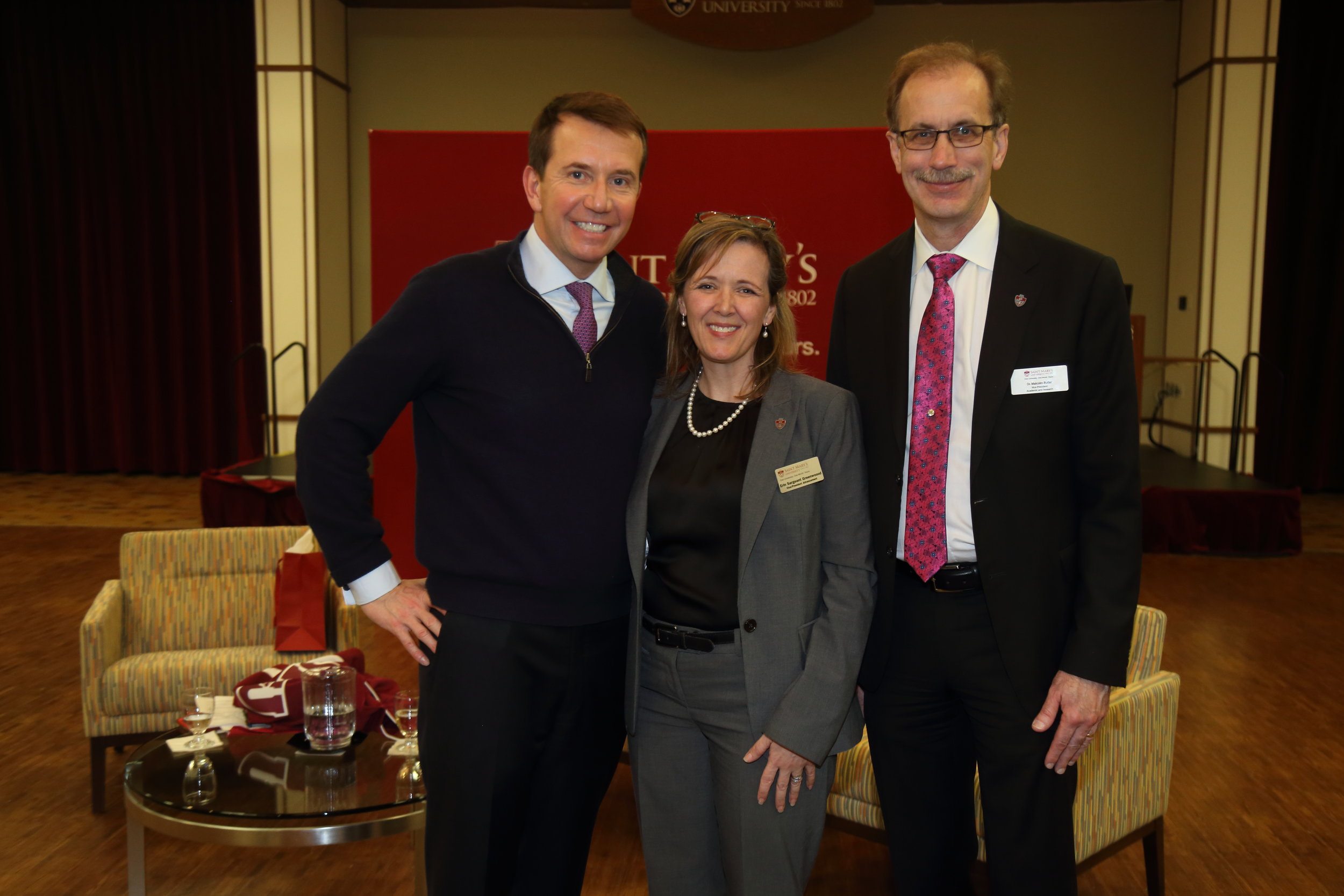
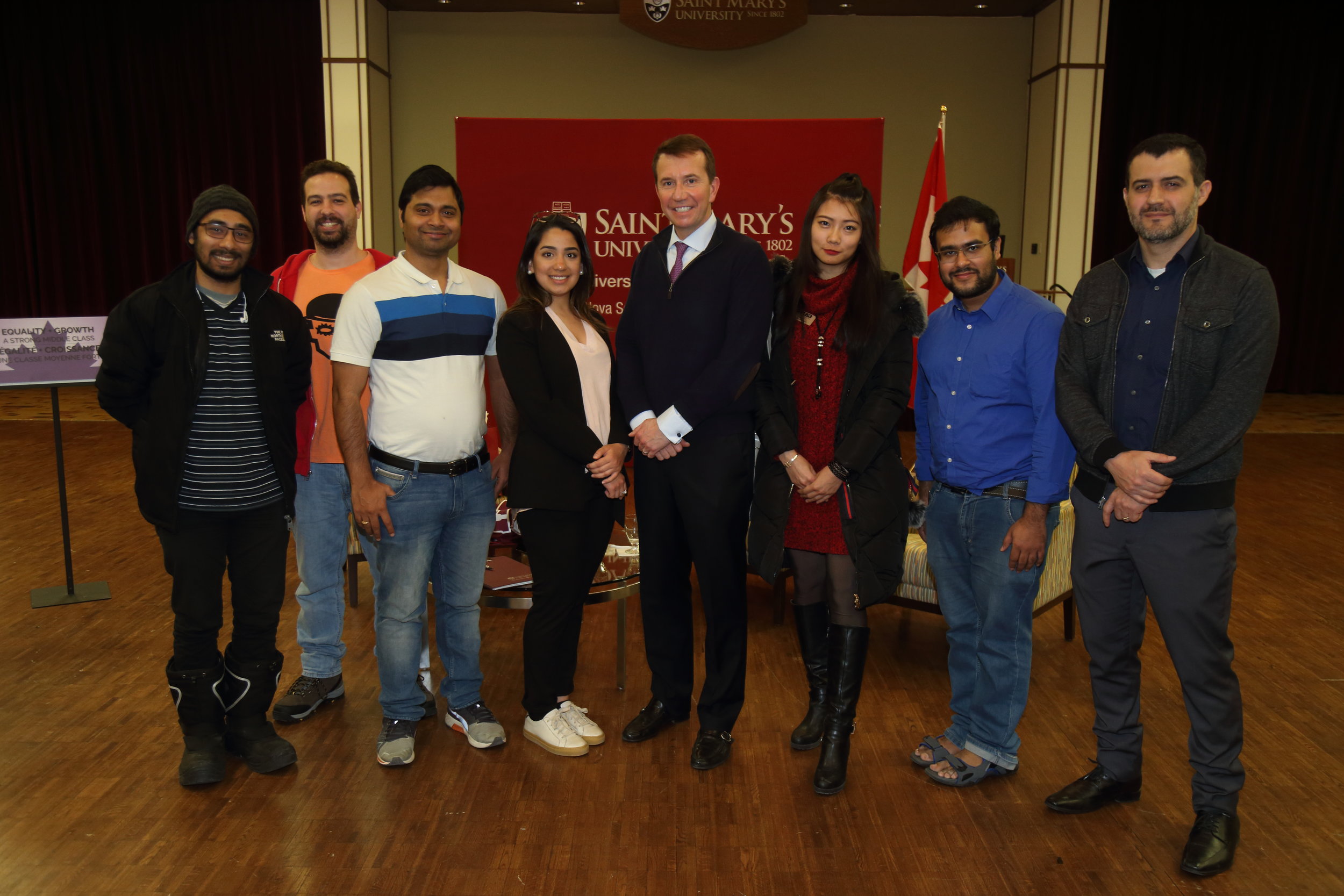


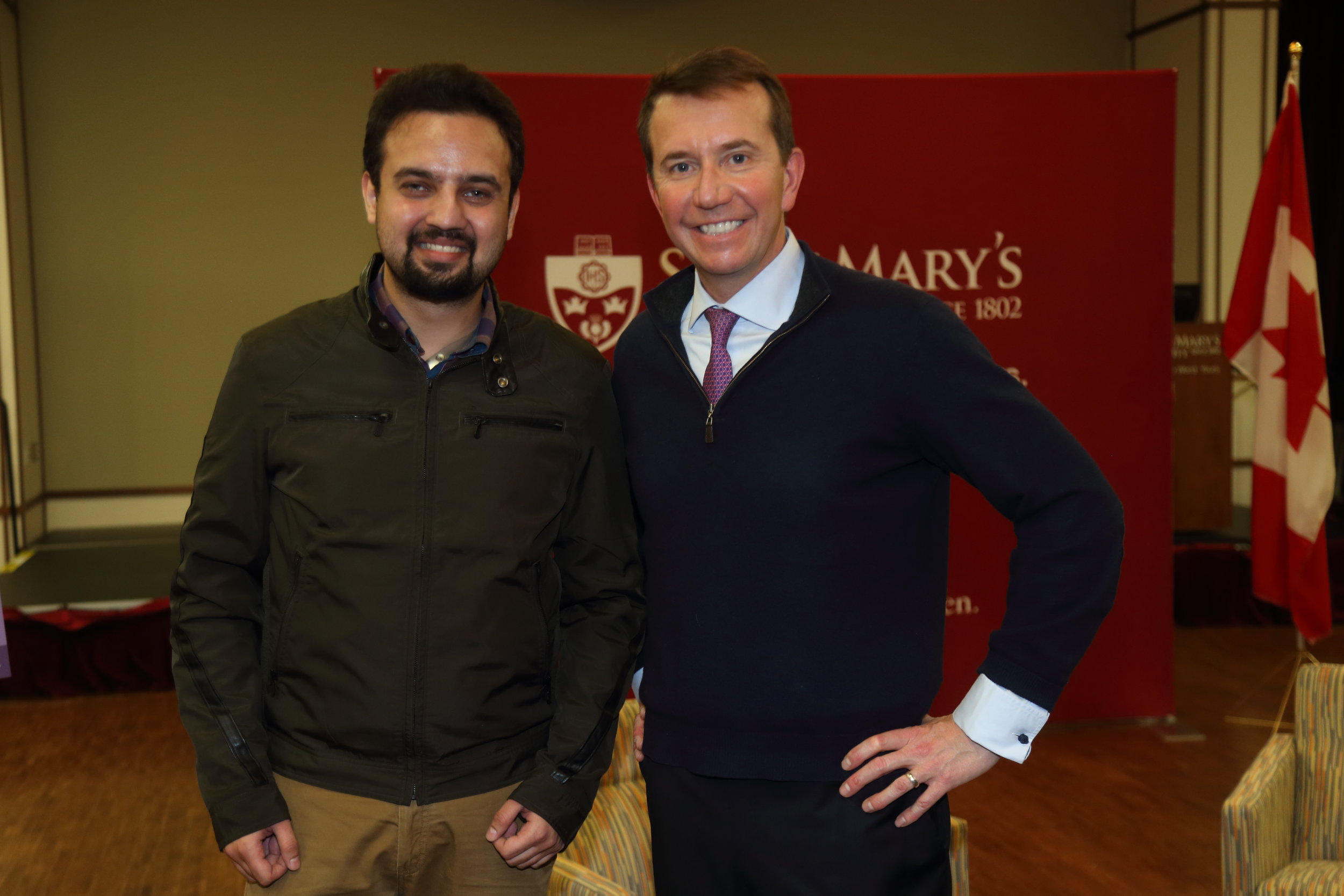
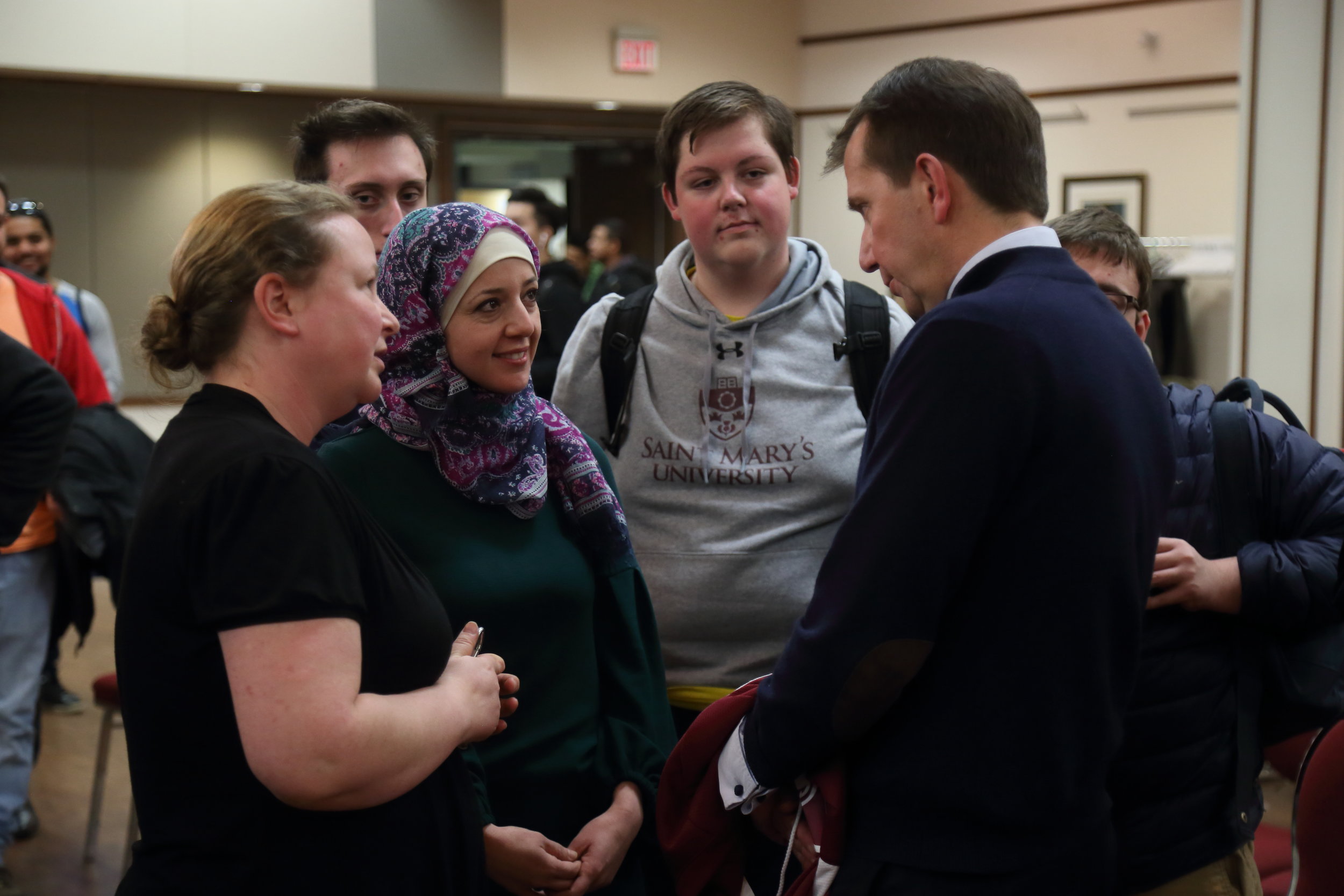


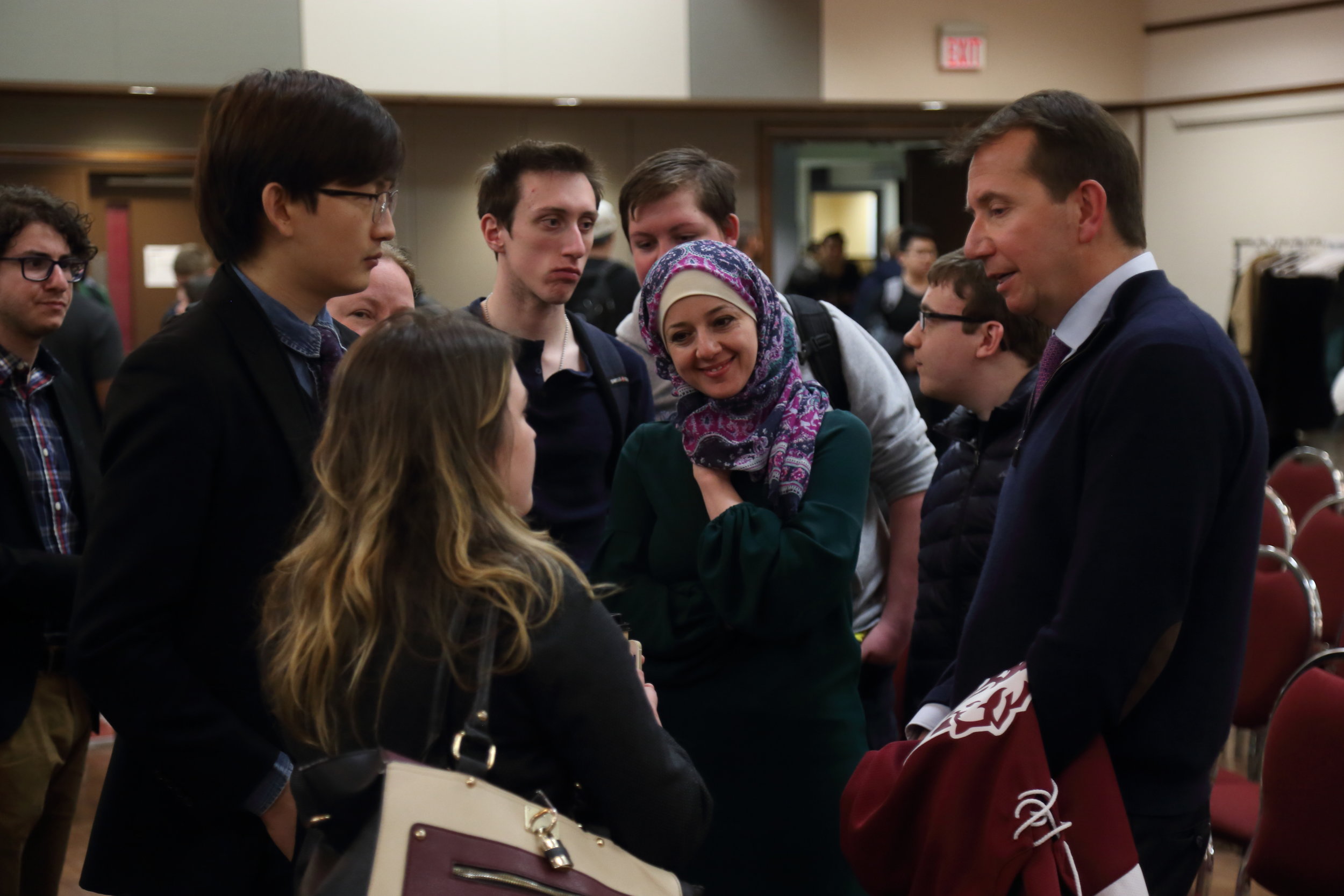
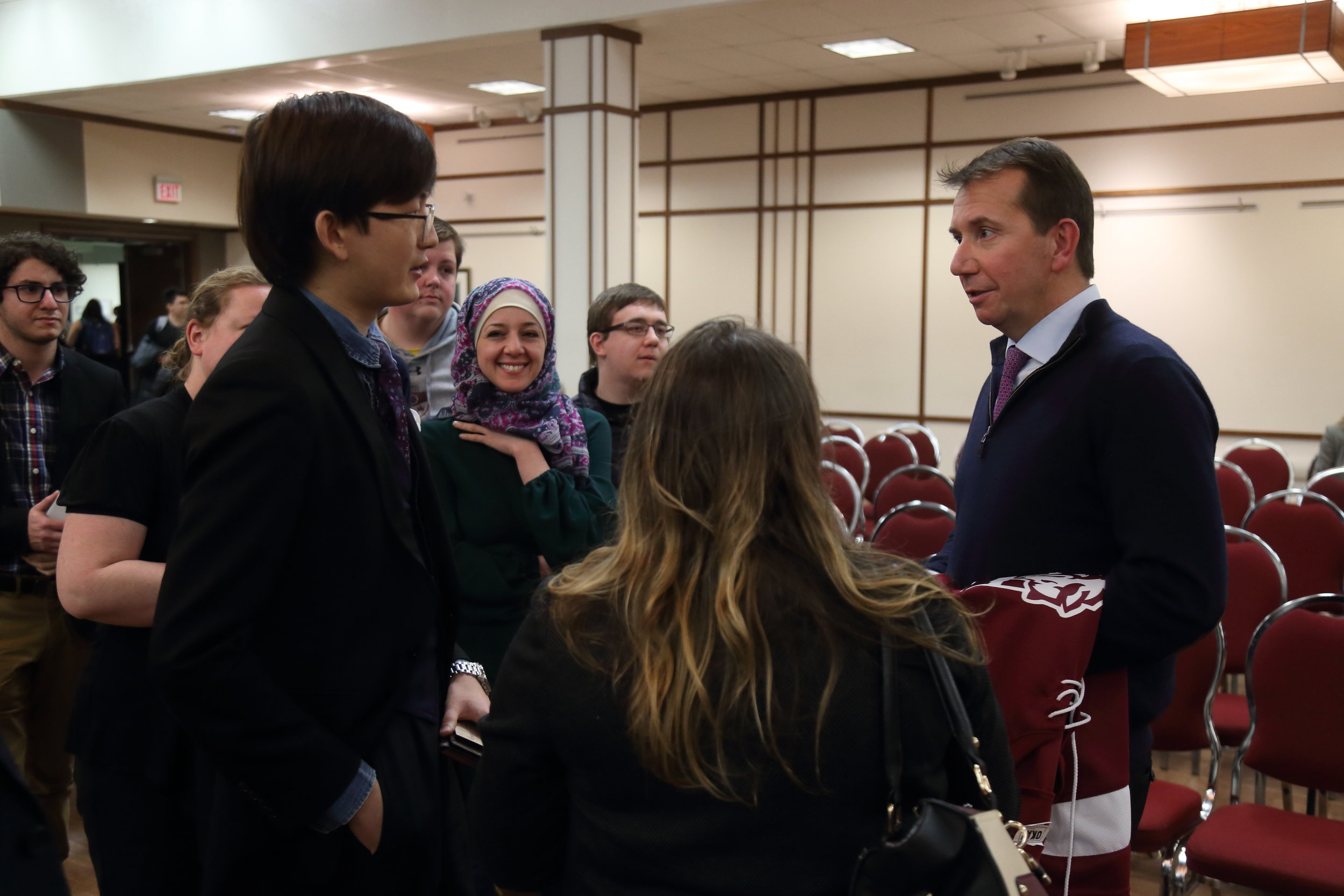
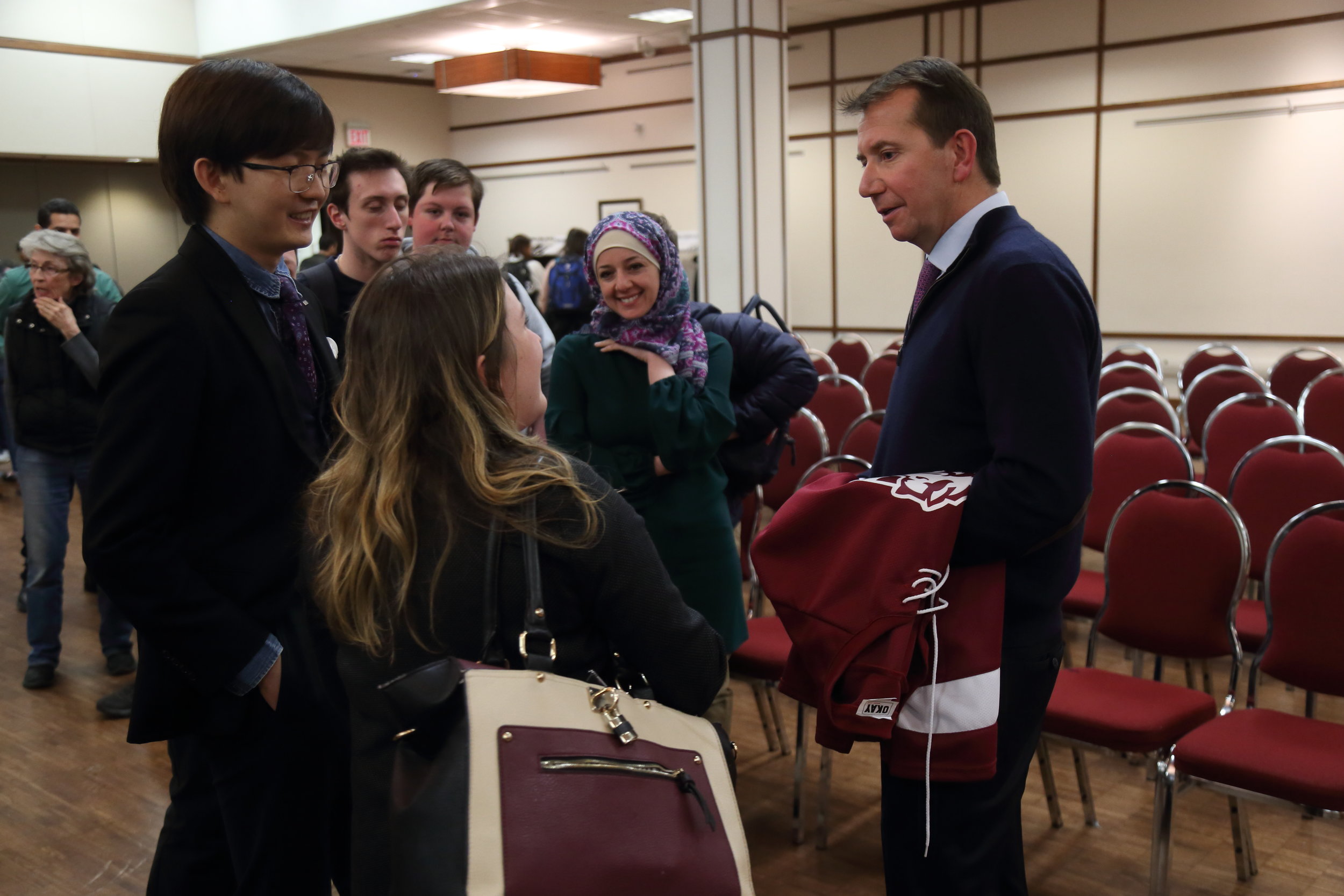

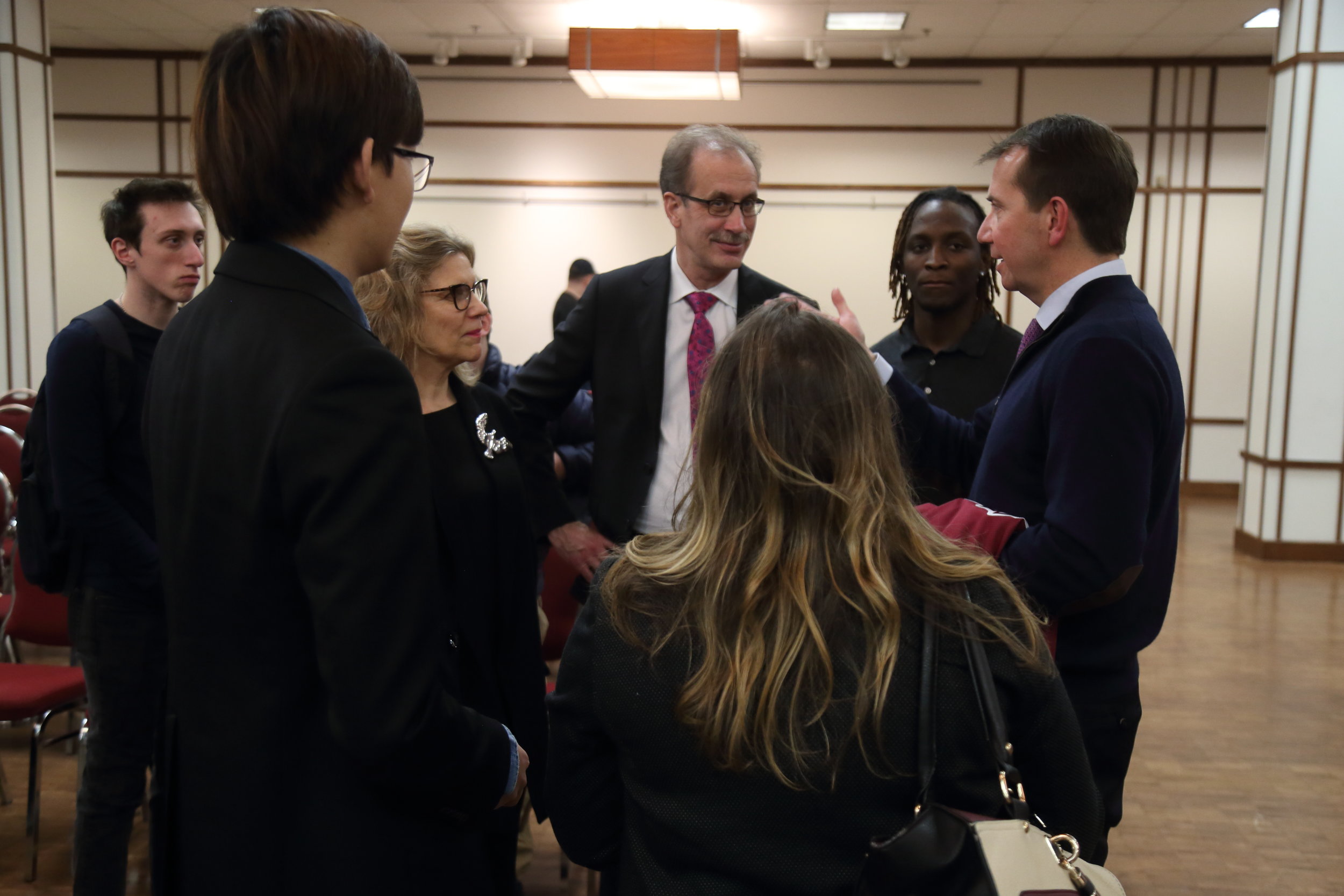

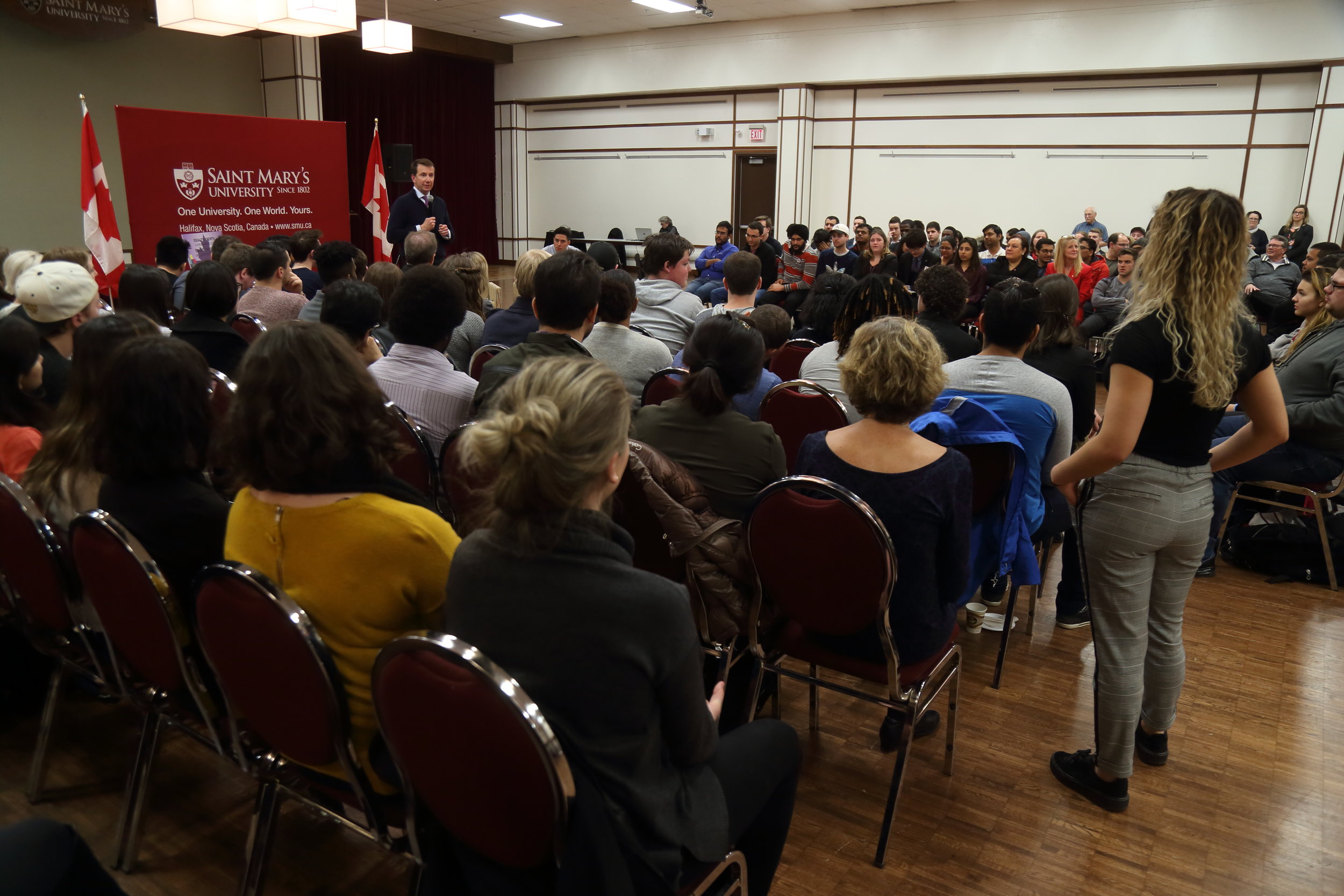
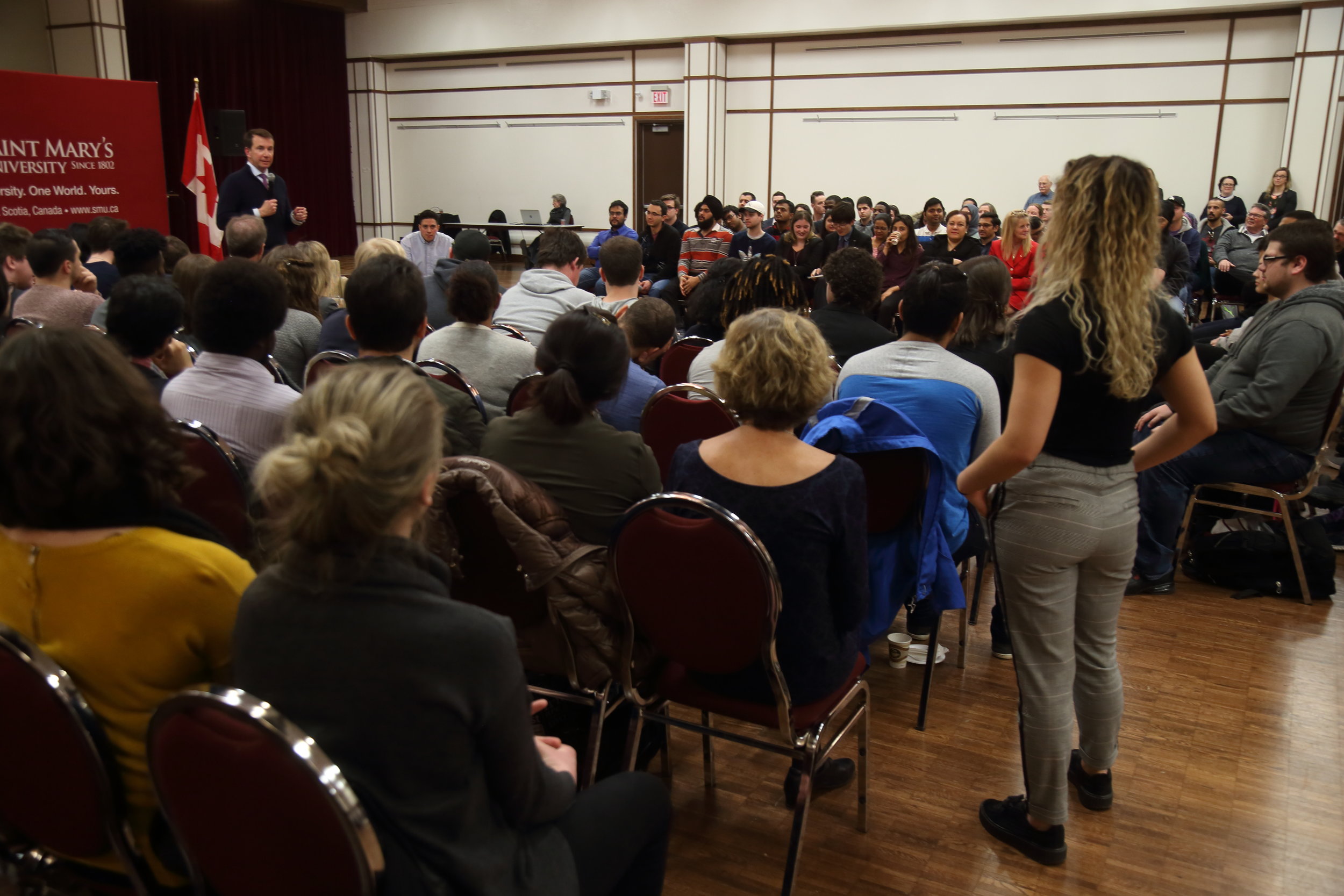
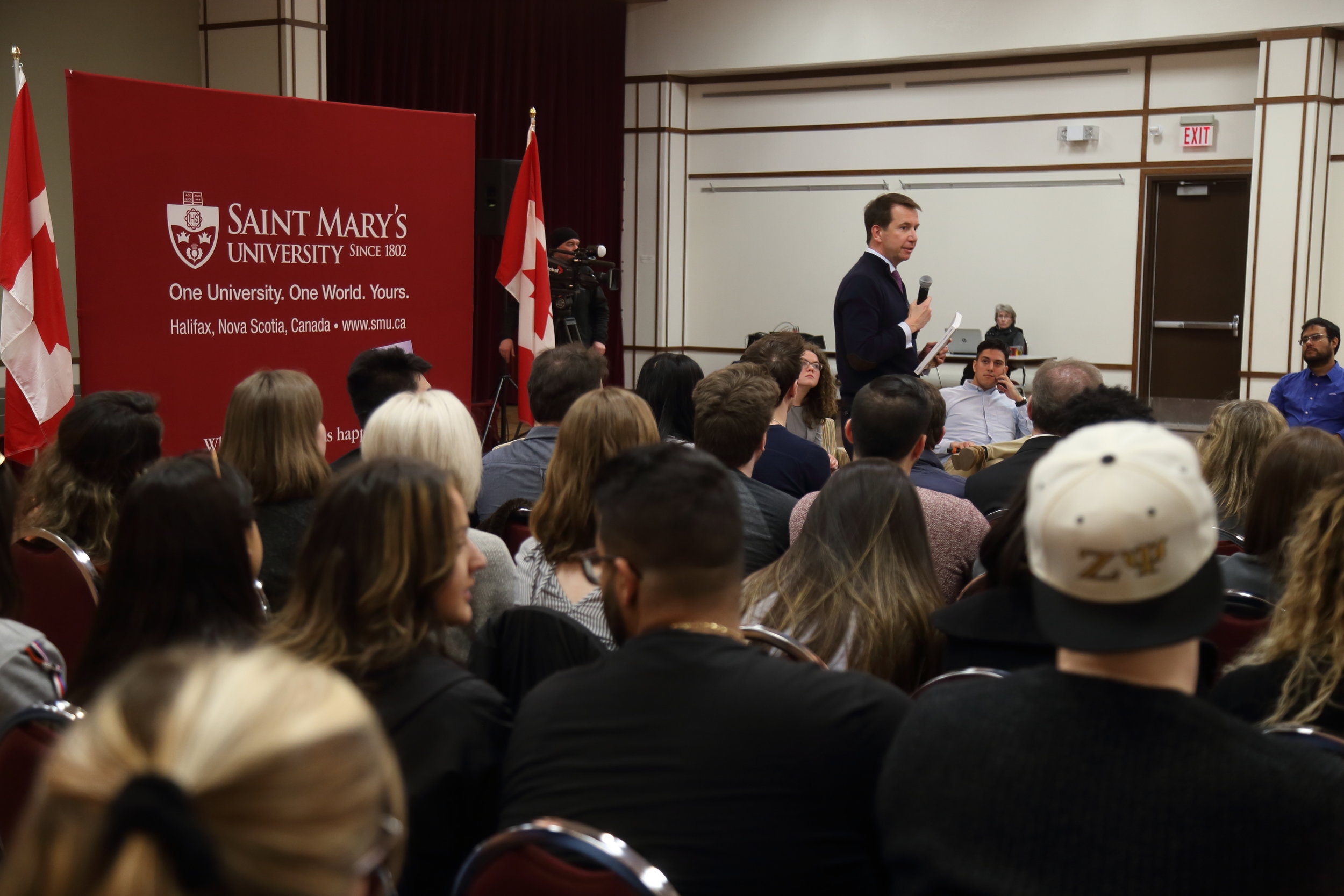
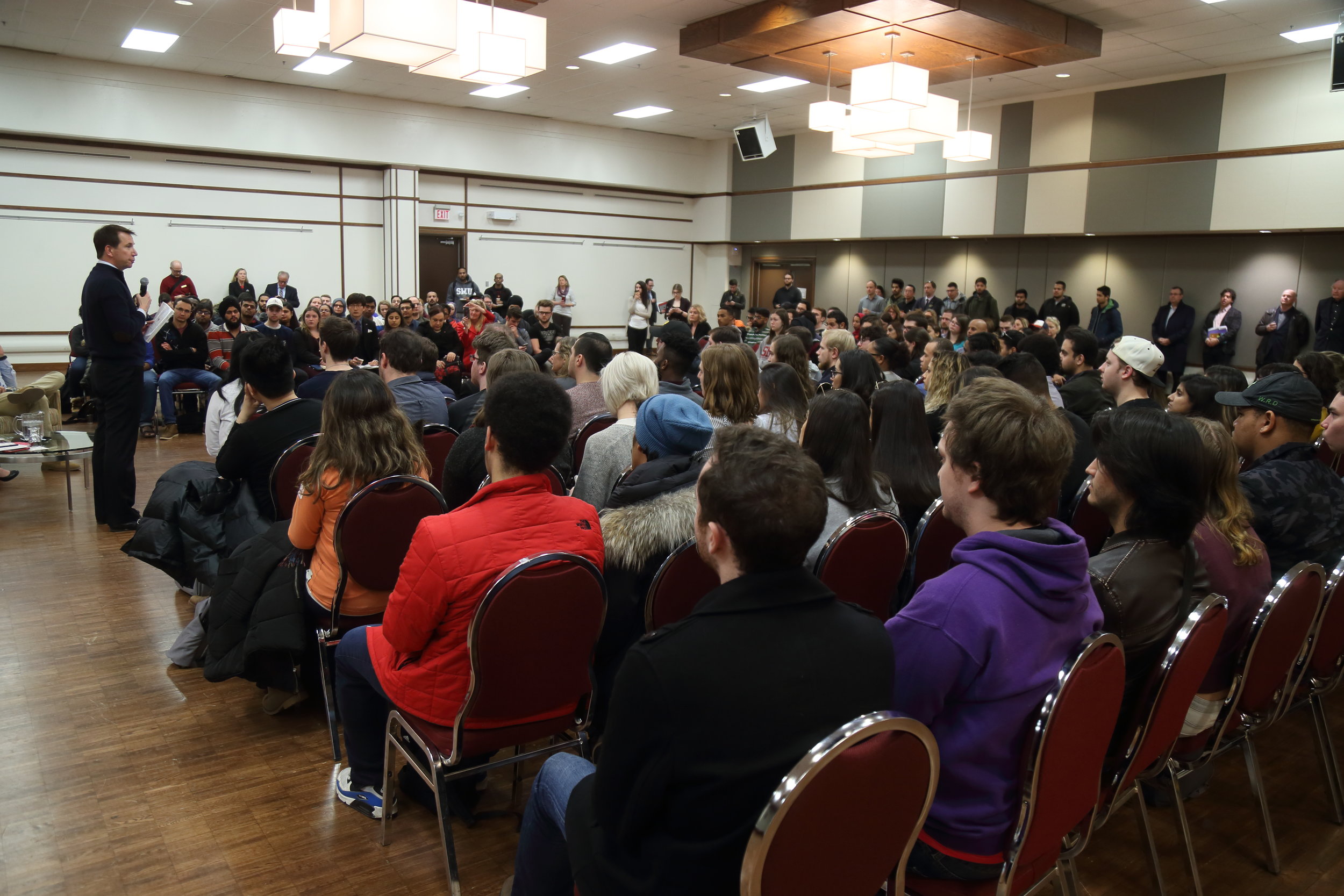
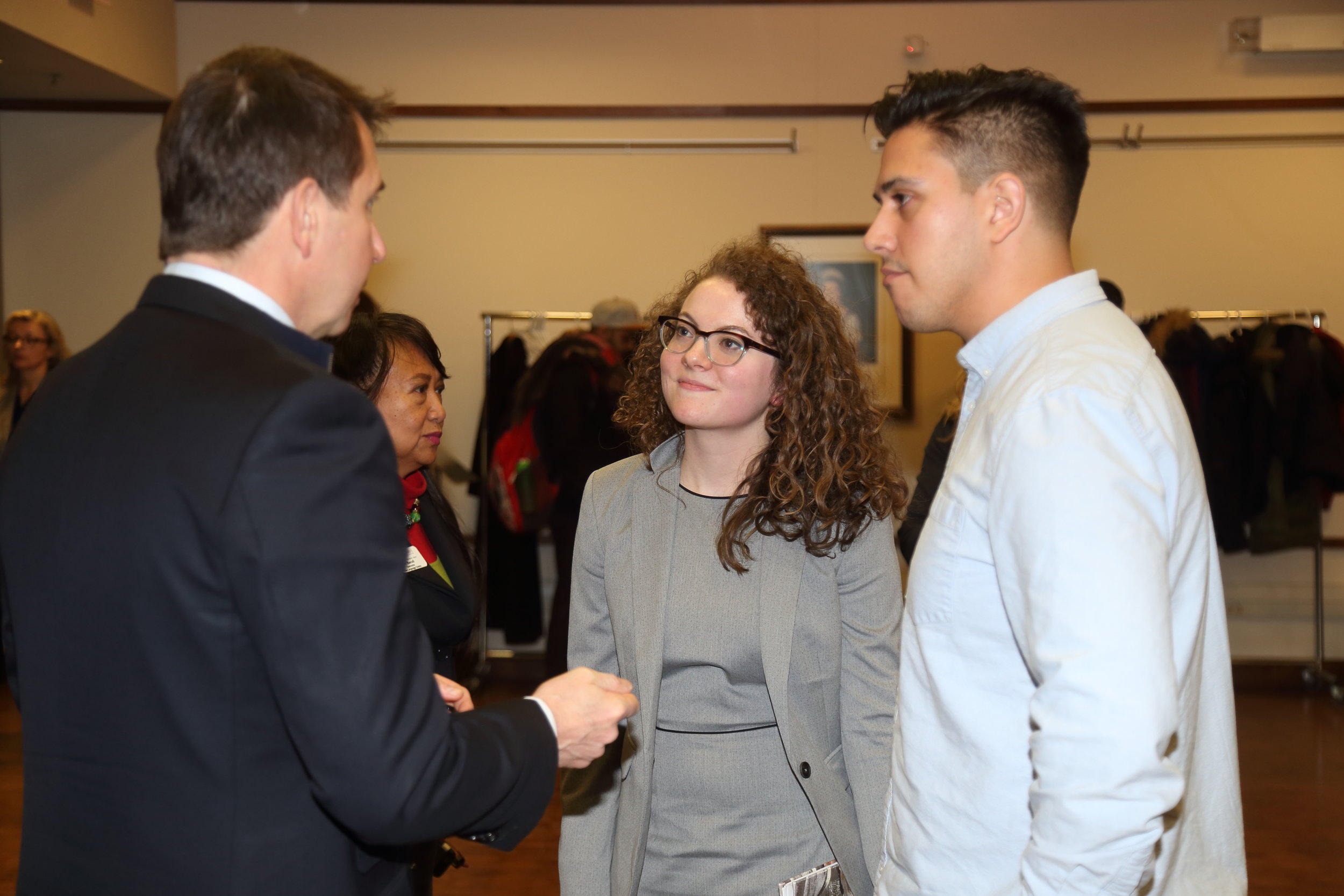
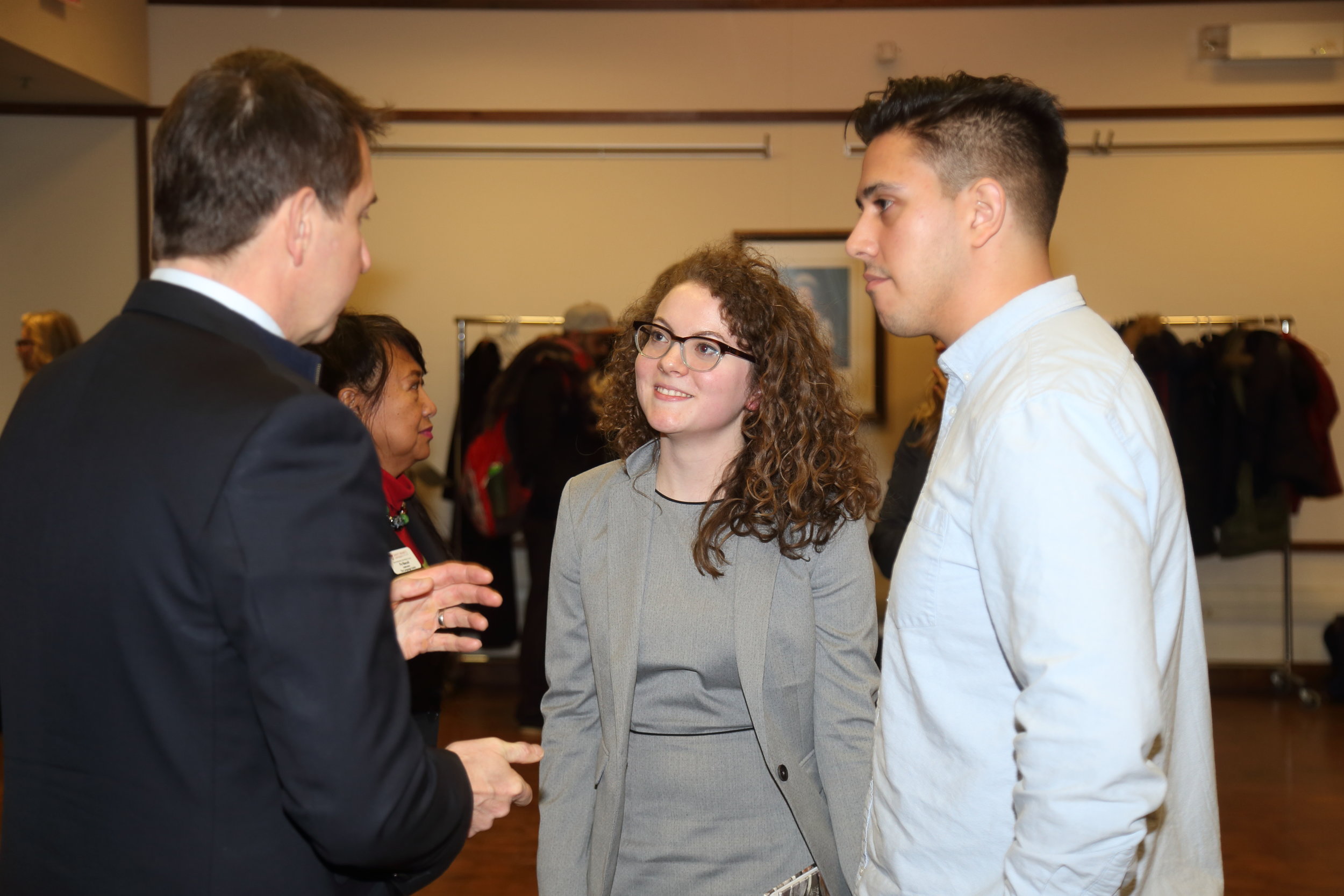
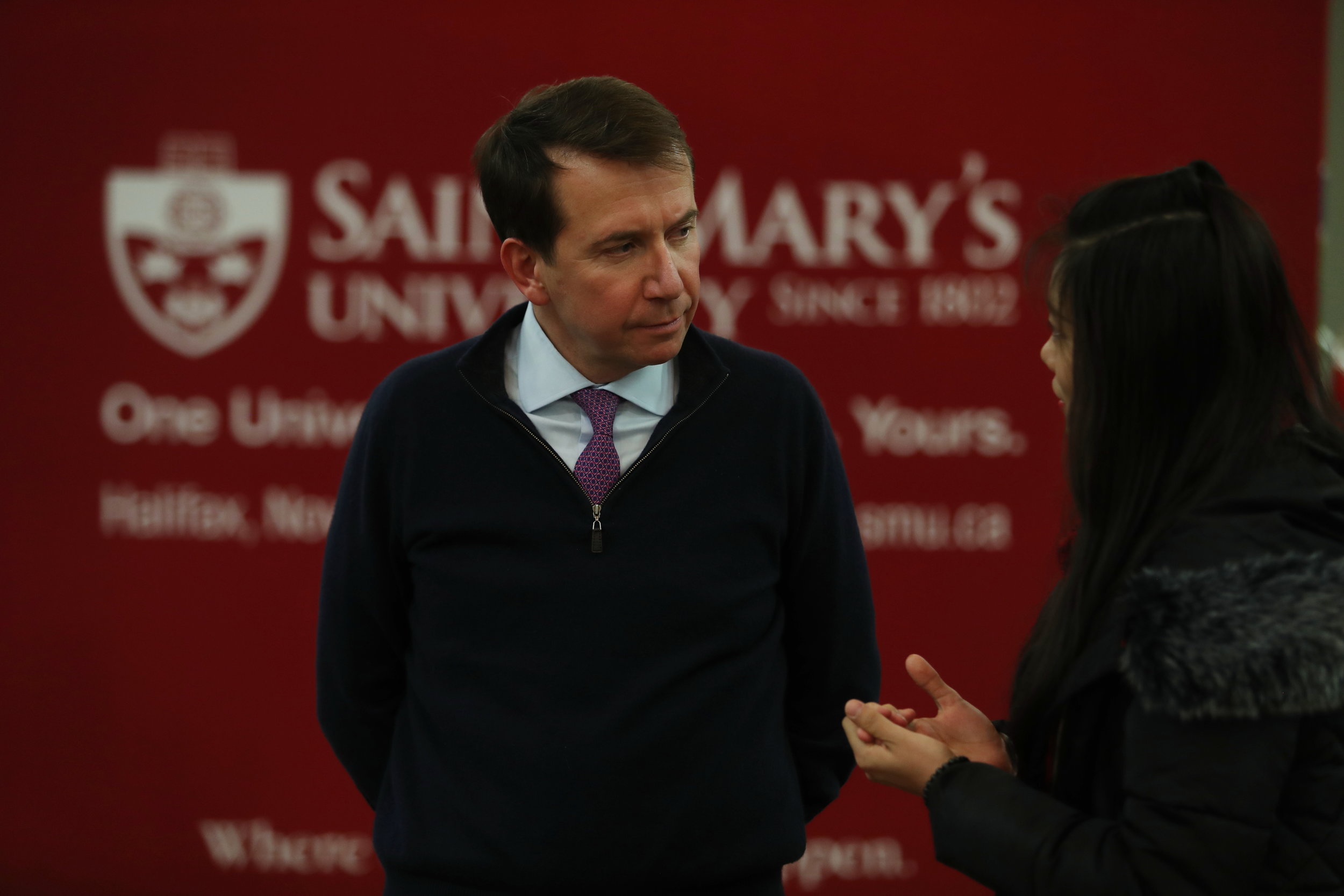
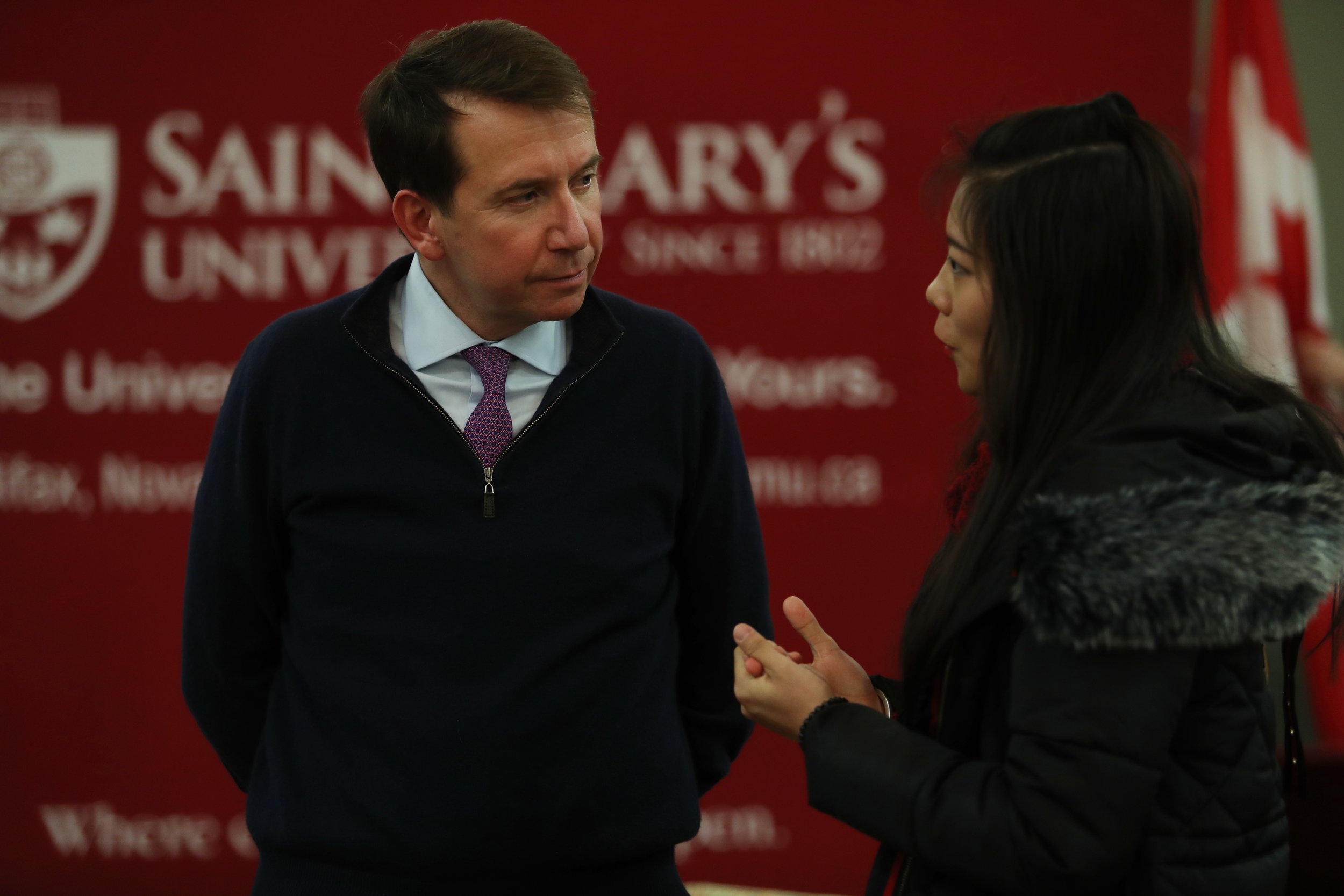

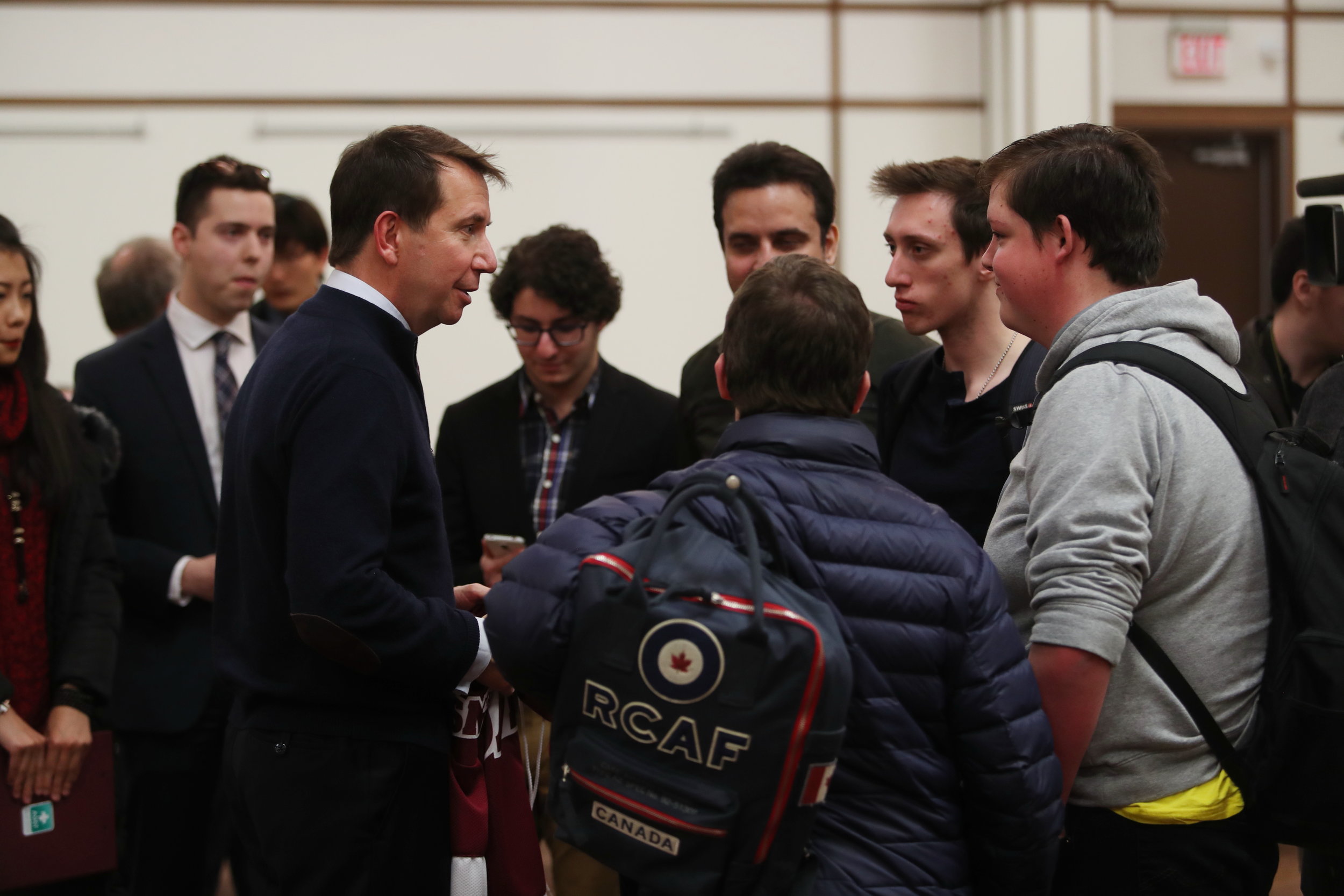
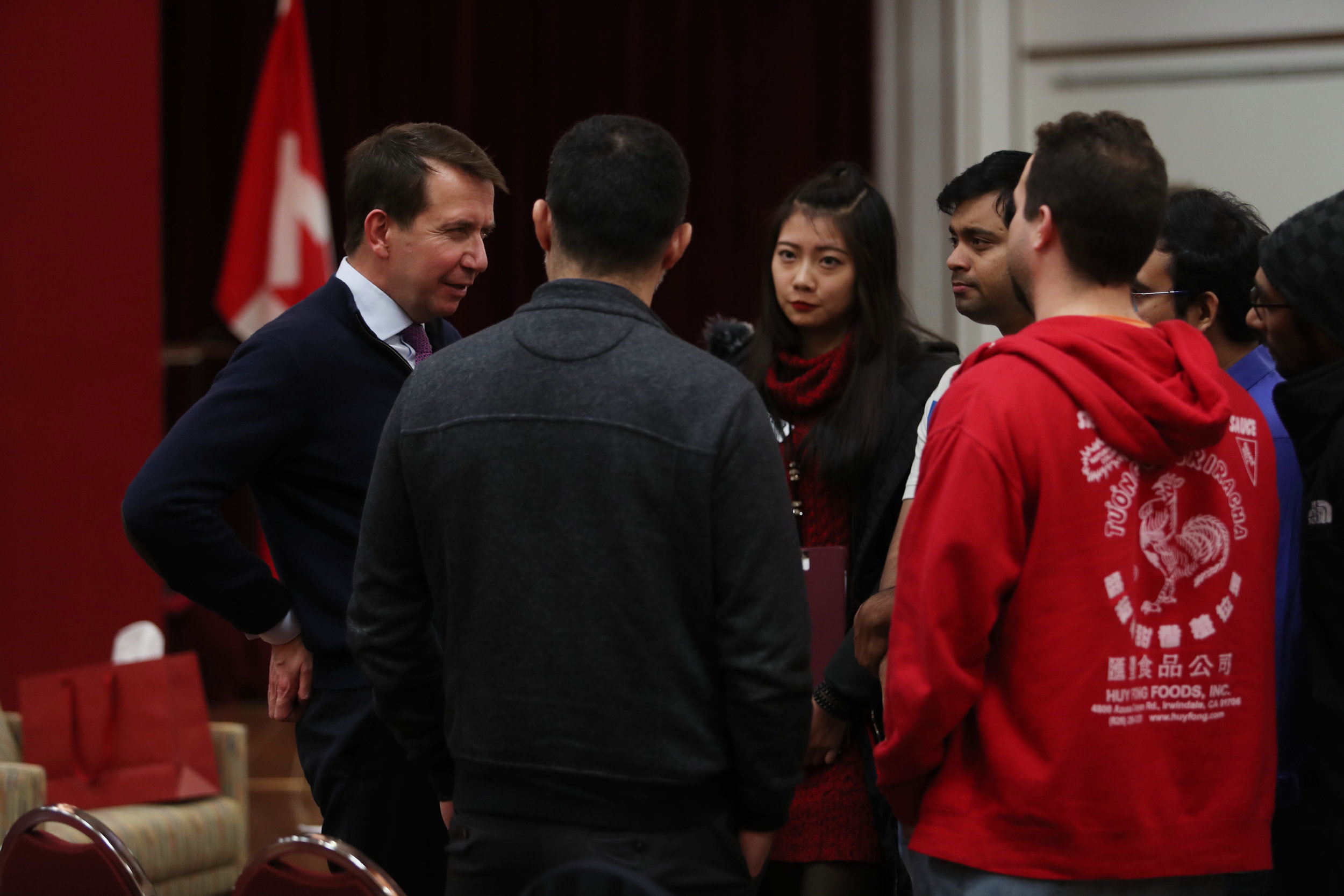
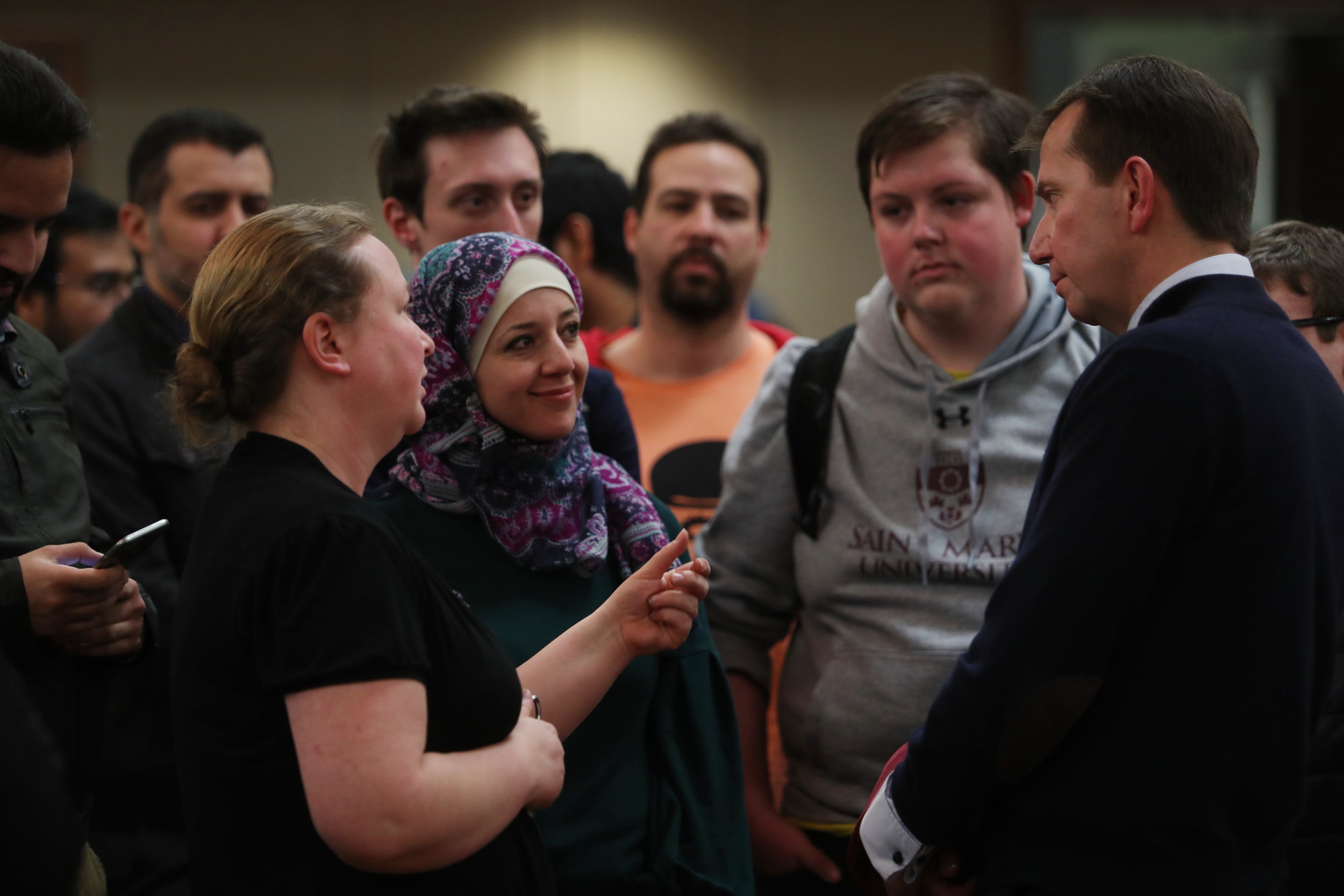
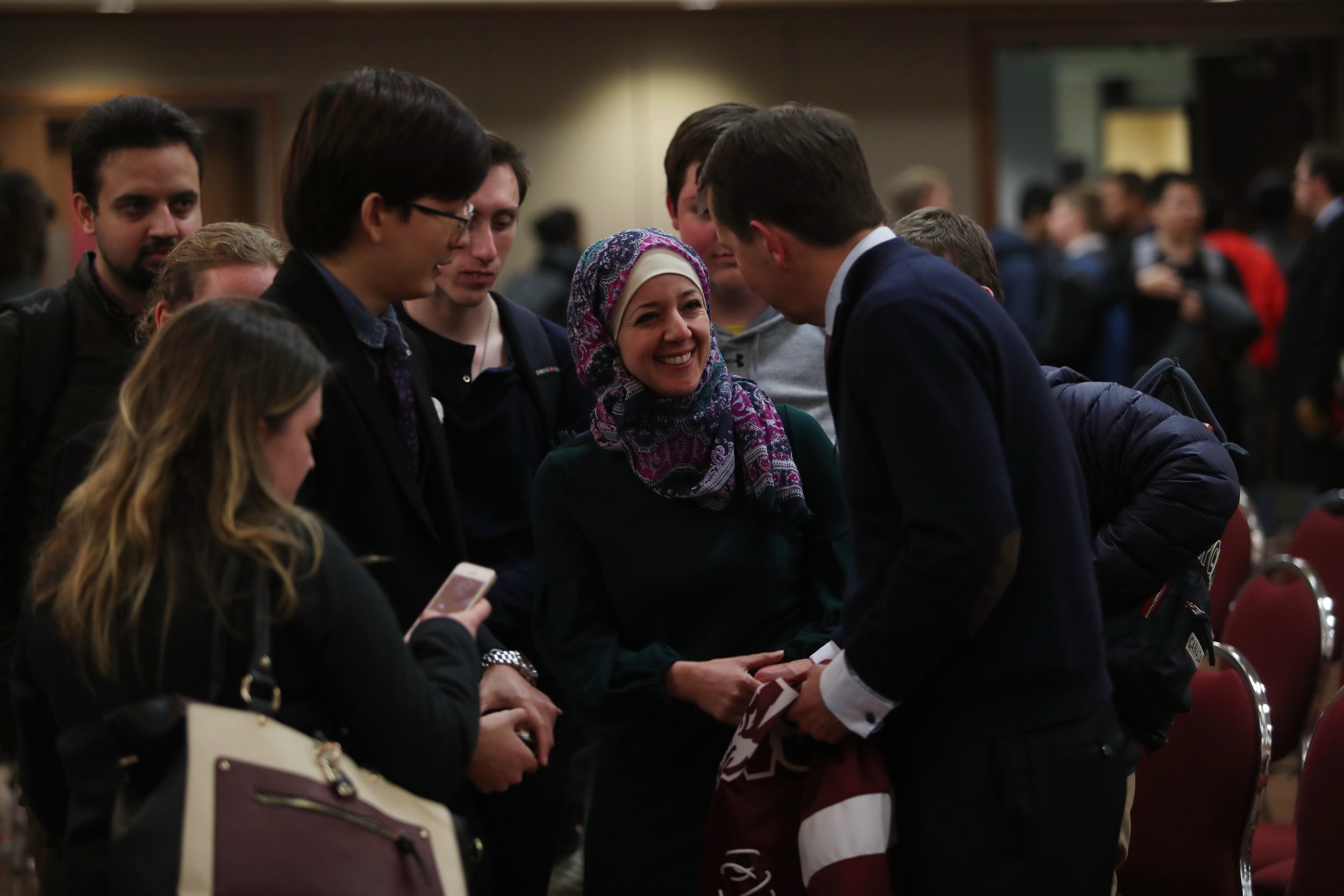
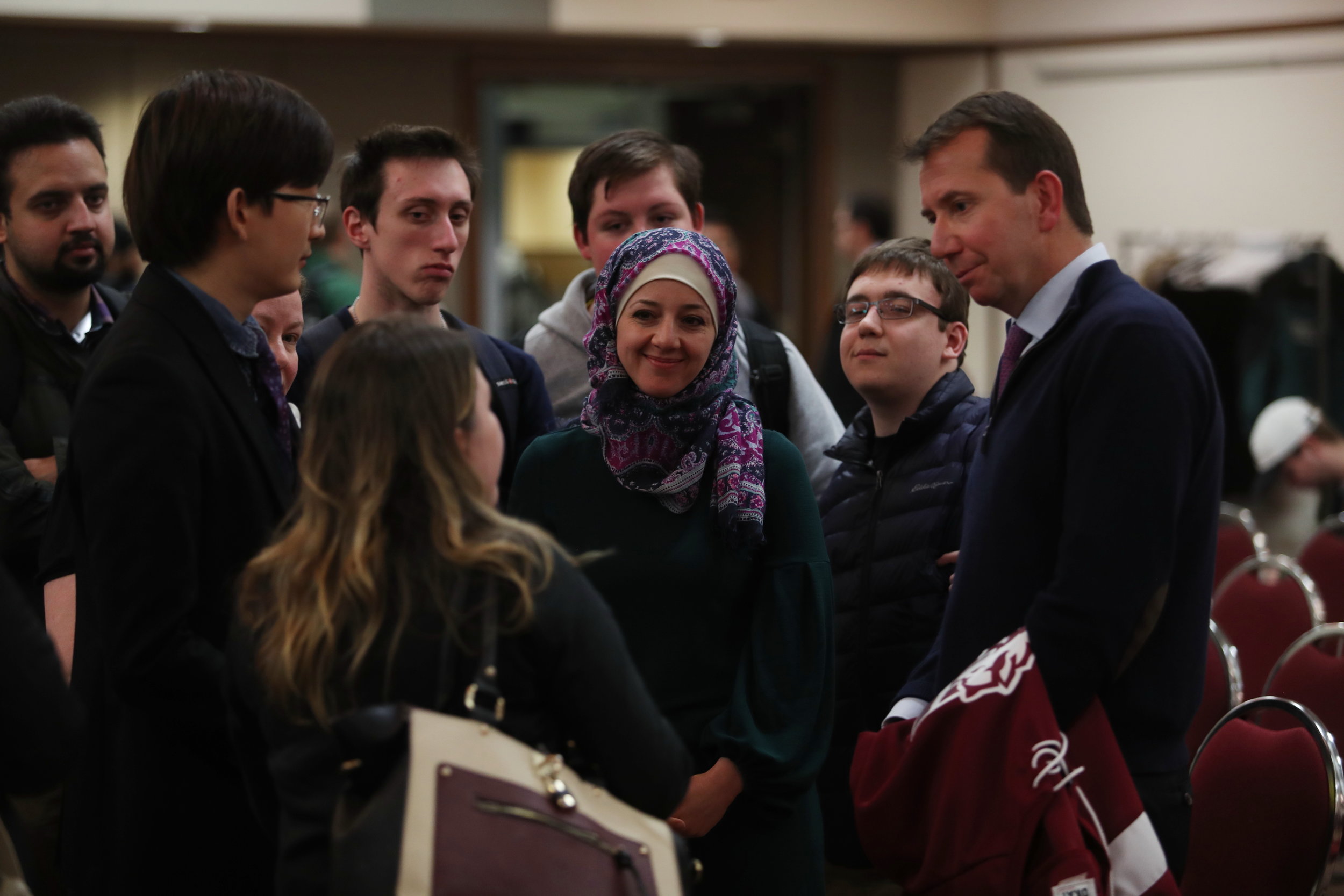

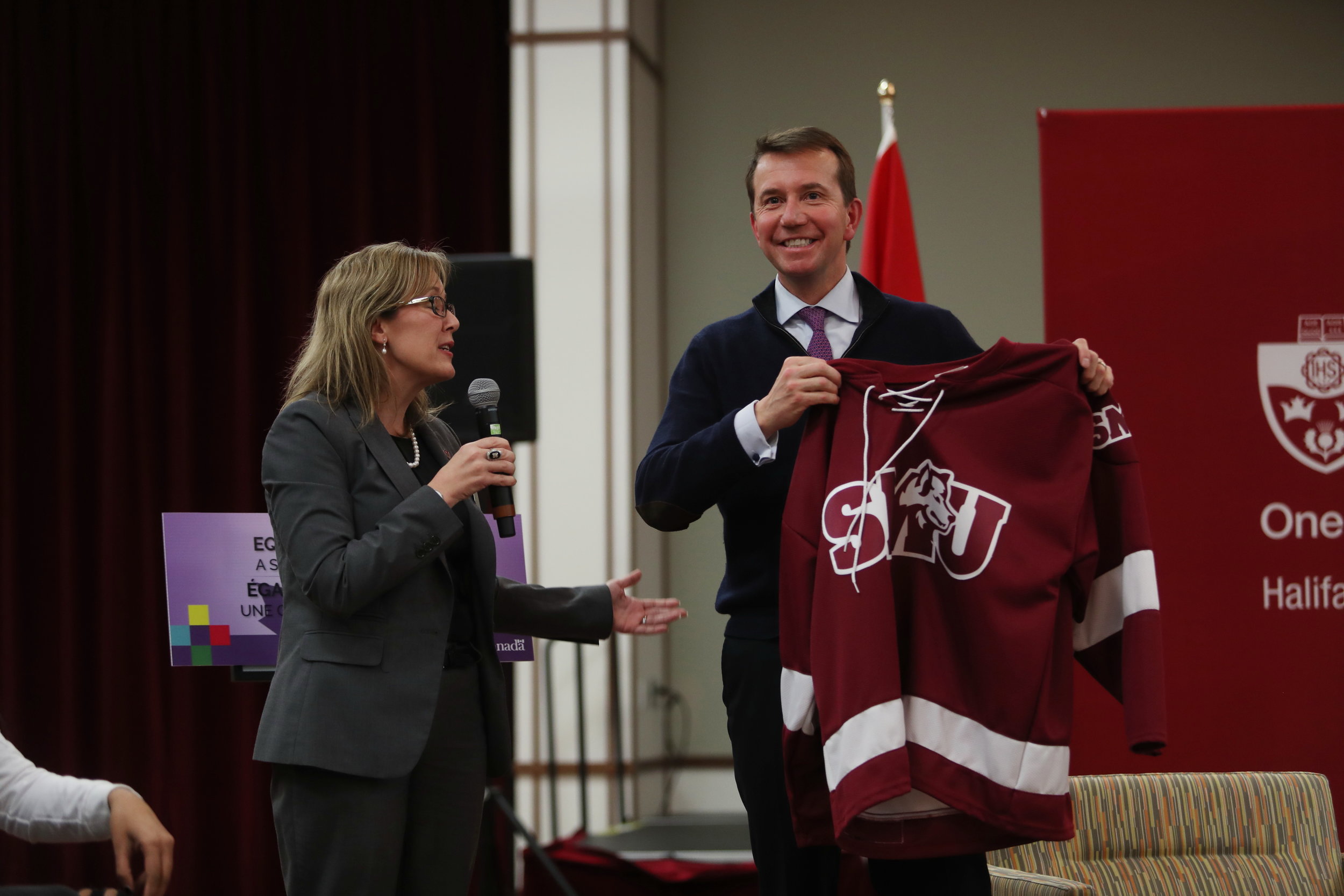
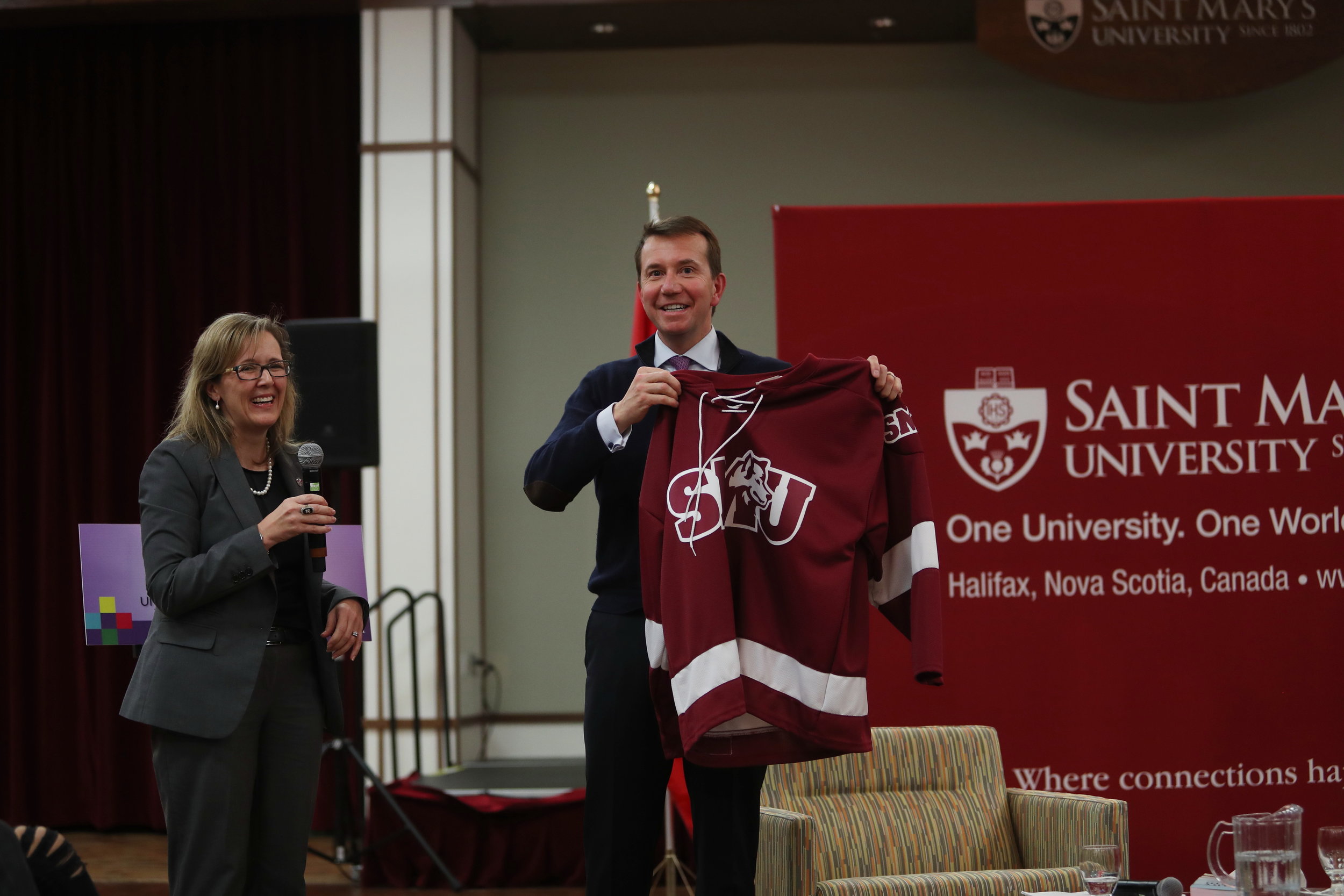
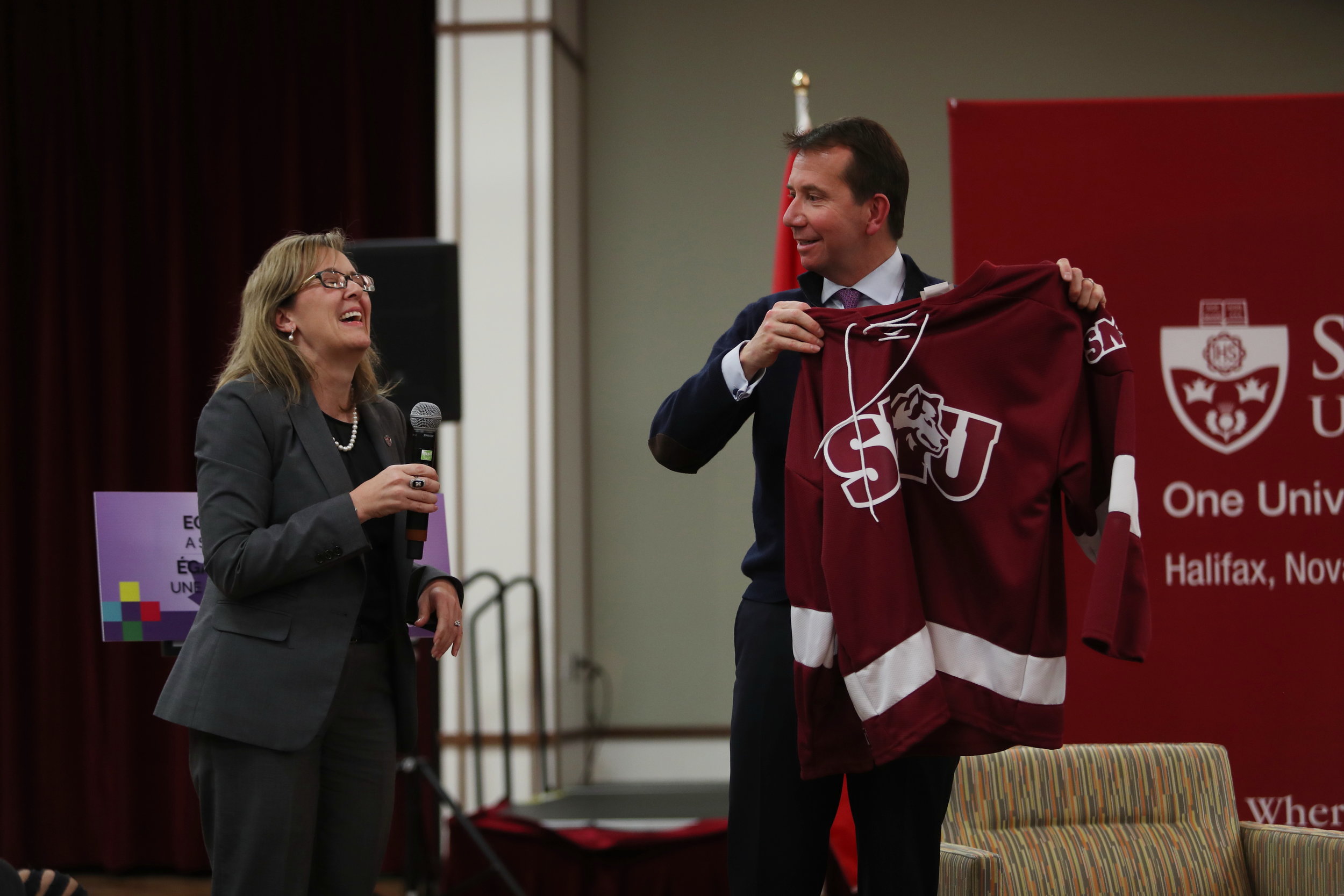
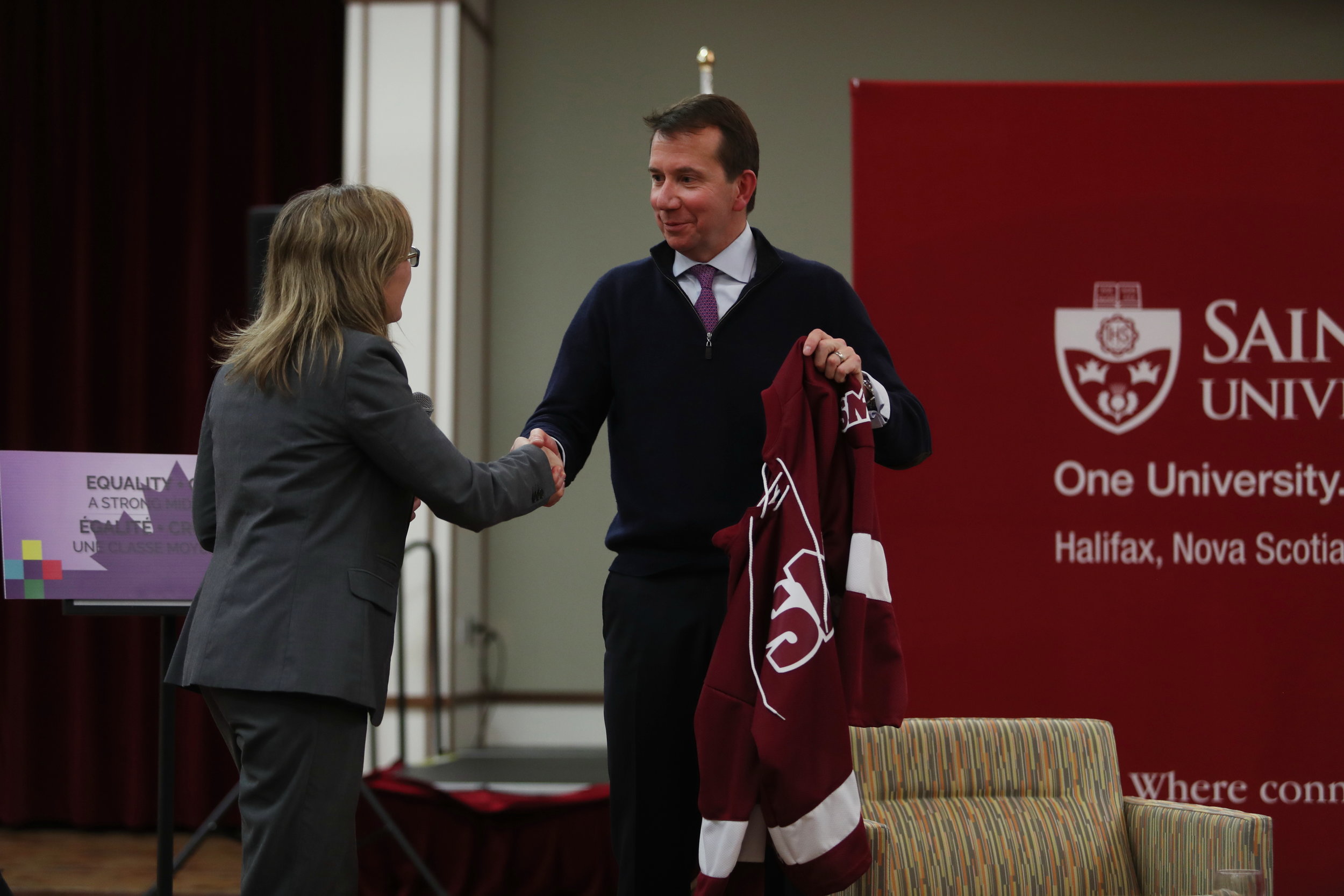


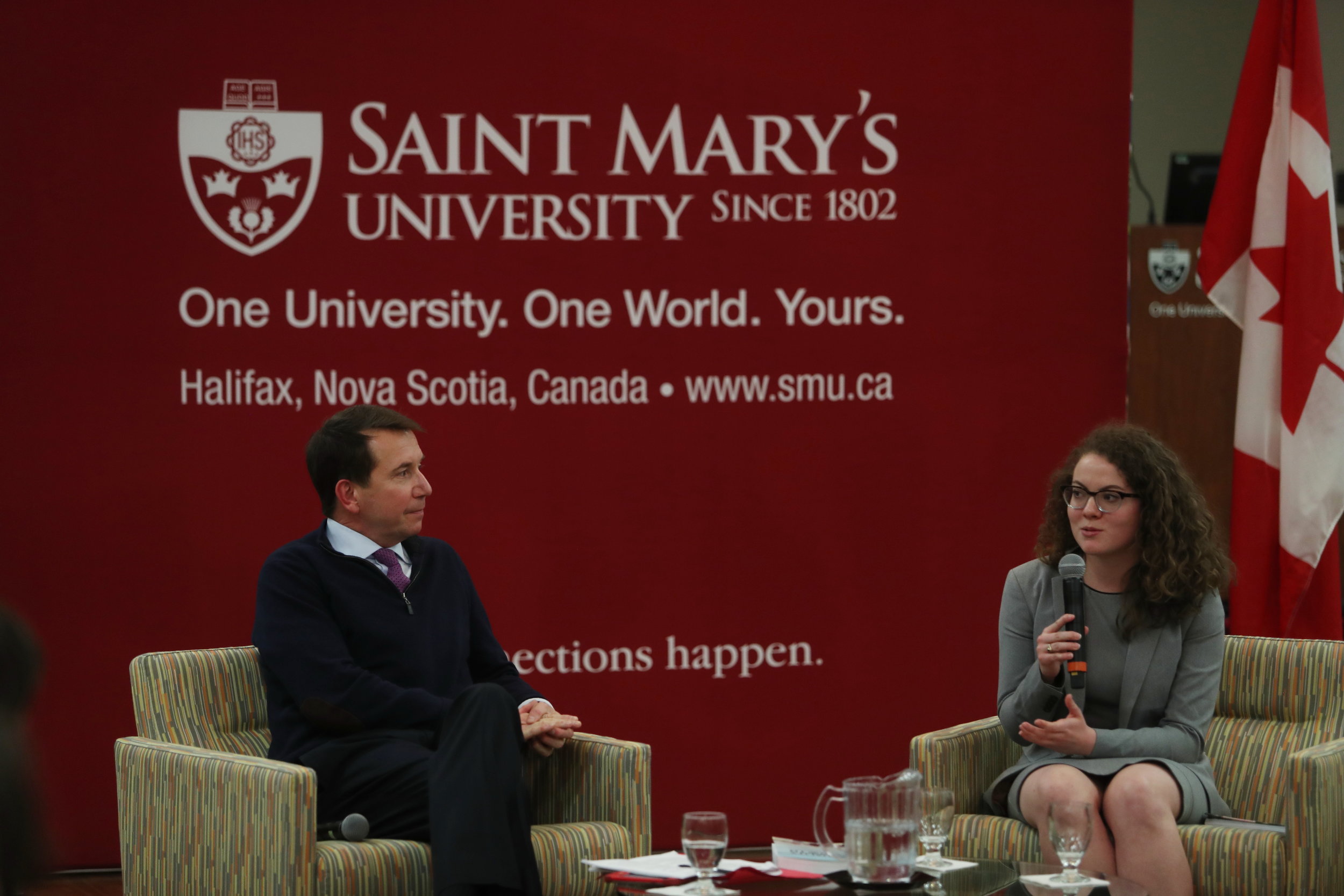
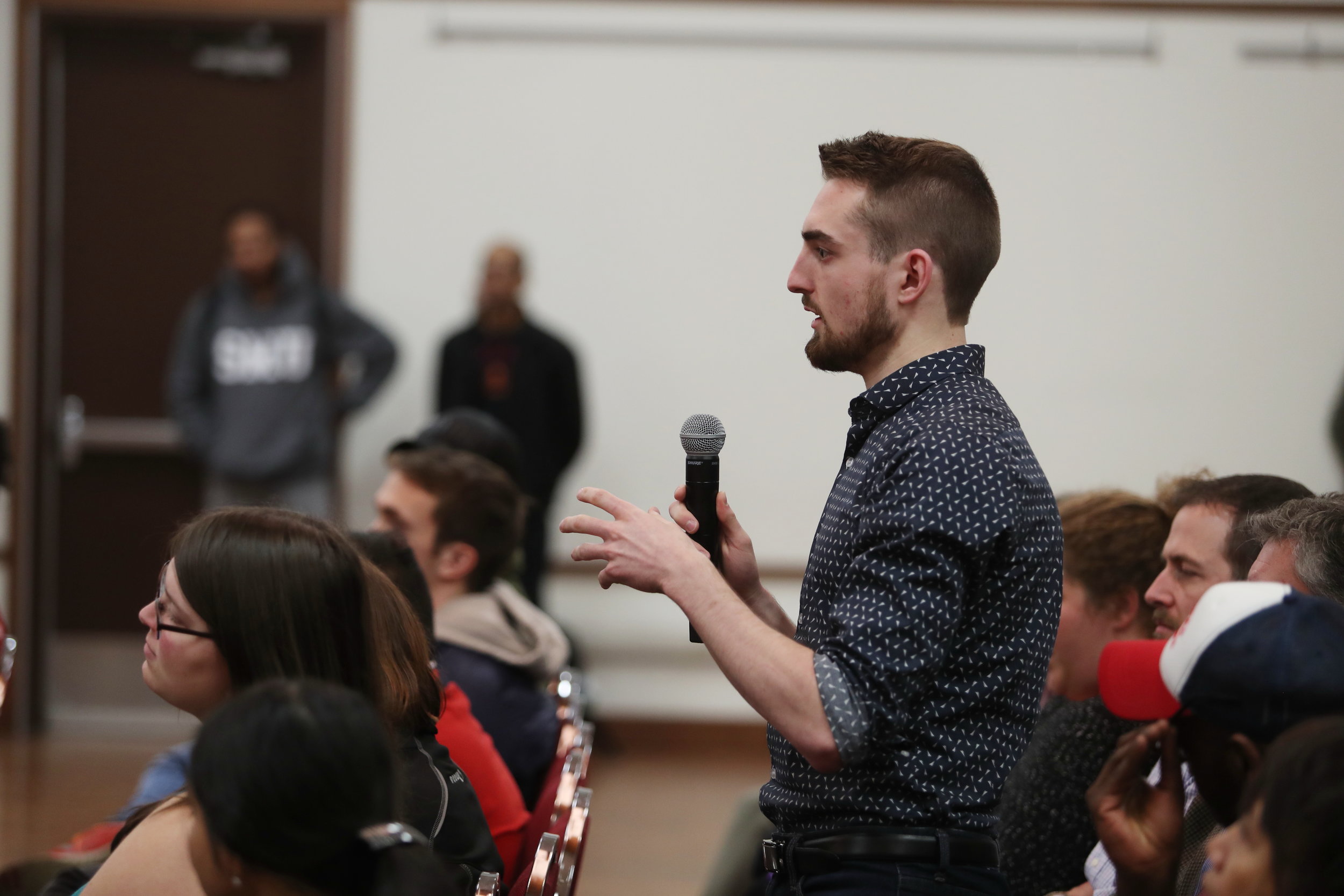
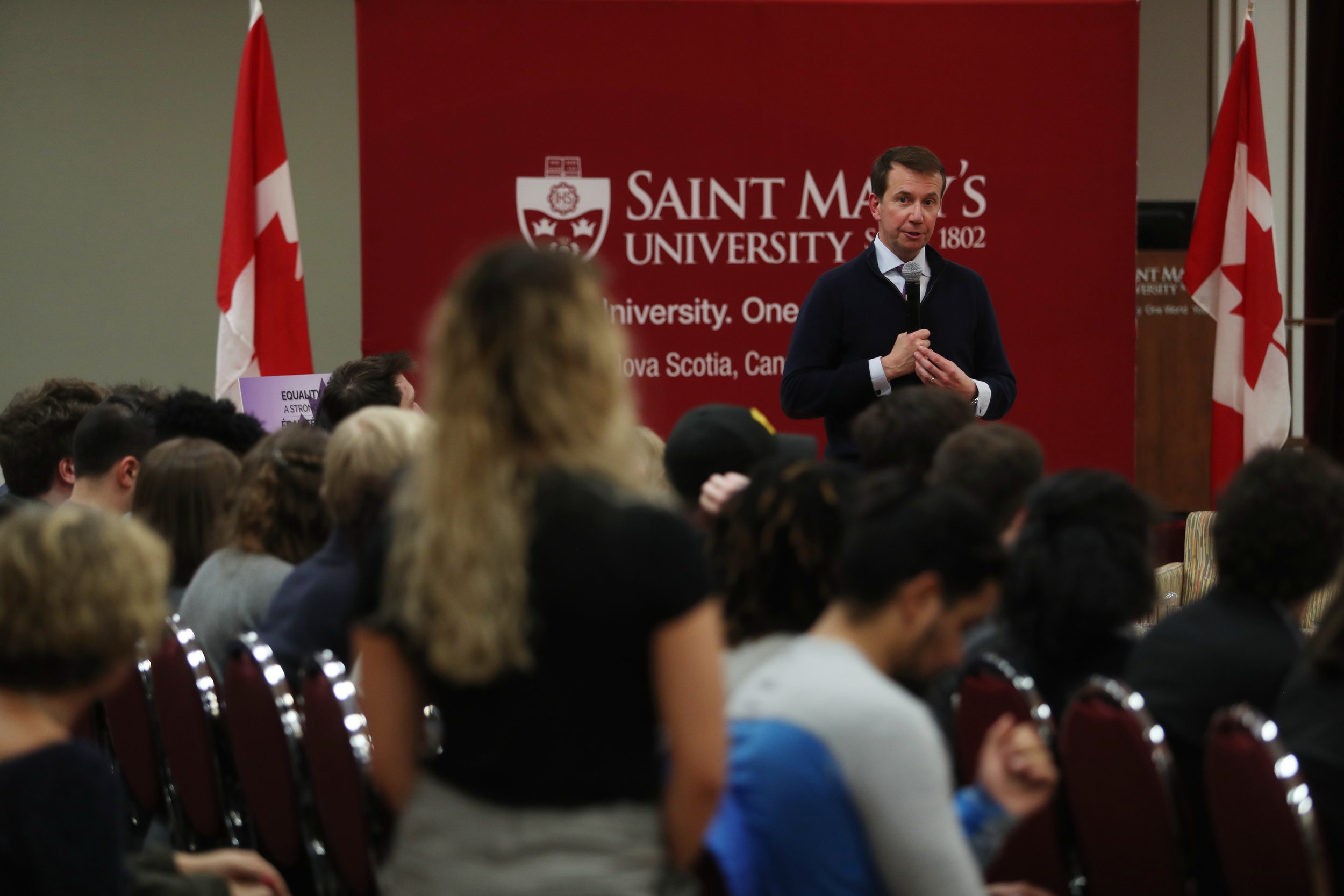
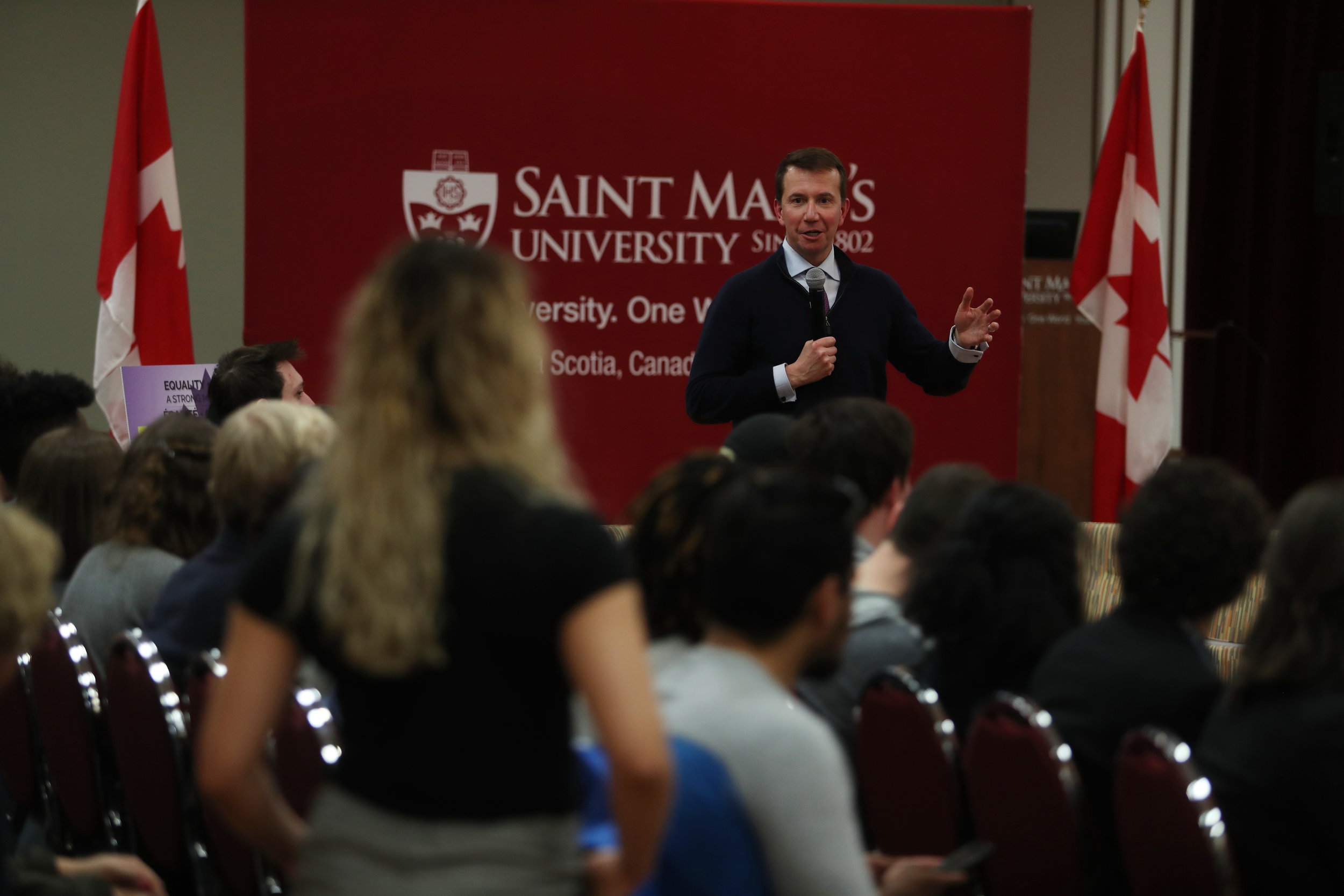
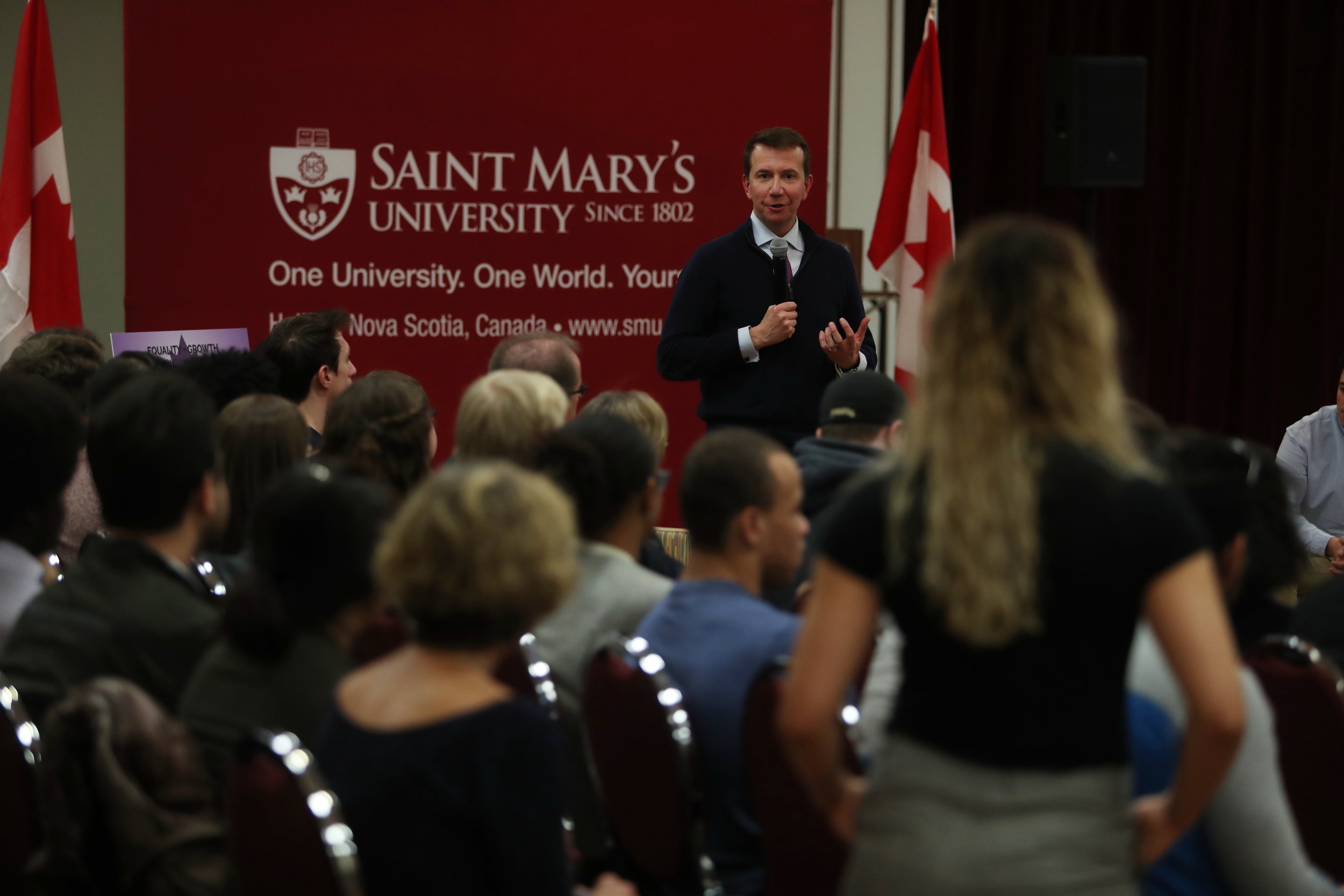
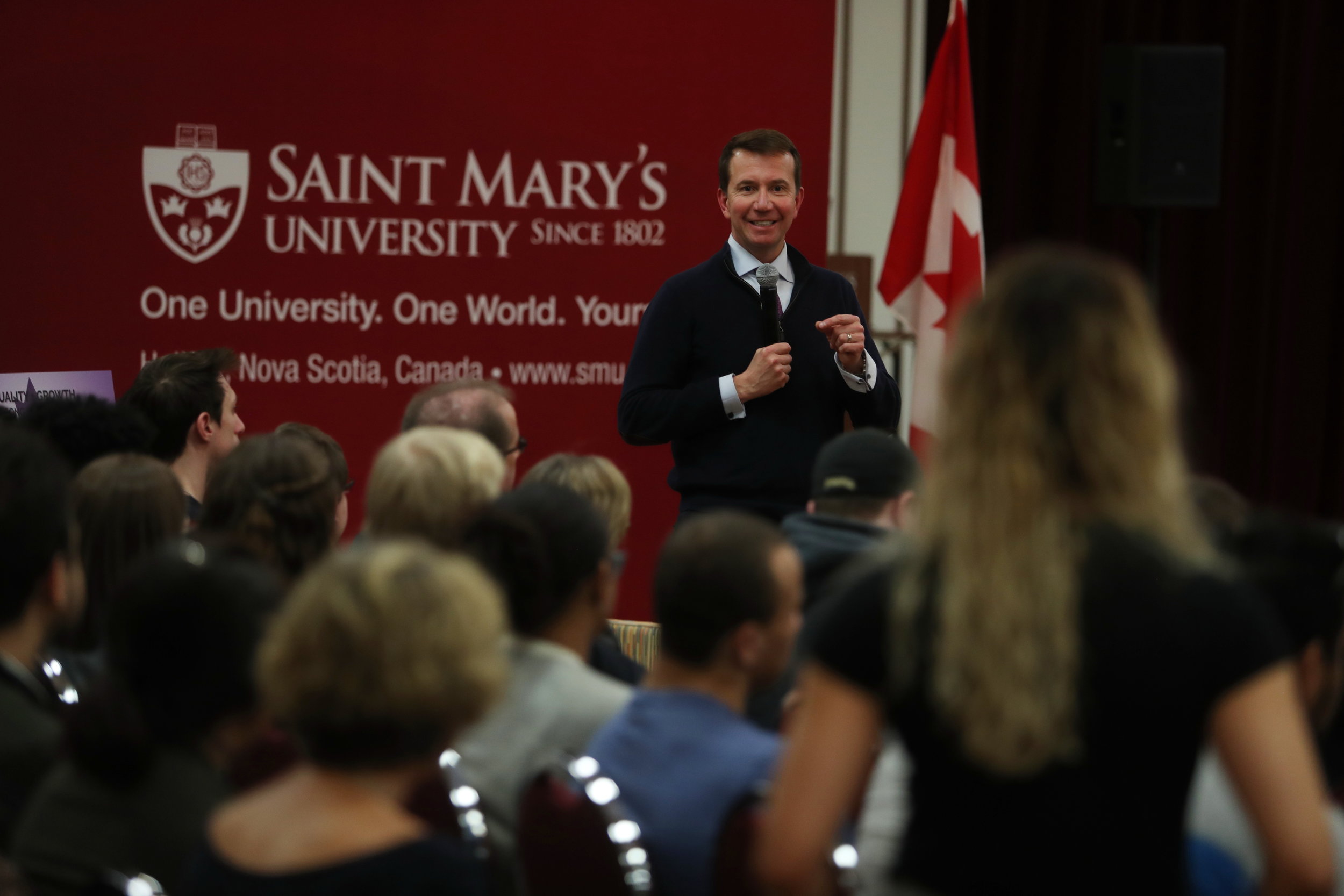

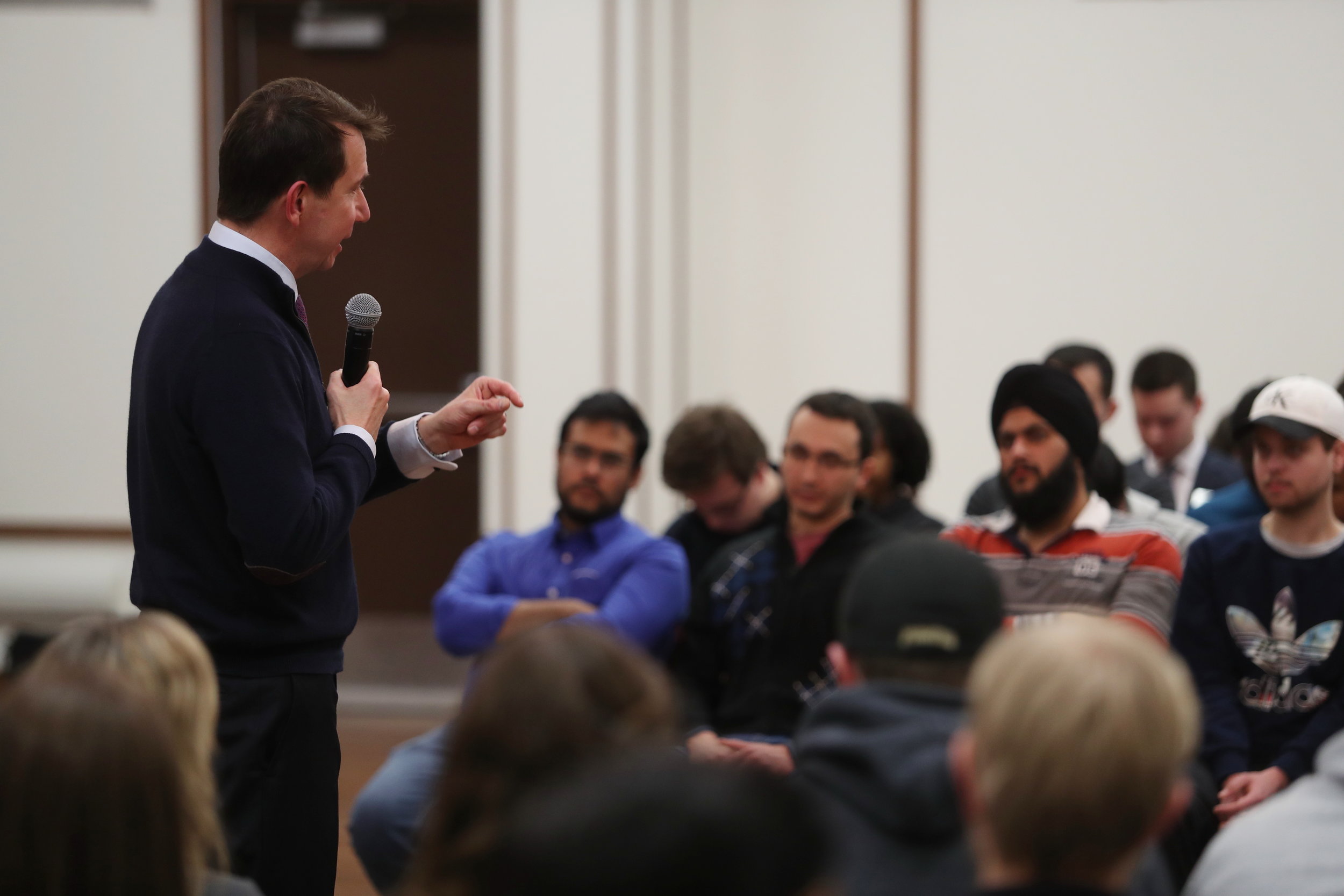
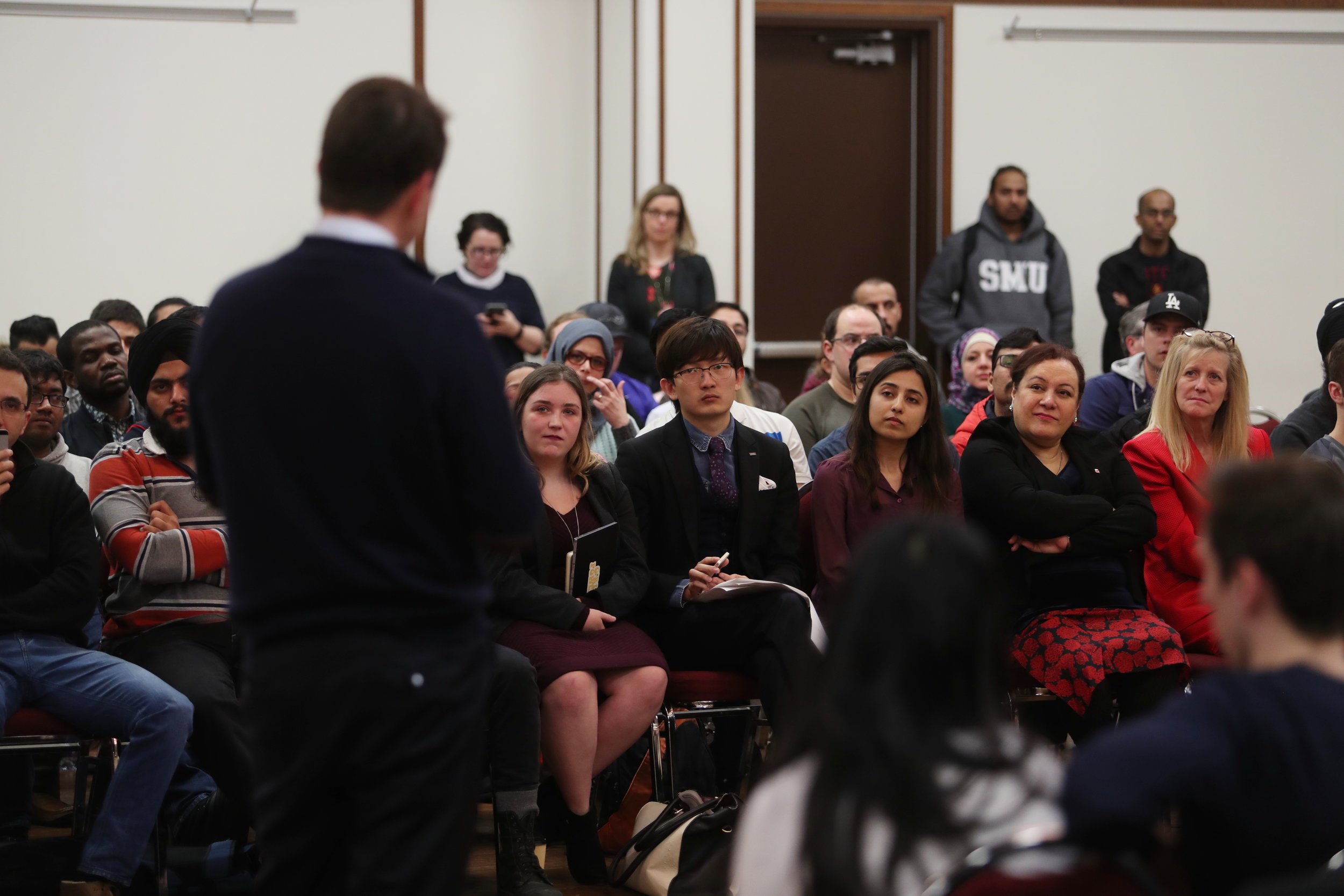
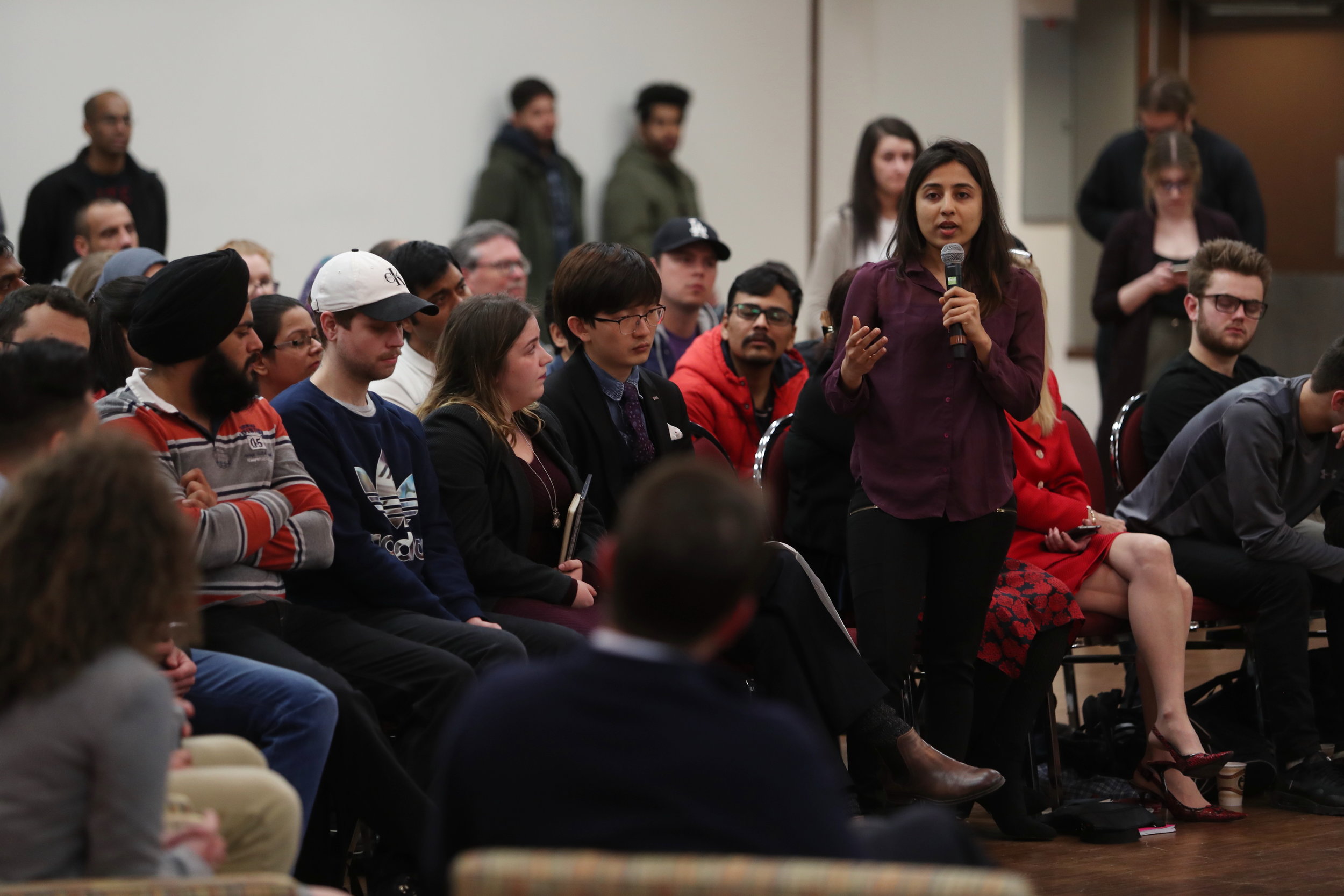
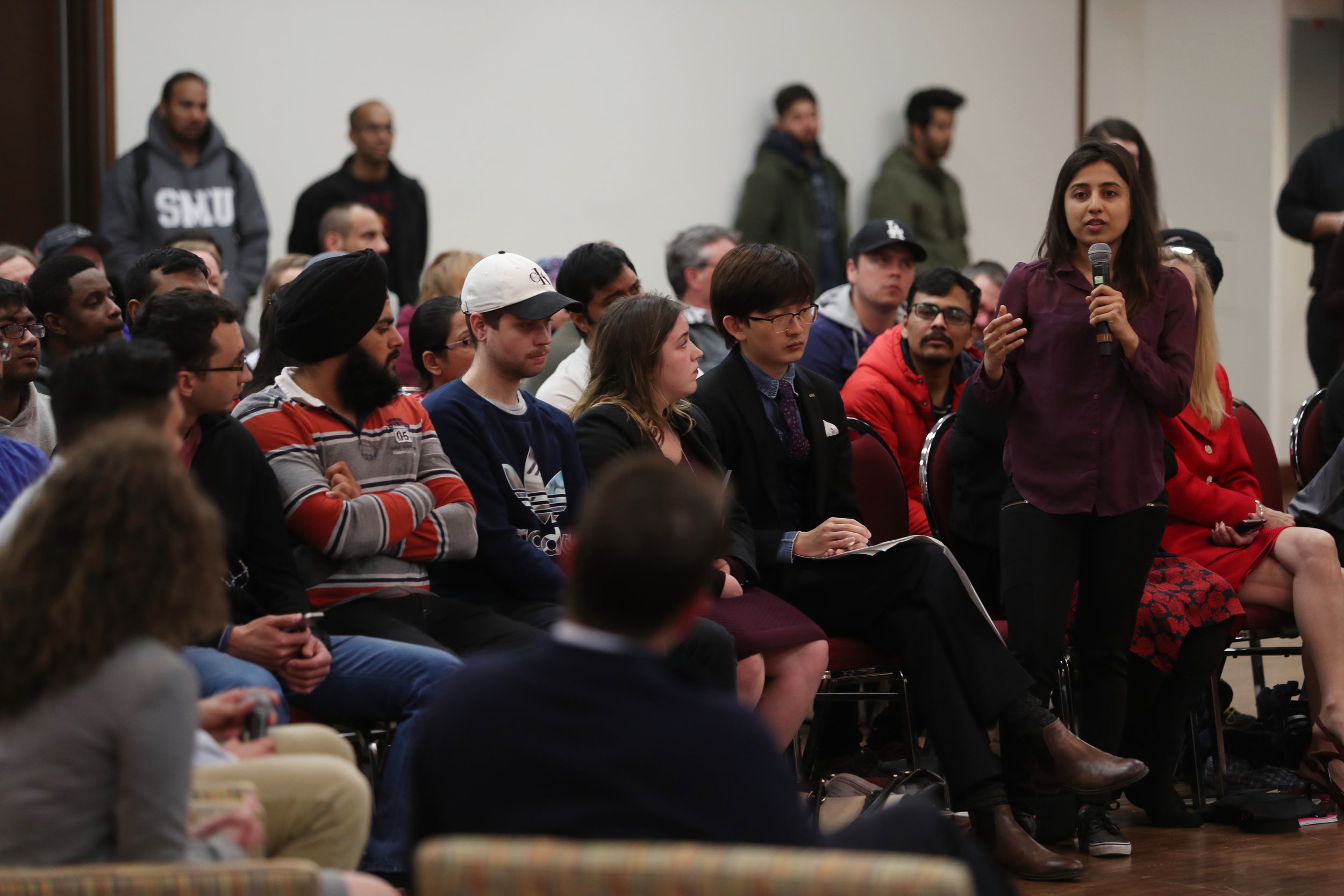

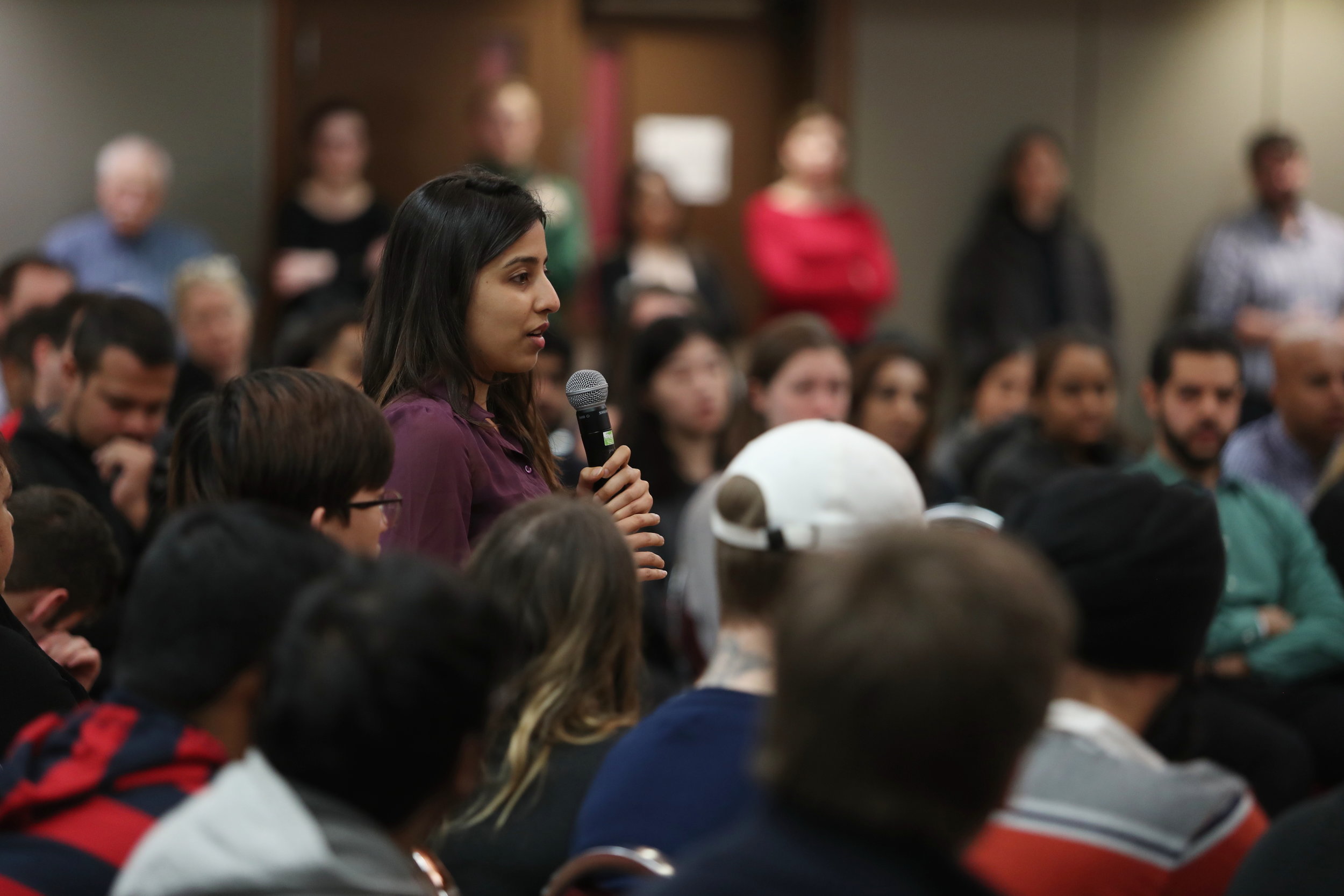
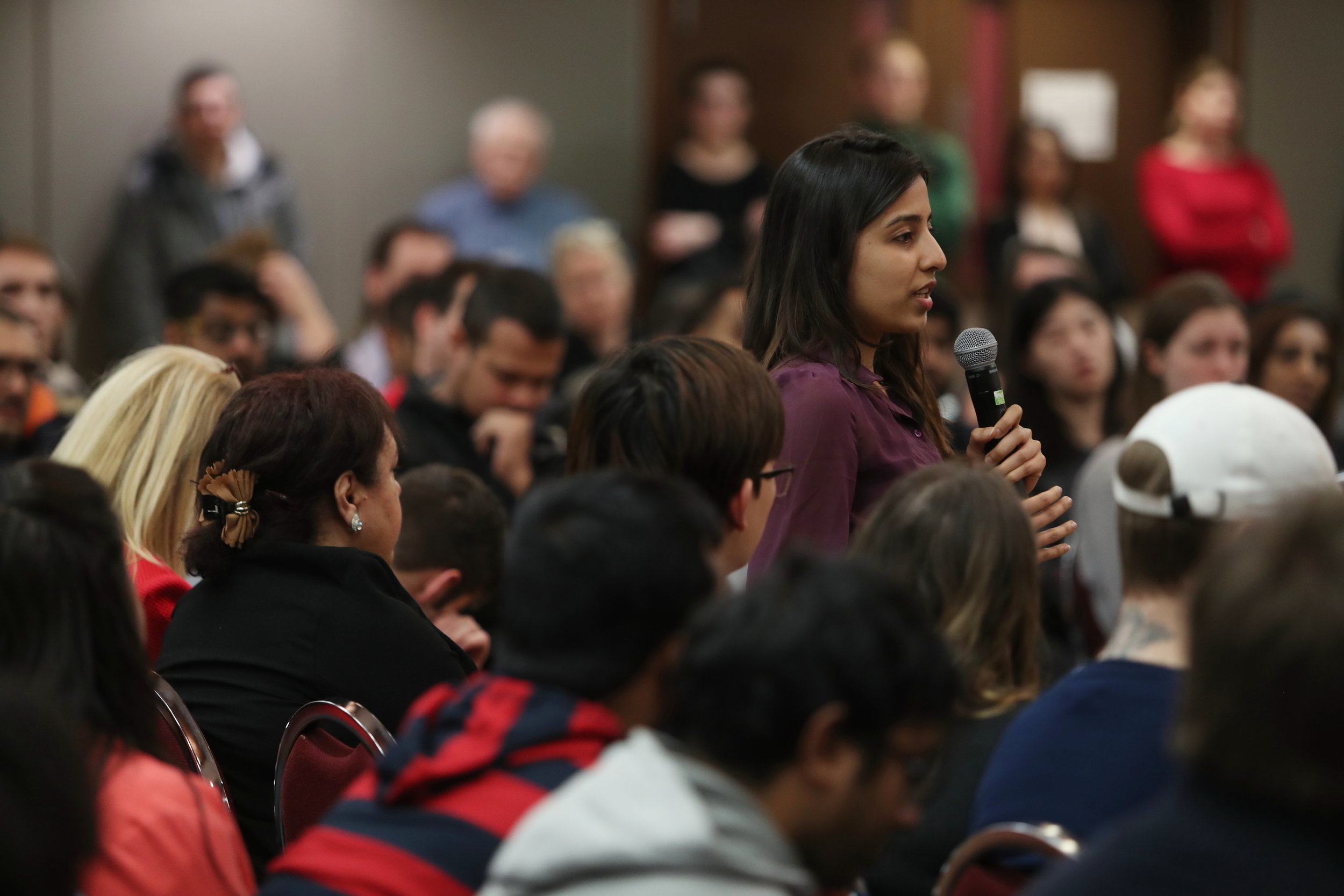
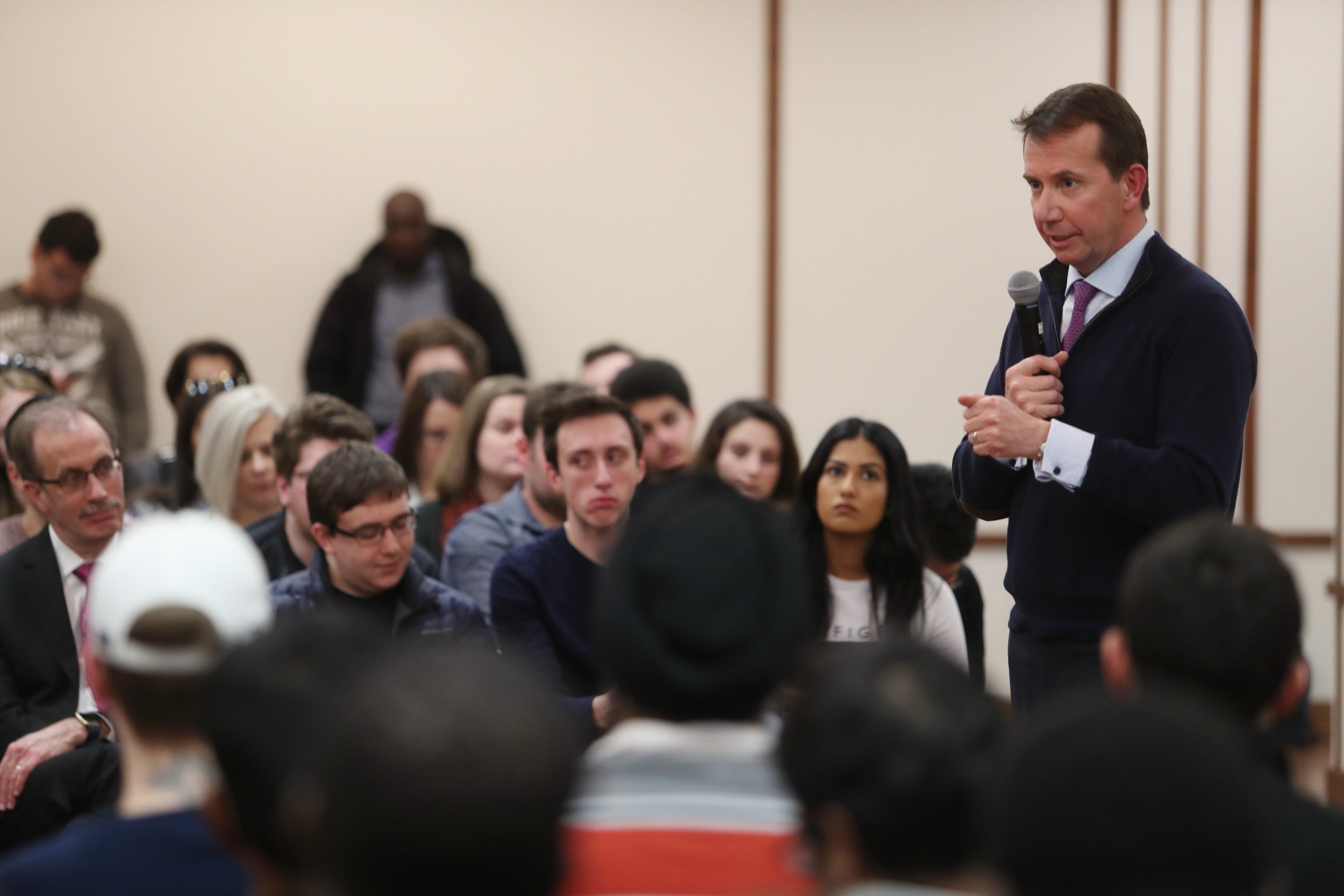
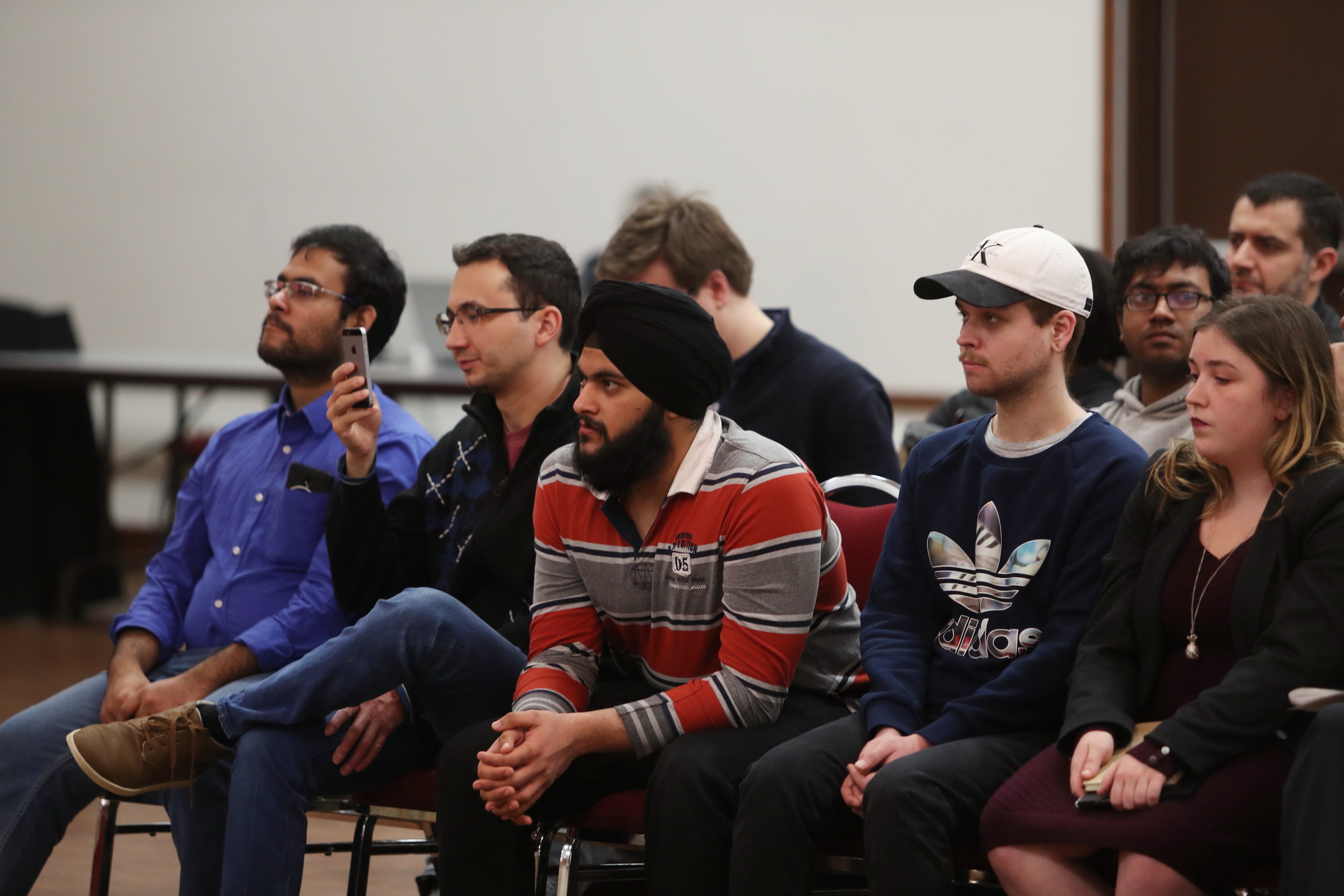
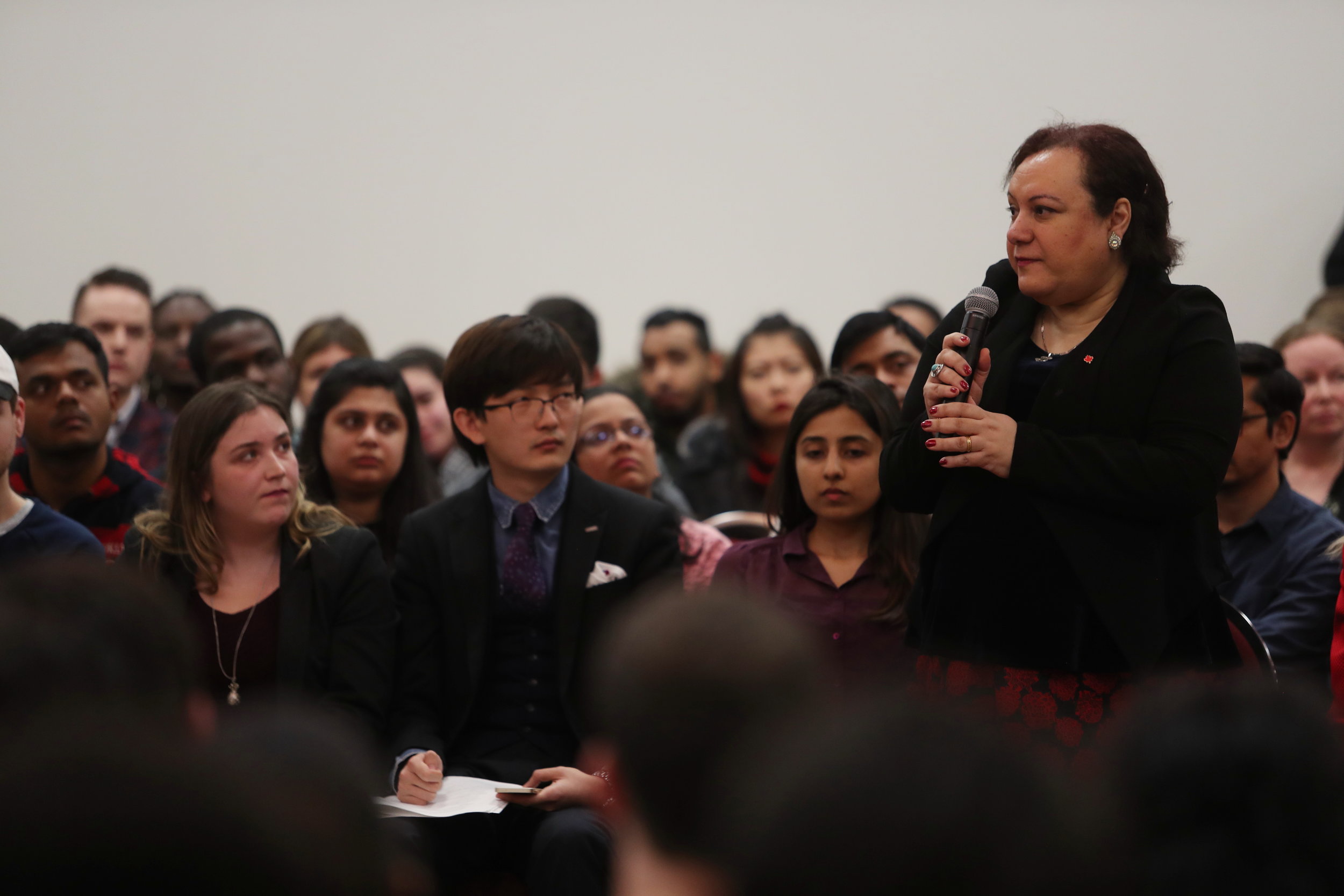
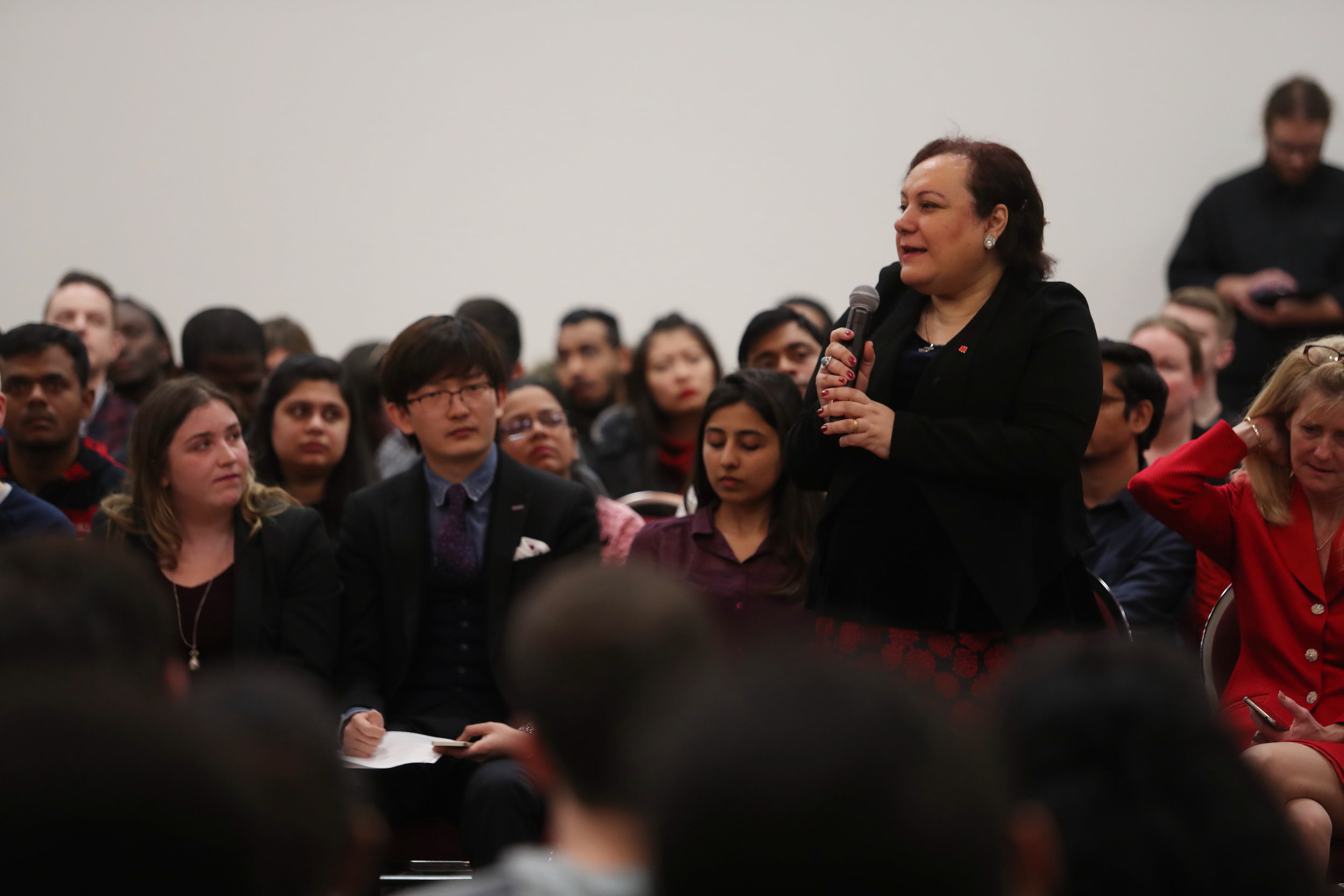
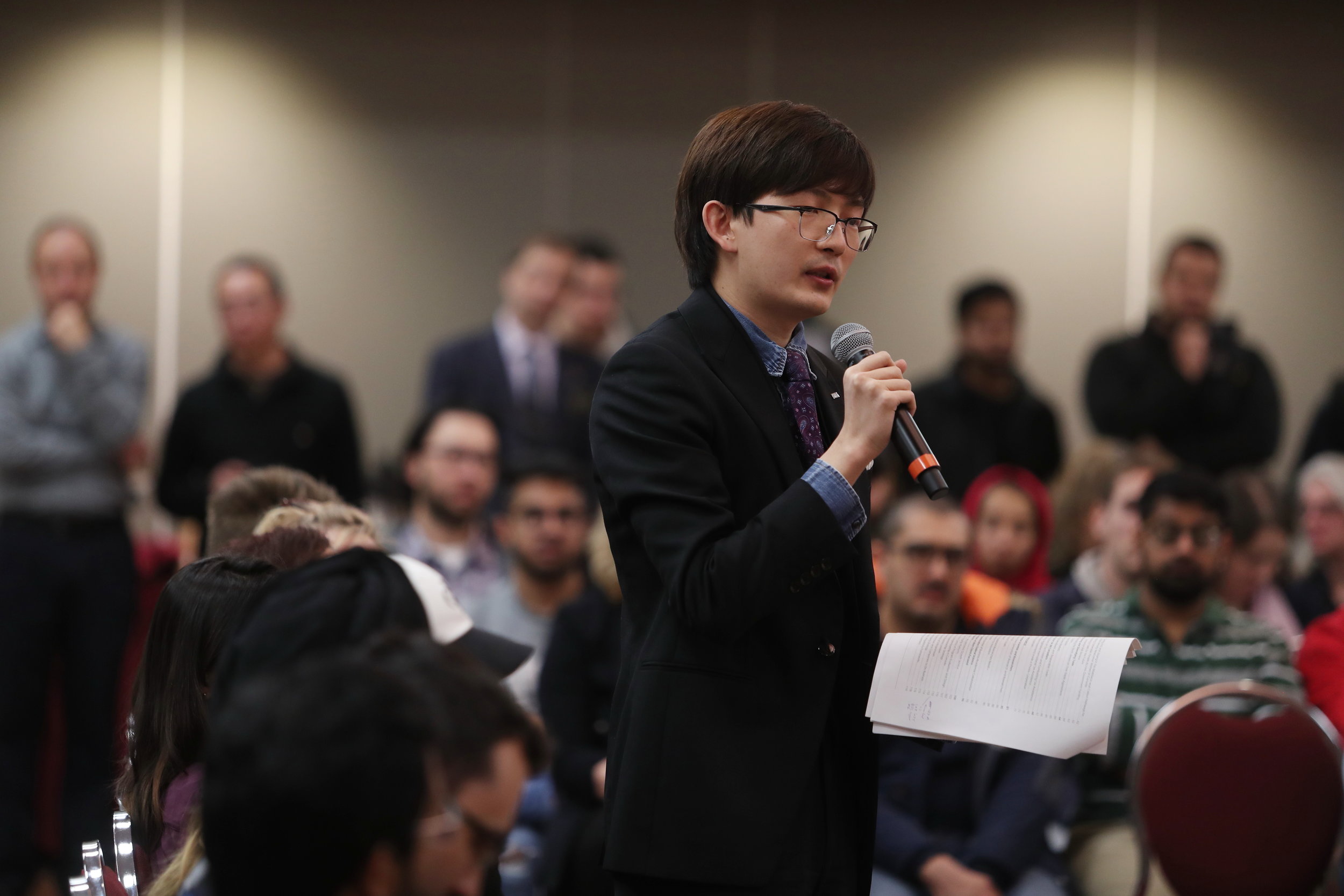
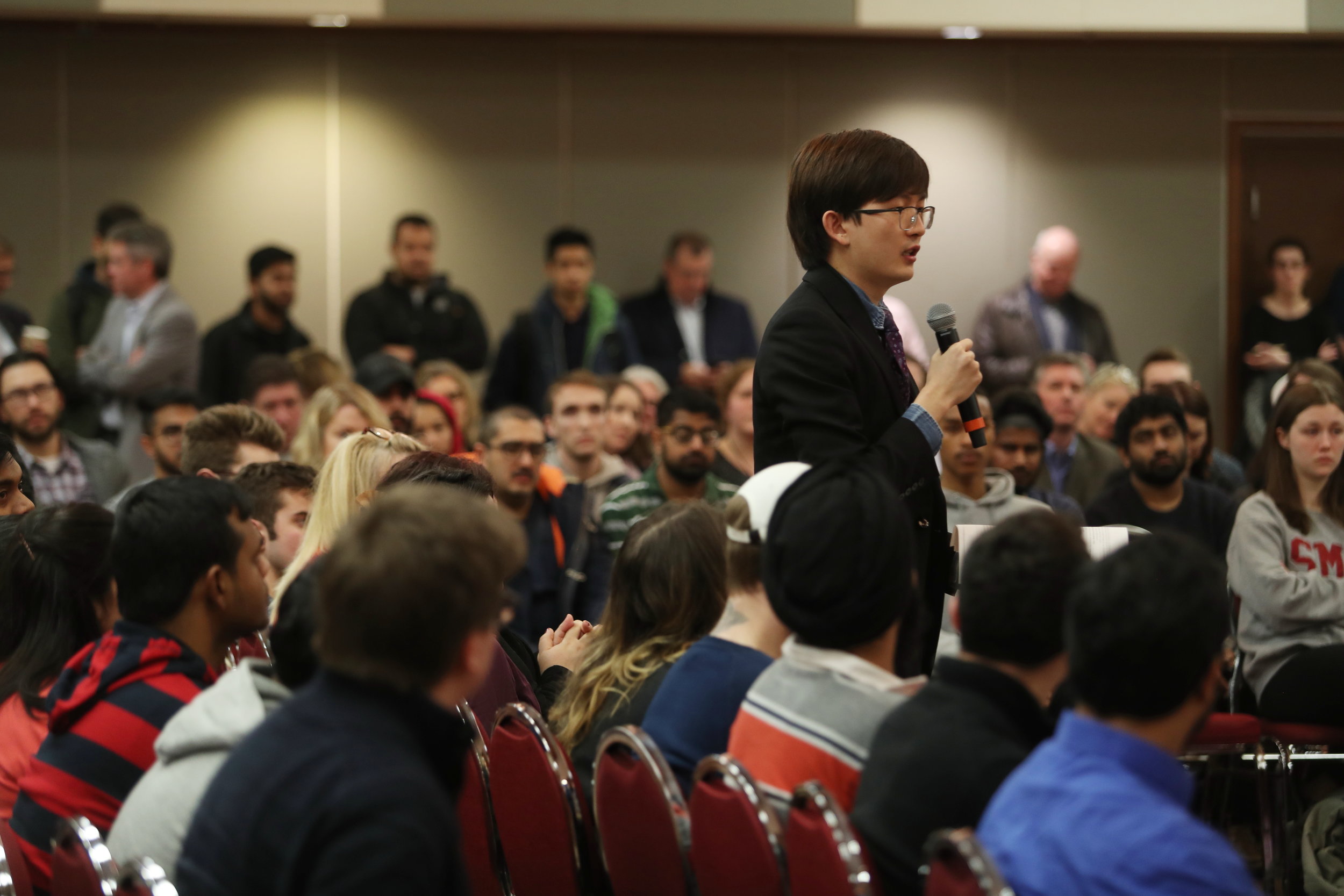

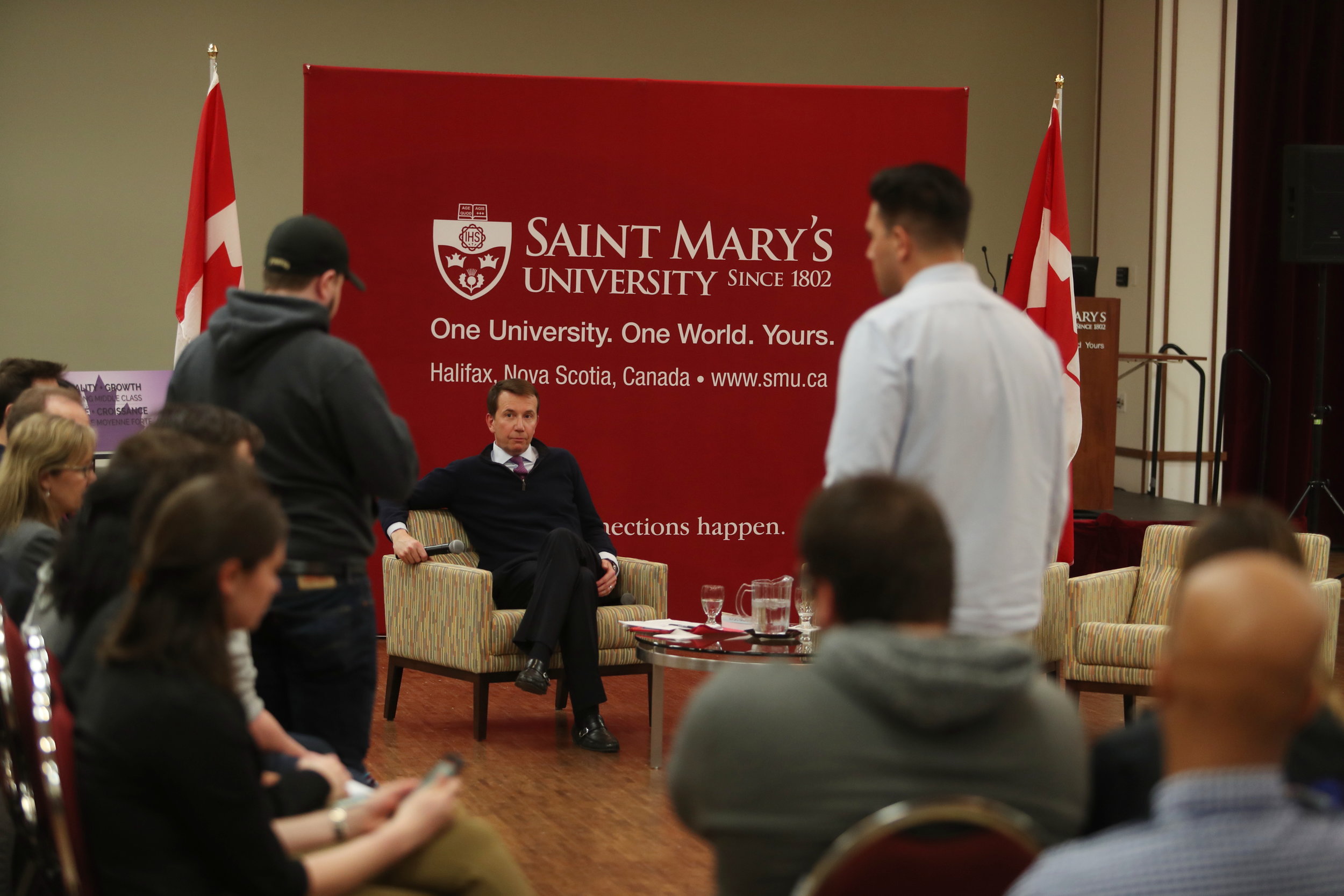
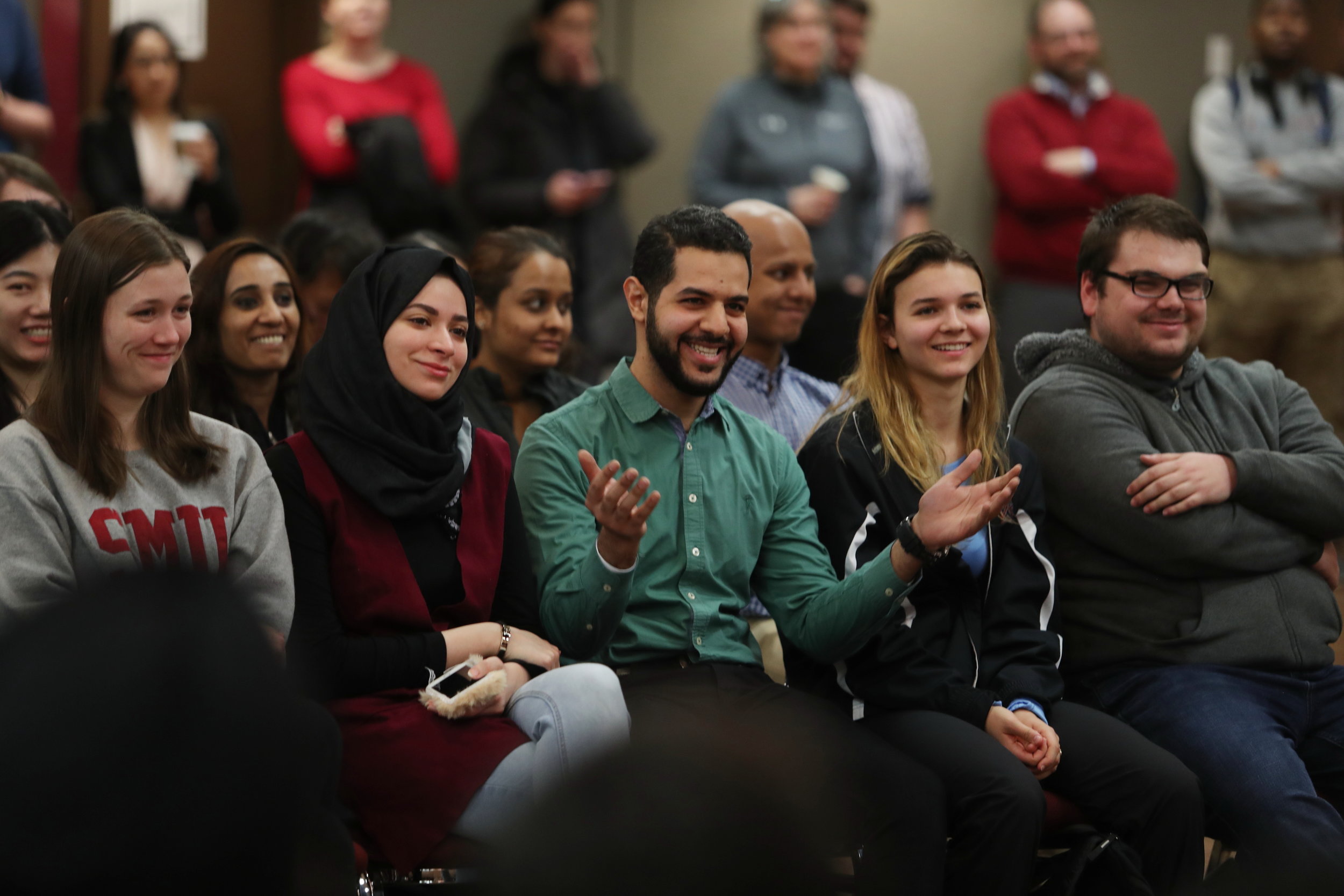
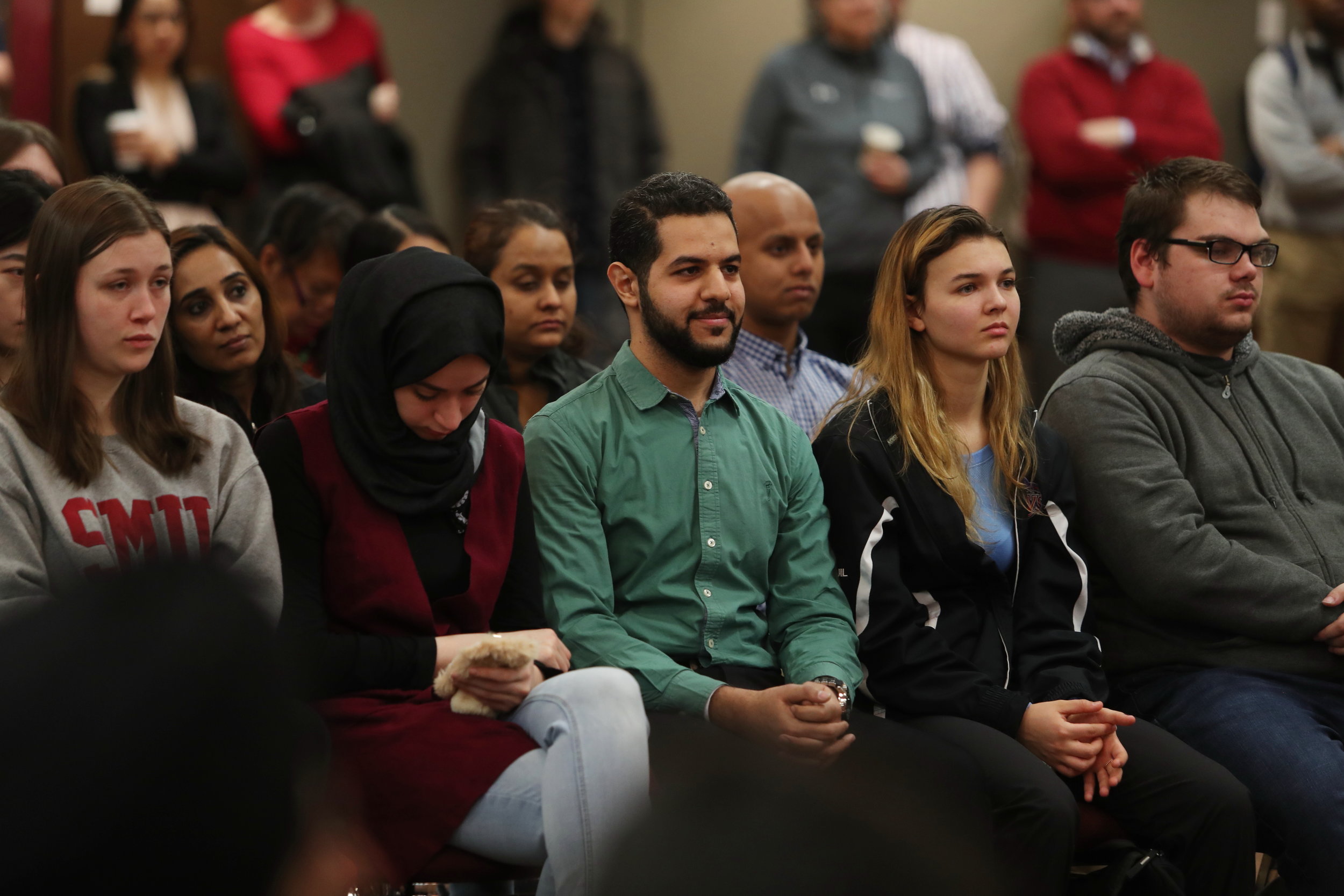
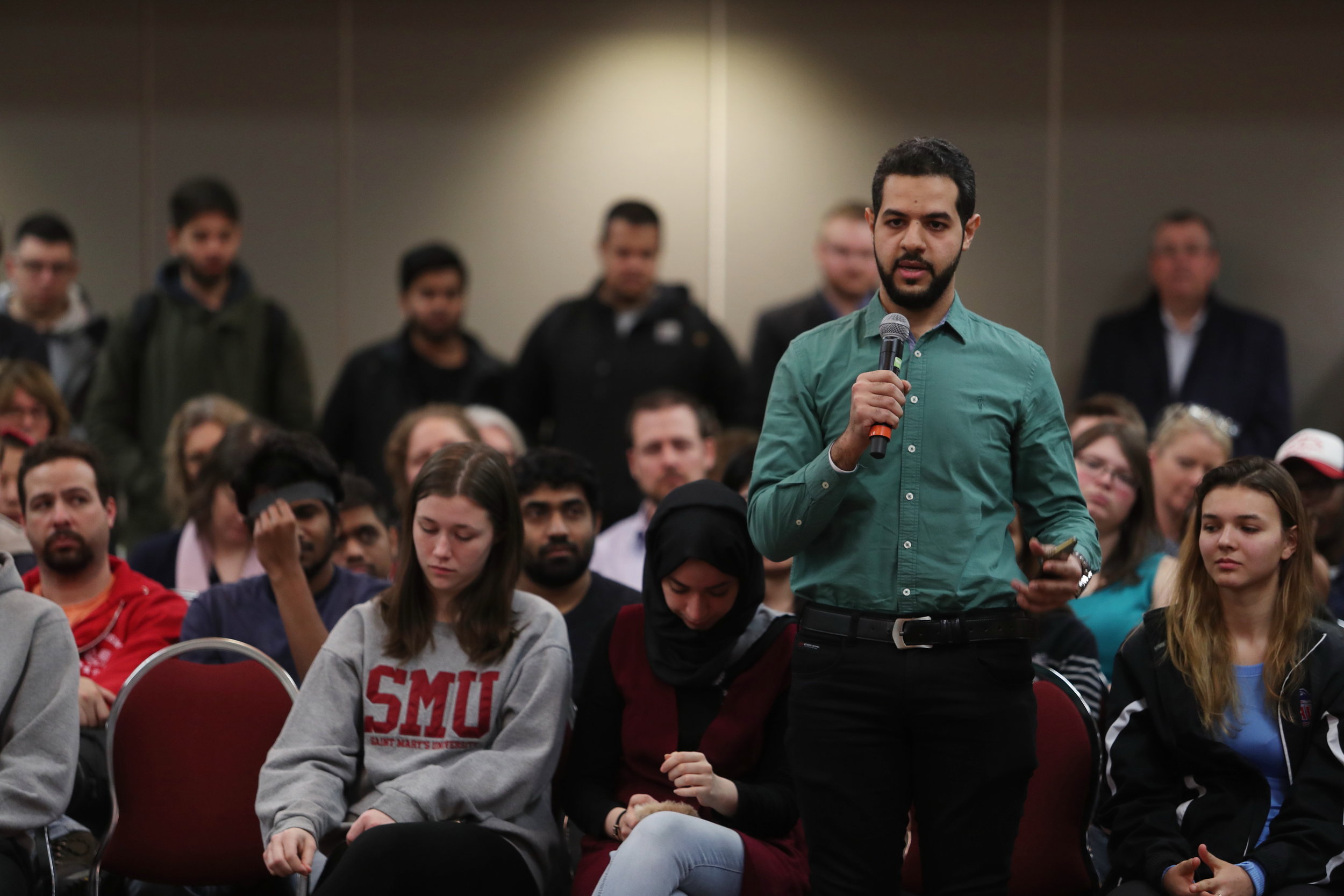
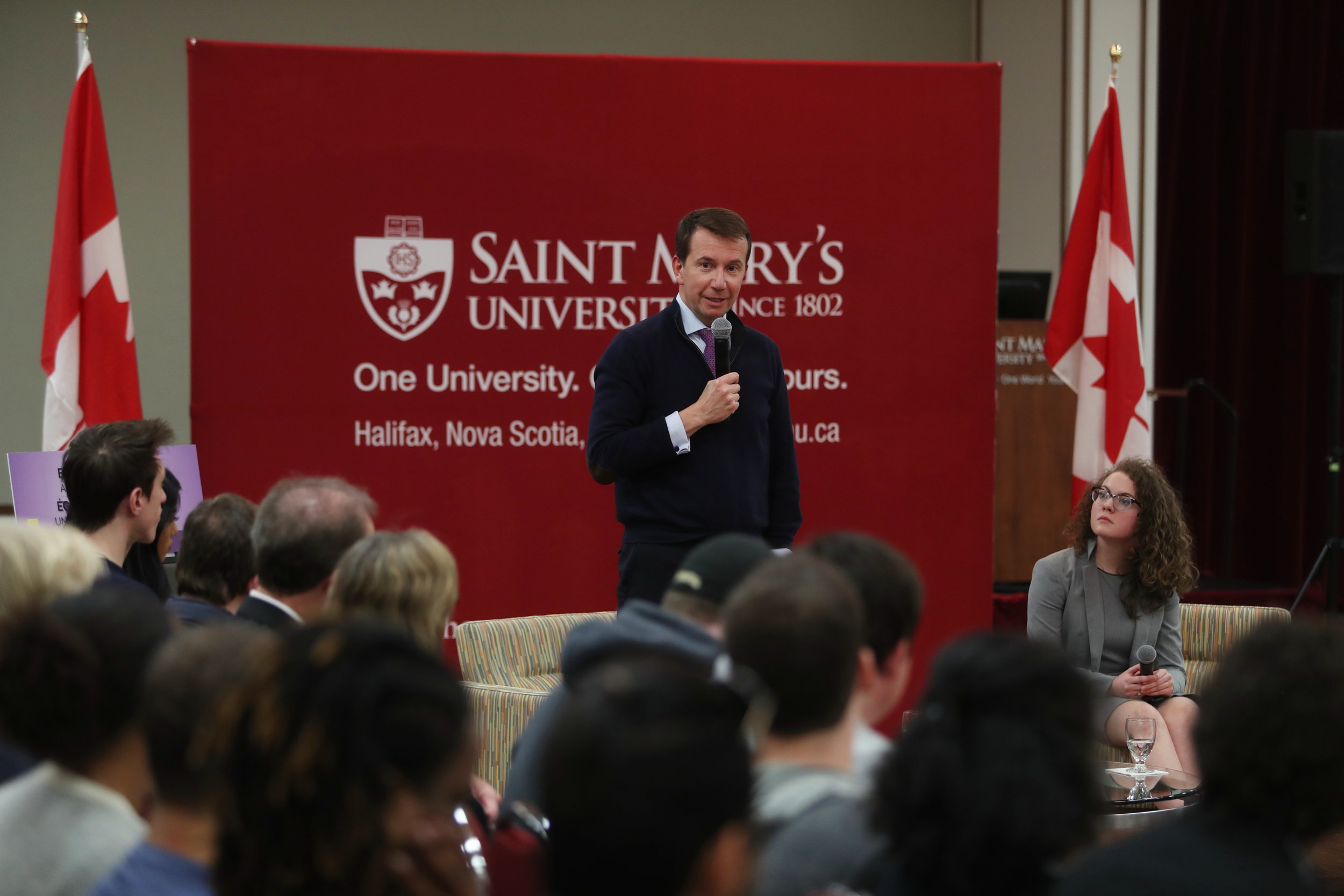
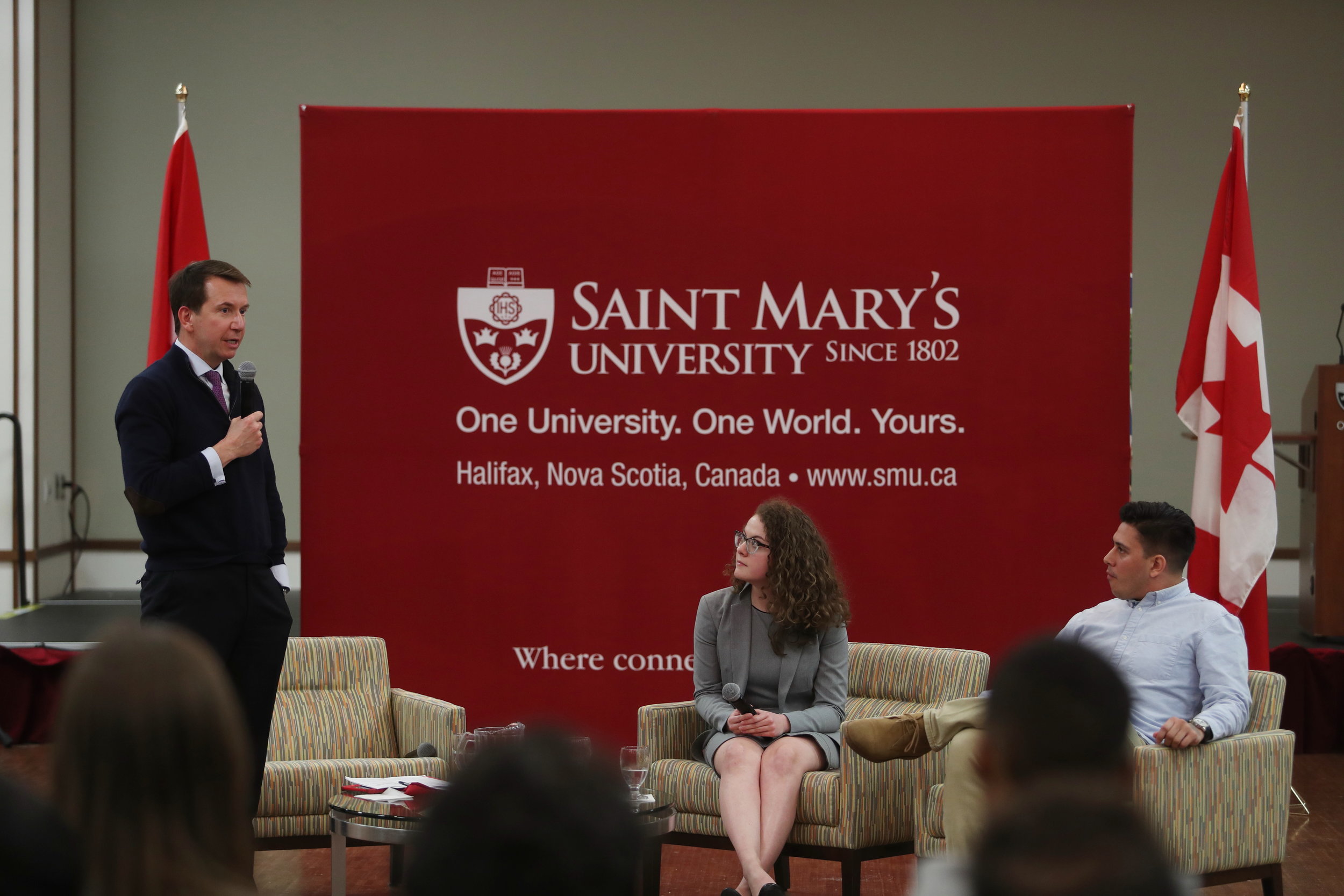

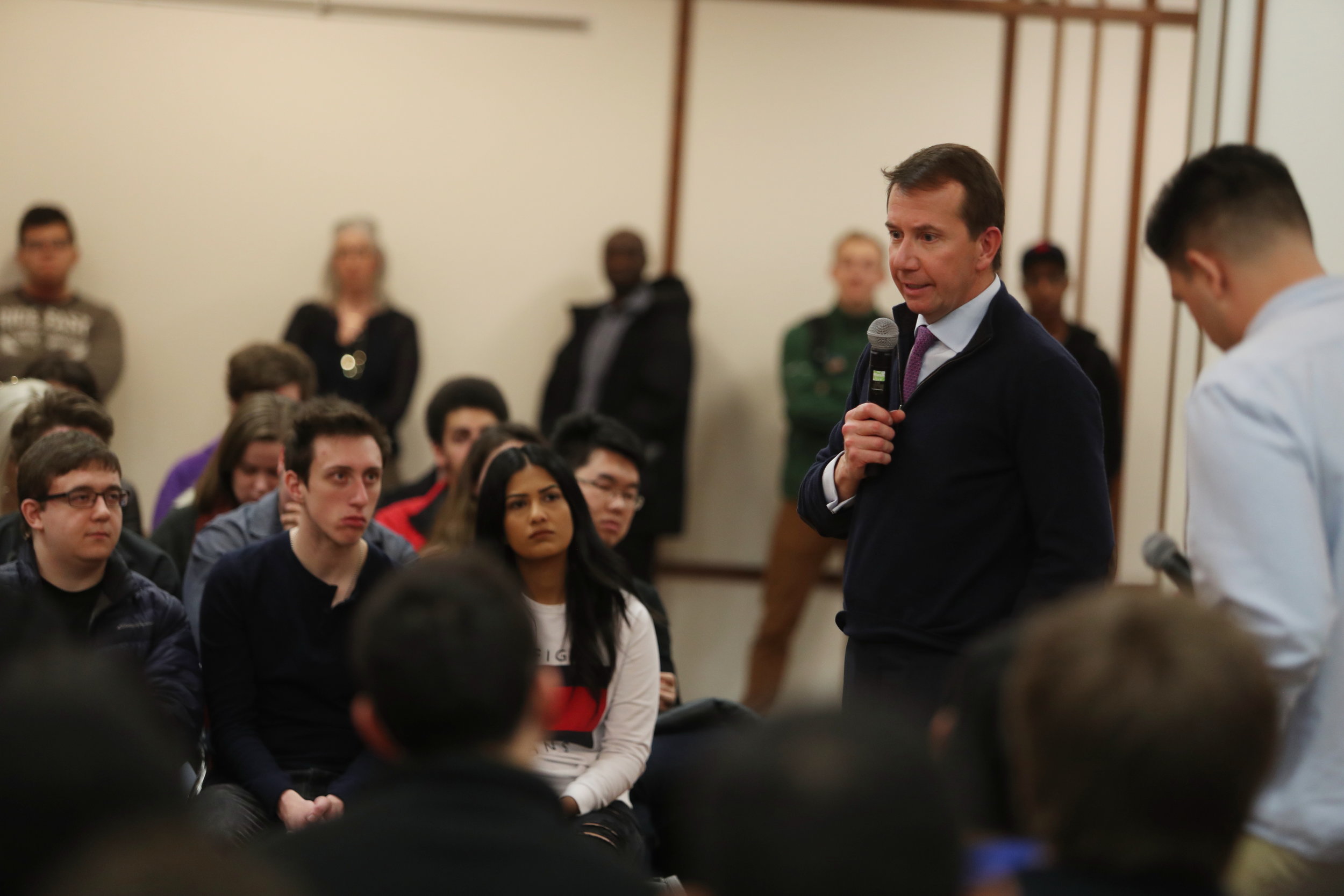
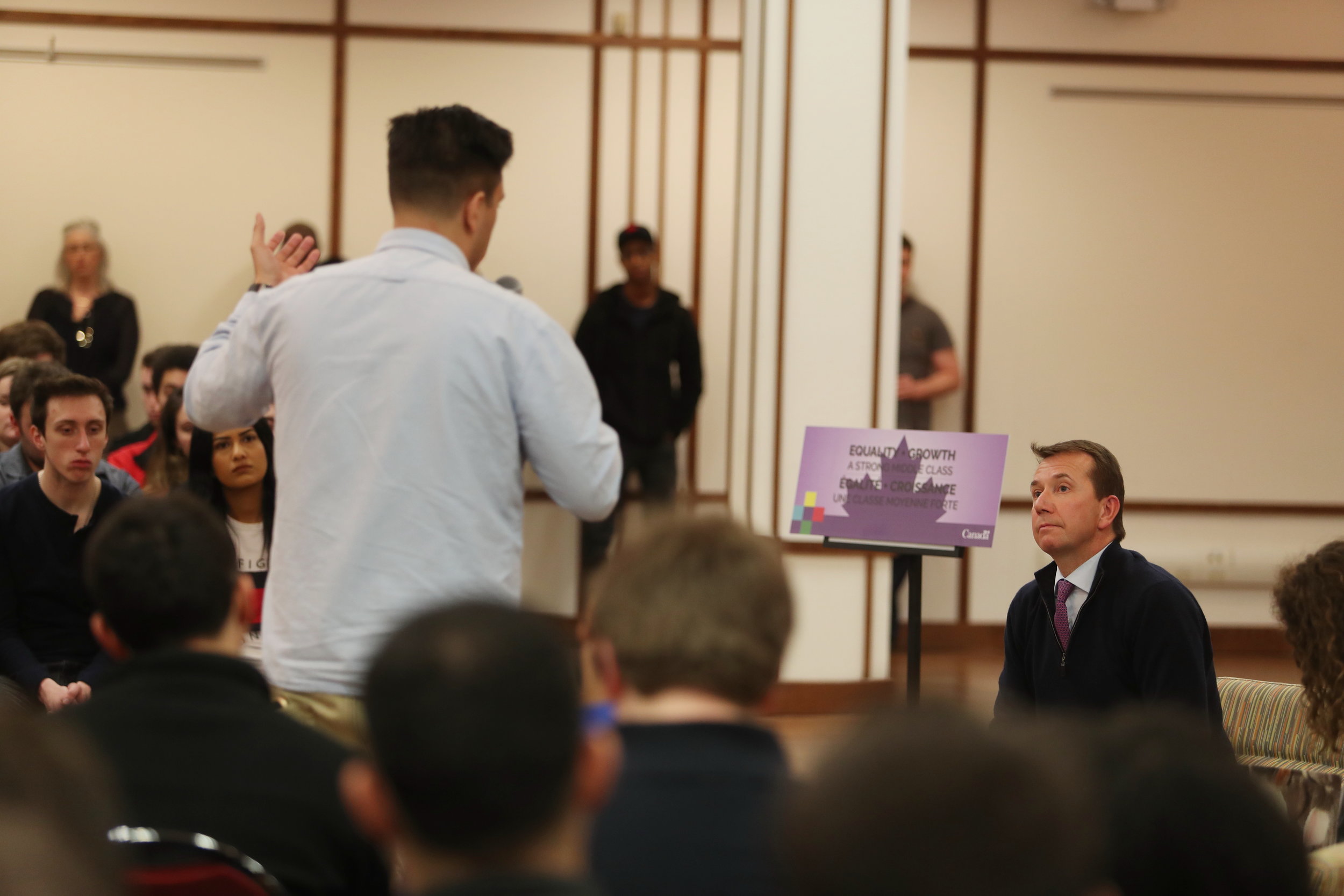
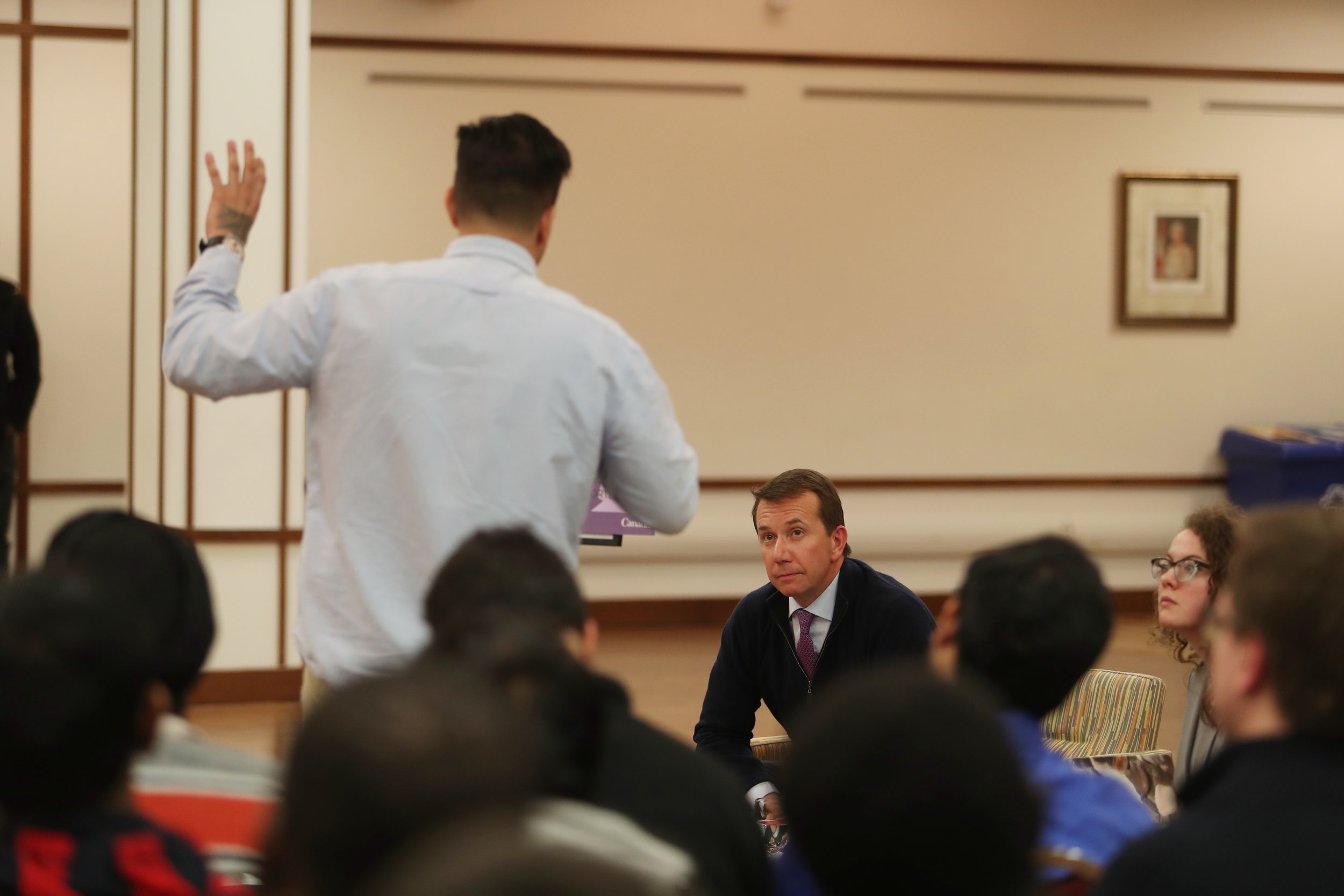
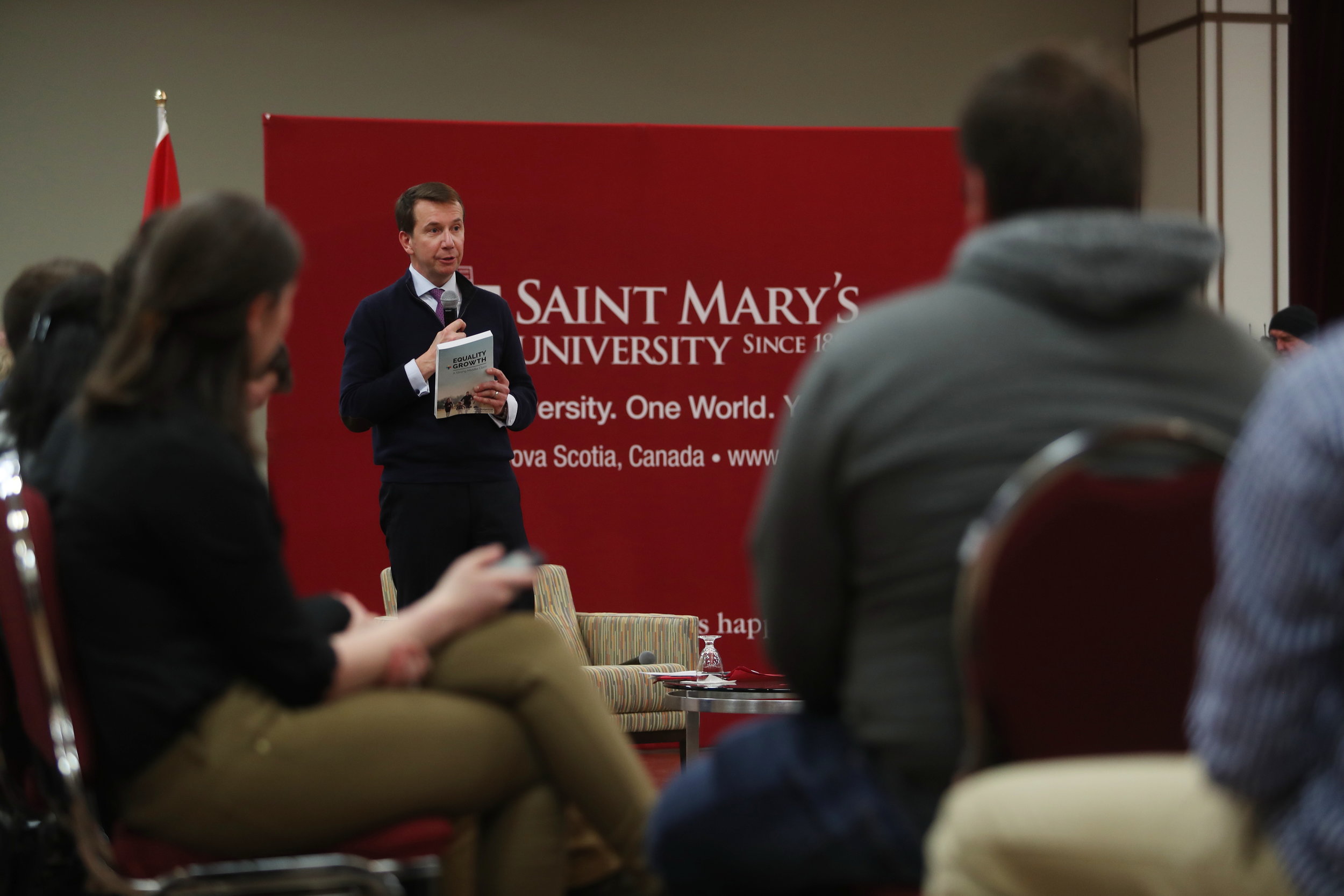
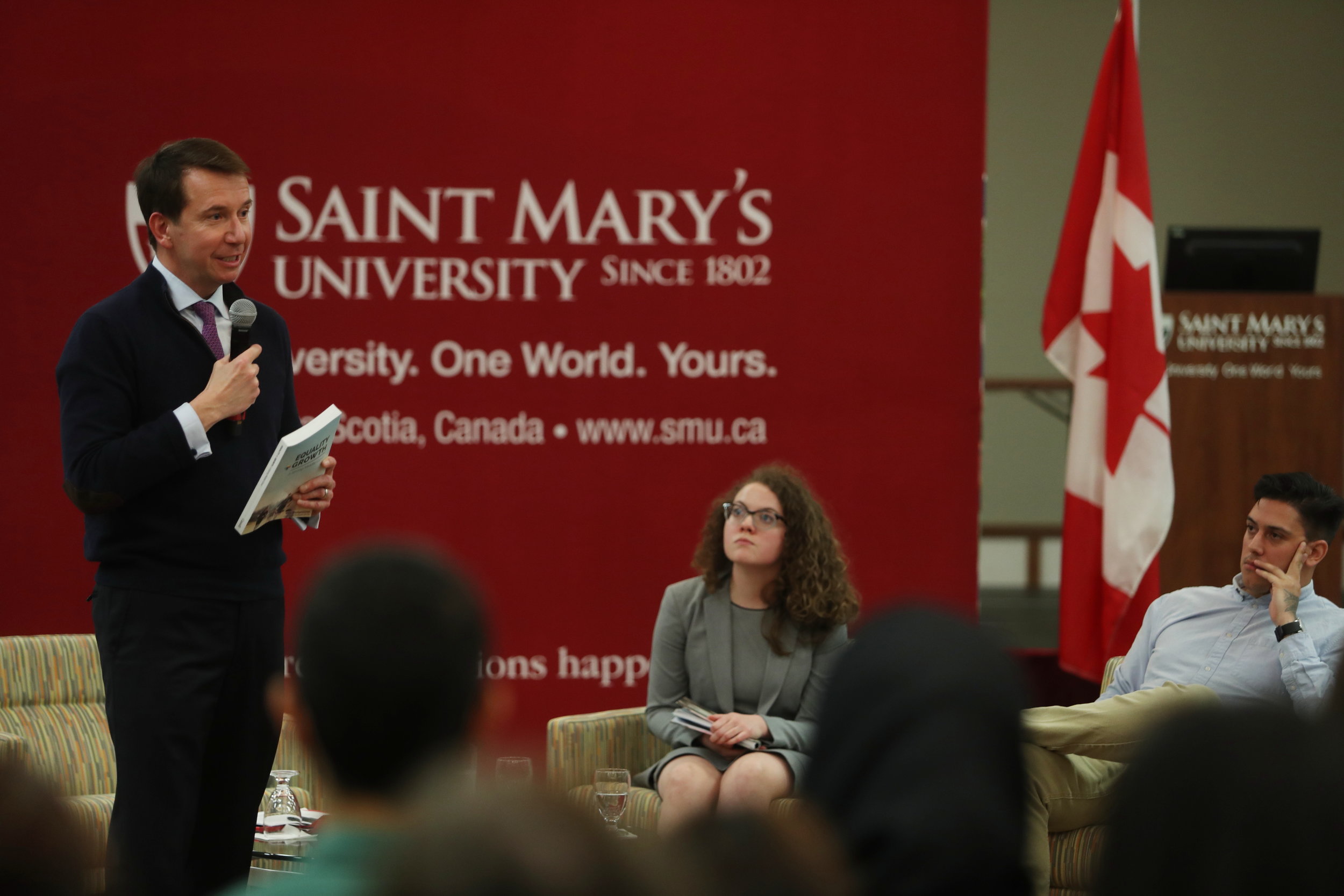
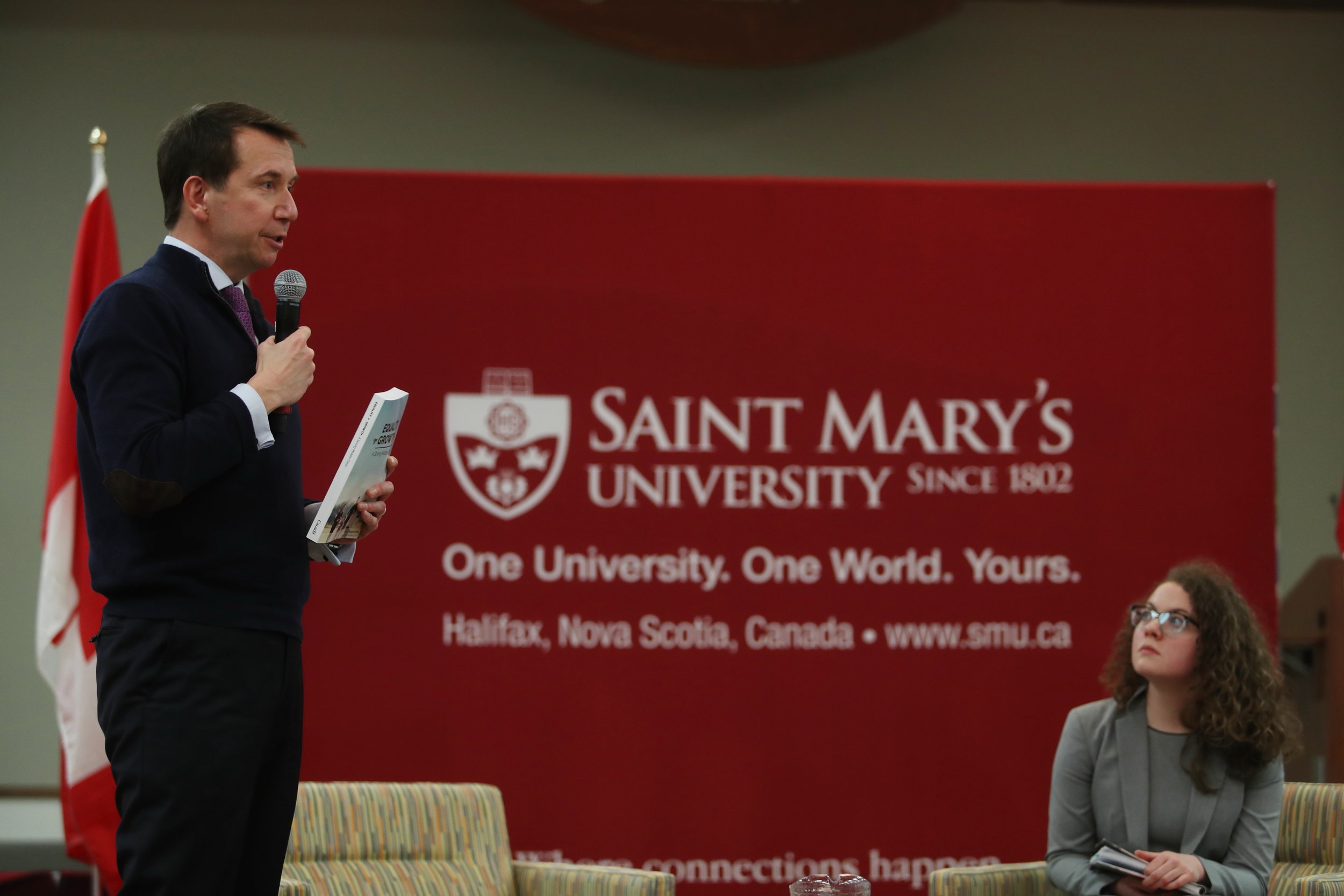

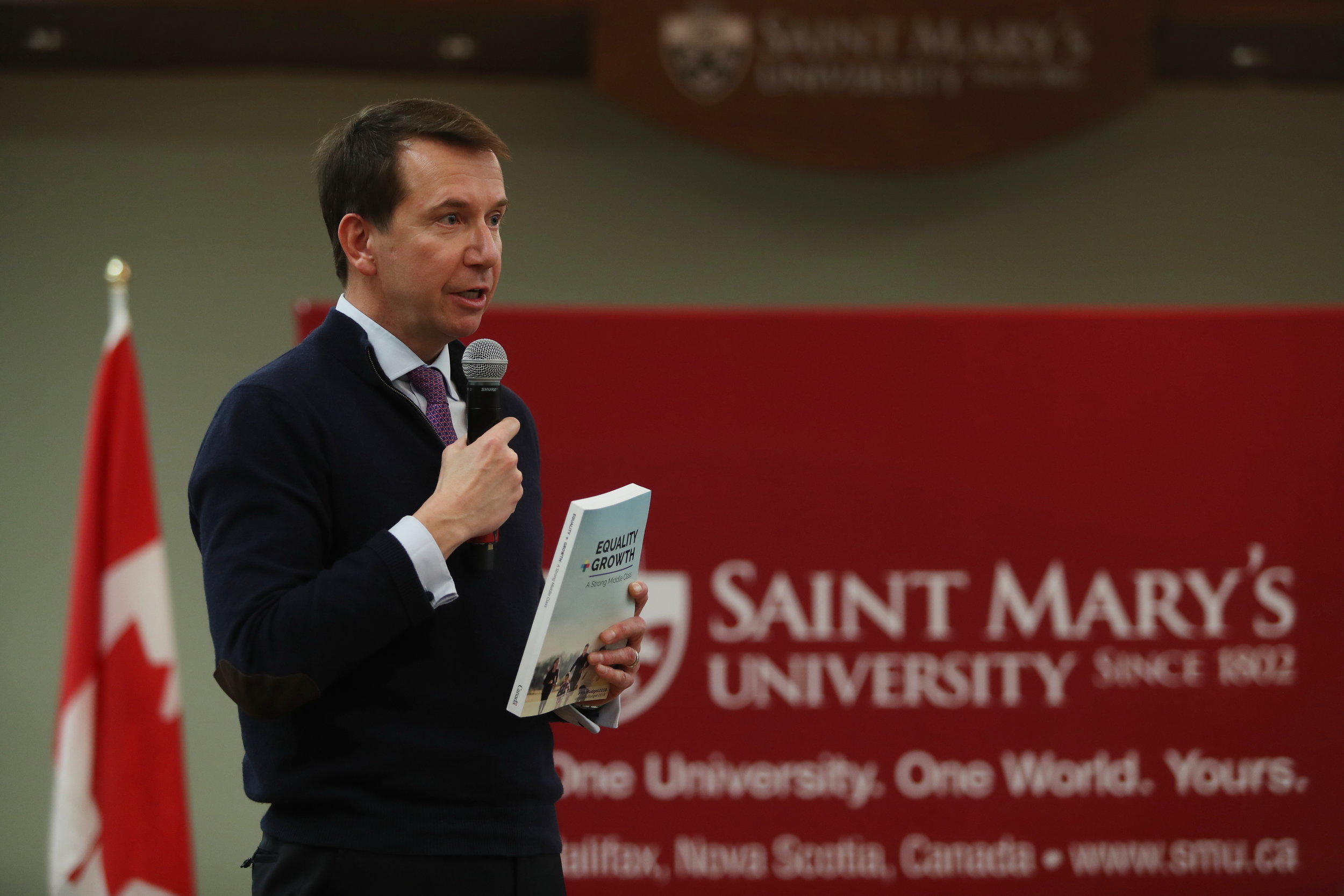
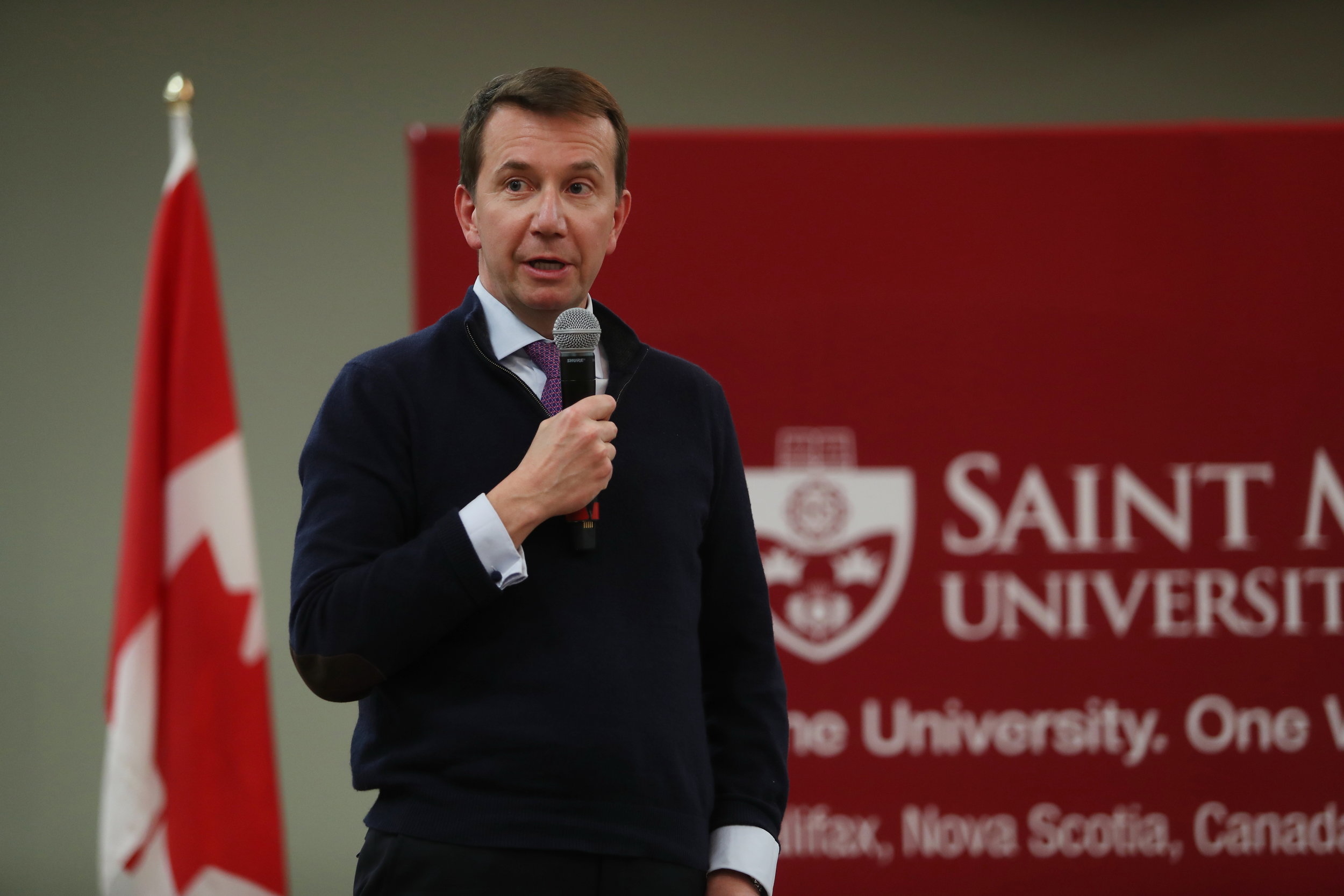
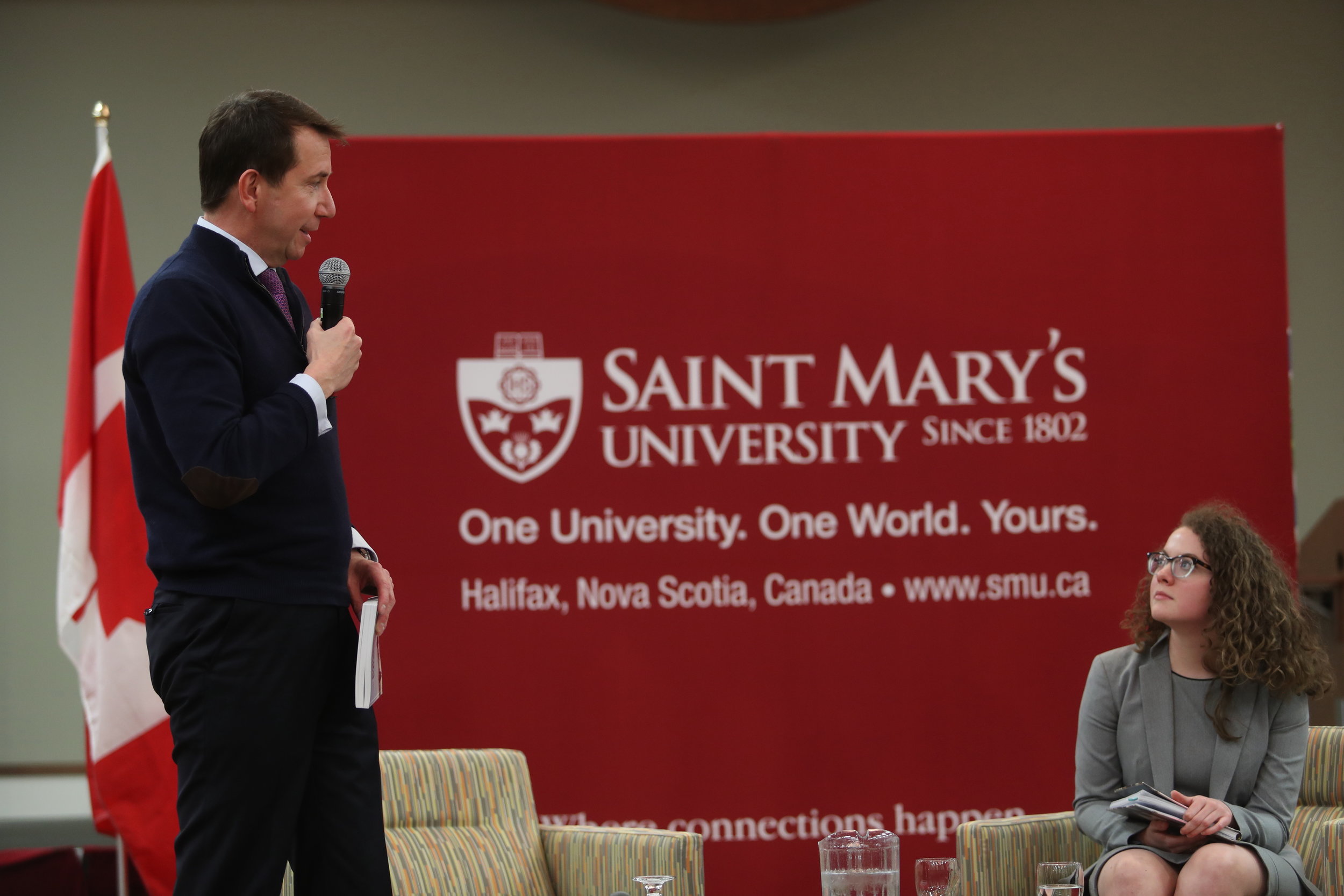
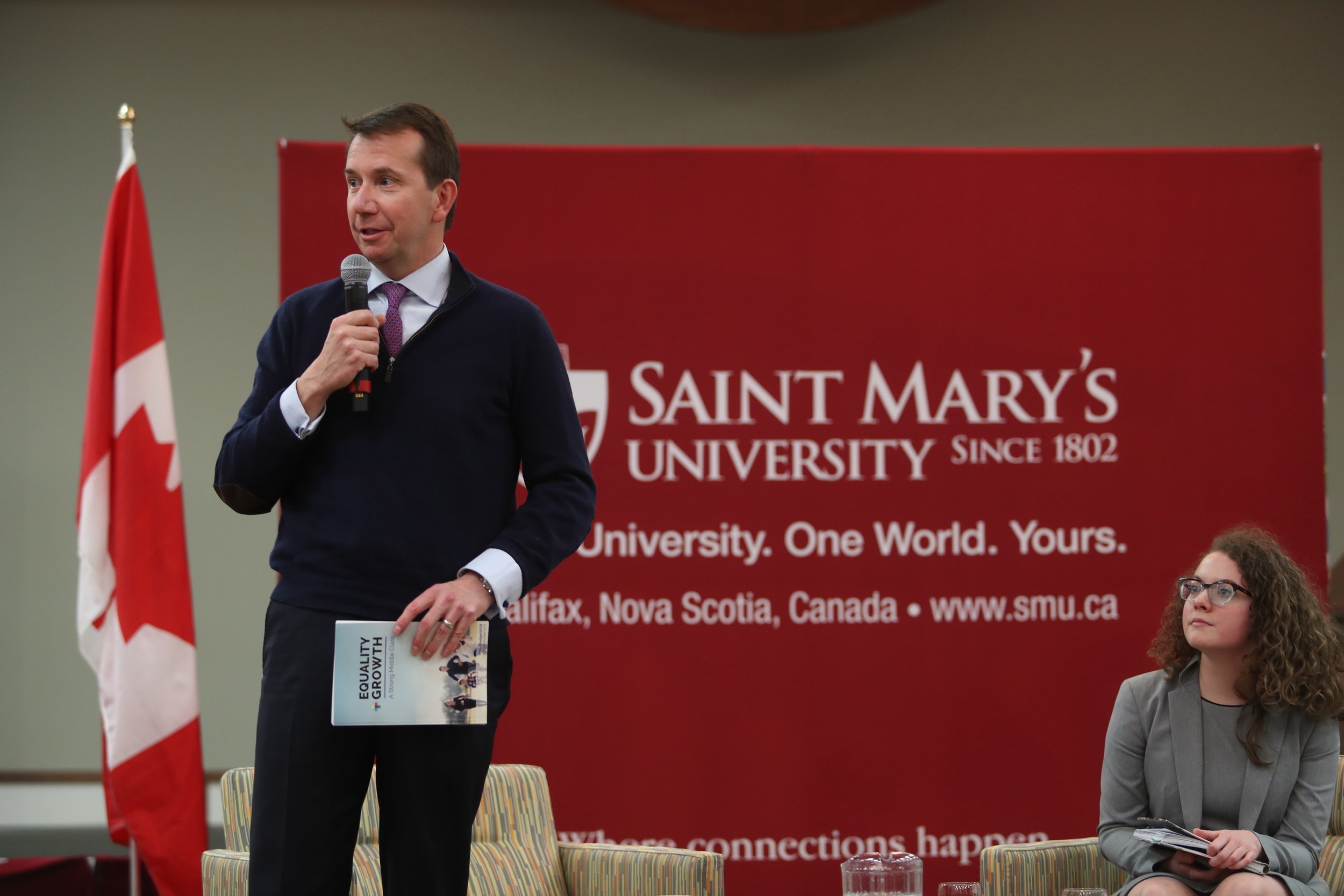
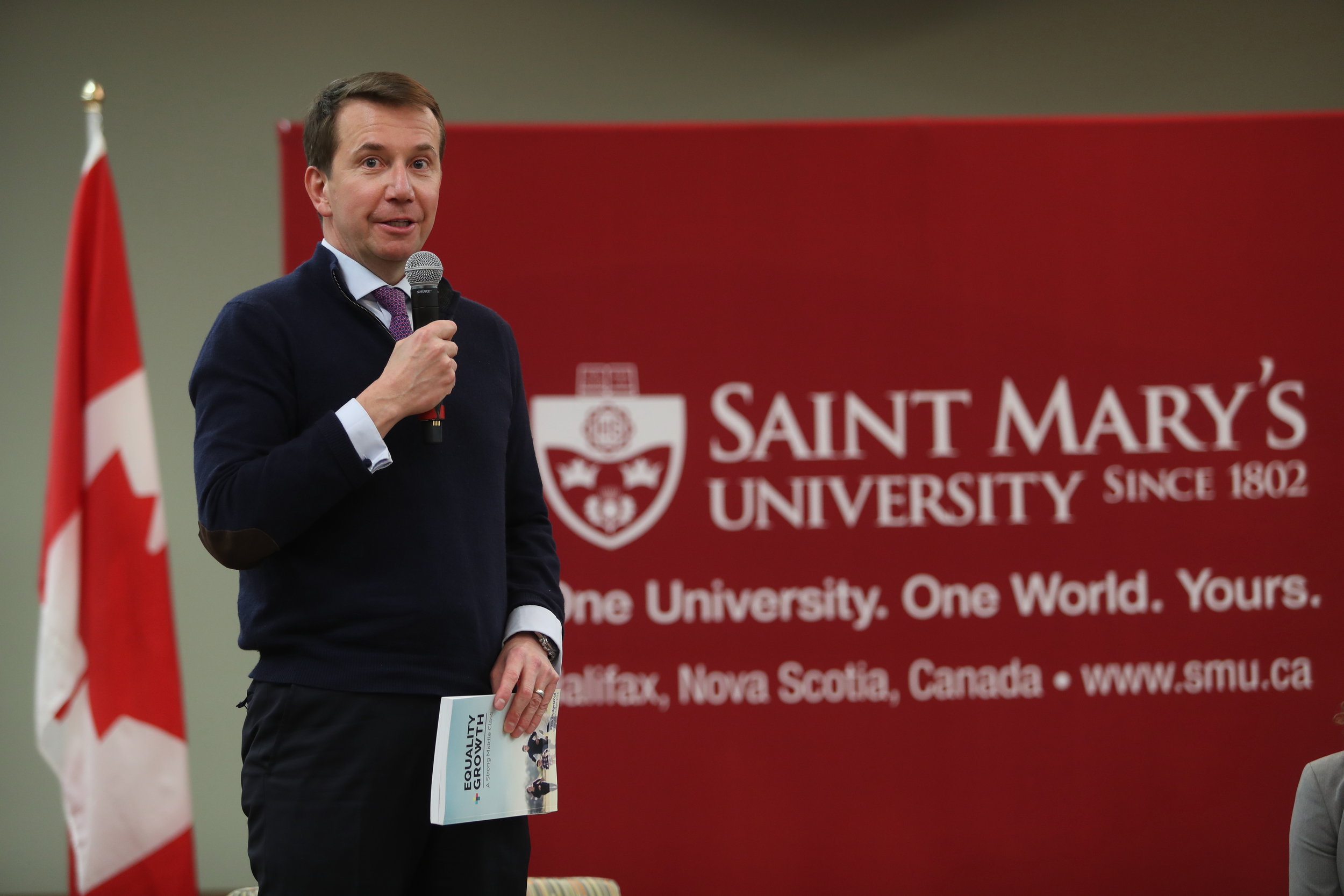
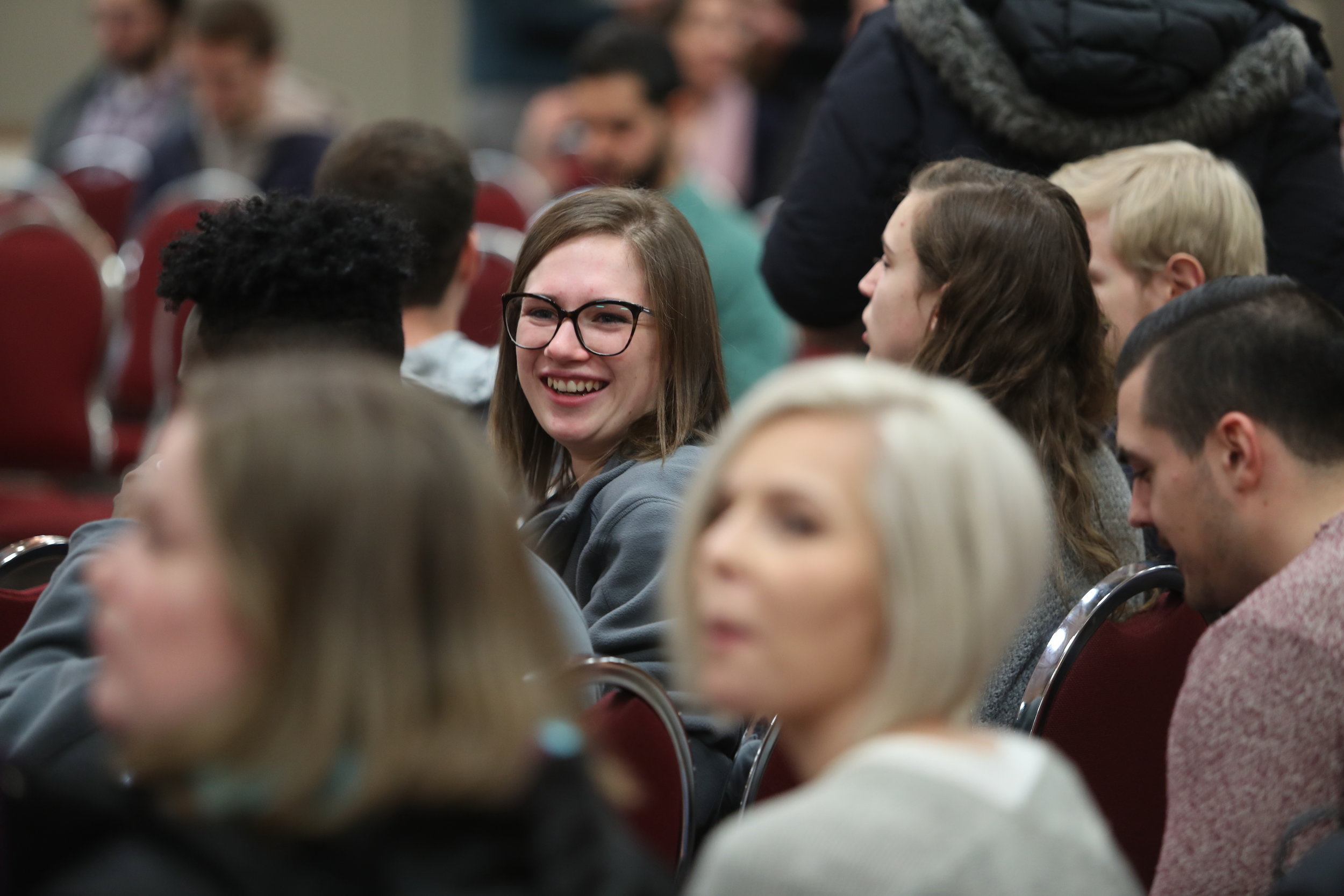

Dr. Jonathan Fowler (l); Greg Baker (behind), Instrument Technician with the Maritime Provinces Spatial Analysis Research Centre, part of the Saint Mary's Geography department; Sara Beanlands (senior archaeologist at Boreas Heritage Consulting and an adjunct professor in the Anthropology department).
This past semester, the Department of Anthropology at Saint Mary’s added a new device to its archaeological arsenal: the Noggin 500, a ground-penetrating radar (GPR) that will help students and faculty literally see beneath the soil as they explore some of Nova Scotia’s most important historic sites. The instrument is designed and built by Sensors & Software of Mississauga, Ontario.
“GPRs are used commonly in research and archaeological consulting internationally,” says Anthropology Professor Dr. Jonathan Fowler, “but less often in our region. We hope to change that.”
The purchase was a joint partnership between Boreas Heritage Consulting and Northeast Archaeological Research, two Halifax-based archaeological consulting companies. Sara Beanlands is an archaeologist with Boreas, a graduate of Saint Mary’s History program, and an adjunct professor in the Anthropology Department. She says it’s critical for students to have access to this kind of technology: “It’s already a standard part of archaeological practice in many parts of the world, and will become so here as well.”
Saint Mary’s students already have access to the Geonics EM38B, a device which measures soil magnetism and can put together a limited picture of what lies underneath. It’s especially good at seeing places where buildings have been burned and no visible traces remain—after burning, the soil’s magnetism is enhanced. This is especially helpful at sites such as the burned Acadian village at Grand-Pré.
The addition of the Noggin—with a different set of strengths—complements the EM38’s abilities and puts a whole other underground world within reach. Whereas the EM38 sees best in the top 50 centimetres of soil, the Noggin can see as much as two metres down, and can map the subterranean environment in three dimensions. The Noggin GPR is especially good at spotting “discontinuities” in soil texture and type, such as those caused by unmarked graves.

The result of this expanding technological toolkit is a more accurate sense of what lies where, especially valuable when making the most of time in the field.
“It’s important for students to learn the traditional approaches to mapping and examining sites,” says Beanlands, “but these absolutely help us focus where to dig and figure out where there’s better potential to find a site of interest.”
So far, Dr. Fowler has run a series of test surveys at archaeological sites in Nova Scotia. In collaboration with Parks Canada, the GPR is also being used at national historic sites, including Grand-Pré in the Annapolis Valley and Citadel Hill in Halifax. To call the early results promising would be an understatement.
“We’re seeing archaeological features we’ve never seen before,” says Dr. Fowler, “and it’s honestly totally changing my interpretation of certain things. The complementary principle is really playing out…and it’s giving students access to skills and training that are very rare, maybe unique, in Canada right now. This will be extremely important to their future careers.”

Dr. Jason Clyburne
Dr. Jason Clyburne, Professor in the Departments of Chemistry and Environmental Science at Saint Mary’s University, was named the winner of the 2017 Professional of Distinction Award at the Discovery Centre’s 15th Annual Discovery Awards for Science and Technology on November 23.
The Professional of Distinction Award honours world-class scientists who demonstrate ingenious thinking in the creation of unique ideas, concepts, and perspectives within their field. Previous recipients of this award have gone on to receive the highest science recognitions in both Canada and the world, including the Nobel Prize.
Dr. Clyburne is the first recipient in this category from Saint Mary’s University.
“Dr. Clyburne is internationally recognized as a leader in the study of green chemistry,” says Dr. Steven Smith, Dean of the Faculty of Science. “He has established a tremendous reputation for creative, elegant chemistry in pursuit of environmental solutions.”
A second Saint Mary’s faculty member was honoured at this year’s Discovery Awards Gala. Dr. Sam Veres, Associate Professor in Engineering, was one of three finalists in the Emerging Professional category. Less than five years into his professorship, Dr. Veres’ research has shown great promise to help reduce chronic pain related to soft-tissue damage.
Dr. Jason Clyburne – 2016 Professional of Distinction Winner
Dr. Jason Clyburne is widely recognized as a leader in the study of green chemistry, particularly in the field of ionic liquids and nucleophilic carbenes. His pioneering research, which involves the application of designer chemicals and materials to the removal of environmentally hazardous substances from industrial processes, is widely recognized for its potential to mitigate a wide range of environmental issues. In his young but robust career, Dr. Clyburne has built a reputation for excellence and creative innovation, and his colleagues repeatedly describe his work as “novel,” “creative,” and “original.” Most recently, Dr. Clyburne’s discovery of the elusive CO2 compound cyanoformate (published in Science) received significant scientific and media attention, particularly due to its promising implications for the future and direction of carbon capture technology.
Watch Dr. Jason Clyburne’s Discovery Award Finalist video
Read more about Dr. Jason Clyburne’s cyanoformate discovery
Dr. Samuel Veres – Emerging Professional Award Finalist

Dr. Samuel Veres
In fewer than ten years, biomedical engineer Dr. Sam Veres has made rapid progress through the scientific/engineering education cycle, and his work has provided fundamental insights into the structural changes that occur in mechanically overloaded soft tissues. By exploring mechanical damage to connective tissues in a novel way—with focus on the basic biomechanics of failure rather than the inflammation/healing responses that have occupied clinical medicine—Dr. Veres is working to develop new therapies for the treatment of tendons, ligaments, and the intervertebral discs of the lower back.

Ray MacNeil
Saint Mary’s University is pleased to announce that Ray MacNeil has joined the university as our new CLARI Network Manager. Ray is now finishing his second-week on campus and is a welcome addition to Saint Mary’s and the CLARI network.
“The CLARI facility here at Saint Mary’s is the heart of the province-wide network,” Dr. Adam J. Sarty, Associate Vice-President, Research and Dean of the Faculty of Graduate Studies and Research. “Ray brings decades of experience working in highly productive and collaborative environments to CLARI, and is the right person at the helm as we expand the reach of our change lab.”
A twenty-six-year veteran of the Nova Scotia public service, Ray has spent the last ten years of his career exploring advances in the complexity sciences and their application to improved public services. His work in this area has resulted in consulting requests with a number of other governments and institutions.
In 2016, Ray was honored with the Nova Scotia Public Servant of the Year Award by the Springtide Collective. In that same year, he retired from the public service and created Organizational Dynamics, a consulting firm dedicated to complexity informed management practices. Ray has remained a regular presenter on issues related to the management and measurement of public services.
CLARI is a cross-province, multi-post-secondary education partnership offering academic and research expertise, designated spaces and communications technology to support Nova Scotia communities in applying stakeholder collaboration techniques and action research toward addressing social and economic challenges.
CLARI’s hub-and-spoke style network spans the province, combining the talents and resources of its six founding partner universities and the Nova Scotia Community College’s 13 campuses. Through CLARI, partners can assist communities in all parts of the province in developing social and economic improvement projects while providing enhanced learning opportunities for students.

CorwinTrottier
Congratulations to Master of Science in Applied Science candidate Corwin Trottier, recipient of a prestigious $5000 Mineralogical Association of Canada (MAC) Foundation Scholarship.
Corwin Trottier is currently pursuing a Master of Science in Applied Science under the supervision of geology professor Dr. Jacob Hanley. He holds not one, but two undergraduate degrees from Saint Mary’s University: a Bachelor of Science in Physics and a BSc in Geology.
Trottier’s MSc thesis builds on his summer research with Dr. Hanley and Dr. Georgia Pe-Piper, where he studied samples from the Great Bear magmatic zone (GBMZ) in the Northwest Territories. These samples contain polymetallic “five-element” (Ni-Co-As-Ag-Bi) mineralization, which occur as structurally controlled veins within lightly metamorphosed volcanic and sedimentary host rocks.
“Noteworthy recent research on five-element veins have focused on several European deposits, but GBMZ deposits remain untouched by modern analytical techniques,” writes Trottier in his thesis rationale.
Trottier’s research examines 60 rock samples that had been collected in the 1960s from the Eldorado Mine, which operated from 1933 to 1982, and stored at the Department of Natural Resources (DNR) division of the Geological Survey of Canada (GSC) in Ottawa. His objective is to advance the understanding of the ores at Eldorado Mine and similar five-element veins using modern analytical tools.
“Mr. Trottier is laying new ground in our understanding of uranium-silver deposits in Canada and abroad,” said Dr. Hanley. “I have been greatly impressed by his worth ethic and care in conducting this important research.”
Previous studies in the GBMZ have not quantified the metals in ore fluids, nor have they captured trace element and stable isotope chemistry at the scale of individual vein stages. As a result, current models have not been able to explain the source of uranium and other metals at Eldorado from a geochemical perspective.
“Final results will be compared to those of previous studies in the GBMZ and other five-element occurrences around the East Arm of Great Slave Lake, NWT,” writes Trottier. “This comparison will provide insight into the potential genetic relationship between similar deposit styles of variable ore grade at local and regional scales. The expected outcome will bring a better understanding of how ore metals are distributed in similarly complex vein deposits.”
The Mineralogical Association of Canada awards two $5000 scholarships yearly, one to a student enrolled in an MSc program and one to a student in a Ph.D. program. The applicable fields of study are: Mineralogy, Crystallography, Geochemistry, Mineral deposits and Petrology.
Saint Mary’s Researchers Receive $1.3M in NSERC Grants
Eight Saint Mary’s researchers will receive $1.3 million in funding from the Natural Sciences and Engineering Research Council of Canada (NSERC), as announced at the University of Victoria in British Columbia.
This funding comes from NSERC’s Discovery Grants Program, which supports ongoing natural sciences and engineering research projects with long-term goals. In addition to promoting and maintaining a diversified base of high-quality research at Canadian universities, Discovery Grants help provide a stimulating environment for student research training.
Dr. Rituparna Kanungo
Subatomic physicist Dr. Rituparna Kanungo will receive $600,000 to help unravel the secrets of rare isotopes that have asymmetrical ratio of neutrons to protons. By using accelerated beams of these nuclei created through nuclear reactions in the laboratory, Dr. Kanungo’s research will add to our understanding of nature’s strongest force (nuclear force) and shed light on neutron-rich objects in the universe. It will also expand our knowledge of what drives exploding stars to create the majority of heavy elements—like Gold and Platinum—that we see around us.
Dr. Kanungo’s research challenges our century-old knowledge of nuclei, which form the core of all matter in the universe. It also contributes to a new and evolving view of the nucleus, which is at the forefront of nuclear physics research worldwide.
This grant adds to Dr. Kanungo’s ongoing research into rare isotopes at particle accelerator facilities GSI in Germany and National Superconducting Cyclotron Centre at Michigan State University. It also supports her work at RIKEN, Japan’s largest comprehensive research institution.
Dr. Clarissa Sit
Chemical biologist Dr. Clarissa Sit will receive $165,000 to fuel her hunt for new antibacterial and antifungal molecules (natural products) in unusual places—like honey bee colonies—using cost-effective techniques. Together with her recent award from the Canada Foundation for Innovation, this funding supports Dr. Sit’s commitment to tackle one of society’s most challenging public health problems: the development of drug-resistant pathogens like Clostridium difficile (C diff) and Methicillin-resistant Staphylococcus aureus (MRSA) known popularly as “hospital superbugs.” By isolating and studying molecules from microbes that have naturally grown and competed for resources in their environment, Dr. Sit’s research will determine which natural products allow for certain microbes to dominate. The molecules Dr. Sit discovers through this process will serve as targets for other chemists to synthesize and hold tremendous promise for new drug development.
Read more about Dr. Sit’s recent and ongoing research
Dr. Paul Muir
Mathematician Dr. Paul Muir will receive $130,000 to help develop efficient, error-controlled software for three classes of differential equations (BVODEs, 1D PDEs, and 2D PDEs) that arise in computational models in a wide variety of application domains. These software tools are key to the accurate and efficient solution of these computational models, which are now widely recognized as the third major pillar—along with theory and experiment—in contemporary investigations of scientific phenomenon.
Dr. Laura Weir
Evolutionary biologist Dr. Laura Weir will receive $120,000 to investigate the influence of ecological conditions on mechanisms of sexual selection and evolution of sexually-selected traits. Through field research on salmonid fishes in Eastern Canada and lab work involving small, freshwater fish from the genus Oryzias, Dr. Weir’s research will provide a new perspective on the consequence of variation in sexual selection within and among animal populations.
Dr. Nader Azad
Management Science professor Dr. Nader Azad will receive $100,000 to develop mathematical models along with approaches to analyze the effect of disruptions to supply chains. The Global Procurement Study has shown that 80% of companies are vulnerable to a major disruption in supply, due to the interdependence and global complexity of today’s supply chains. Dr. Azad’s research will provide a methodology to manage disruptions and improve decision-making.
Dr. Genlou Sun
Biologist Dr. Genlou Sun will receive $26,000 to examine whether some plants evolved additional sets of chromosomes in order to thrive in changing environmental conditions. Using the wild barley (Hordeum bulbous) plant species as a case study, Dr. Sun will use innovative molecular and experimental approaches to reveal the role additional sets of chromosones play in the formation of new and distinct species.
Dr. Stavros Konstantinidis
Computer scientist Dr. Stavros Konstantinidis will receive $20,000 for his research related to the mathematical constraints of machine languages, which allow computers to perform computations and communications reliably and efficiently. By addressing several algorithmic questions related to the sets of words that make up machine languages, Dr. Konstantinidis aims to reduce improper readings of these words and support stable processing.
Dr. Linda Campbell
Environmental scientist Dr. Linda Campbell will receive $20,000 to investigate freshwater contamination from the roughly three million tonnes of untreated tailings, a modern legacy of century-old abandoned gold mines in Nova Scotia. Her research will establish experiments to quantify and characterize how specific freshwater fish and insect species may accumulate heavy metals from goldmine tailing sediments. She will also explore the viability of a new, inexpensive selenium-additive method to reduce mercury and arsenic toxicity in aquatic ecosystems.
Thomas Steele receives Canada Graduate Scholarship
In addition, PhD in Applied Science candidate Tom Steele was awarded a Canada Graduate Scholarship to investigate the factors that influence chronic disease development within lady beetles. Specifically, Steele will explore the role of defense chemicals on pathogen development and the impact of stress factors like temperature and crowding on beetles’ development of chronic Microsporidiosis, a group of spore-forming parasites. This project complements Steele’s larger research focus on the effects of Microsporidiosis on beneficial lady beetles used for biological control programs, which use natural enemies to control pest populations.

Shelby Scott
M.Sc.-student Shelby Scott, a Forensic Anthropology student at Saint Mary’s University, has been putting her education to use in a meaningful way. She has recently returned to Halifax from Cyprus, where she was working with a group that identifies missing persons for the Committee on Missing Persons (CMP) in Cyprus. The CMP’s objective is to recover, identify and return to families the remains of 2000 people who went missing during conflict in the 1960s and 70s.
Shelby has also done forensic work in Thailand and South Africa and recently presented at the American Association of Physical Anthropologists (AAPA) conference in New Orleans, LA. She is supervised by Dr. Tanya Peckmann, Anthropology professor at Saint Mary’s and an experience forensic anthropologist.
She answered a few questions about her studies and her work in Cyprus.
Q. How did you get involved in this program in Cyprus?
I have always been interested in forensic anthropology in humanitarian contexts, and knew that I would need to investigate international opportunities in order to gain this kind of experience.
I got the two-month student contract after hearing about it from Dr. Claudia Garrido Varas, a member of my supervisory committee and a forensic adviser with the International Committee of the Red Cross (ICRC).
Q. With whom did you work?
The Committee on Missing Persons (CMP) in Cyprus is a bi-communal body established in 1981 by the leaders of the Greek Cypriot and Turkish Cypriot communities with the participation of the United Nations.
The objective of the CMP is to recover, identify, and return to their families the remains of 2000 persons (501 Turkish Cypriots and 1,493 Greek Cypriots) who went missing during the inter-communal fighting of 1963 to 1964 and the events of 1974.
The CMP has three Members, two appointed respectively by the Greek Cypriot and Turkish Cypriot communities and a third Member selected by the International Committee of the Red Cross and appointed by the United Nations Secretary-General.
The CMP also employs a bi-communal forensic team of more than 60 Greek and Turkish Cypriot archeologists, anthropologists, geneticists, and psychologists. I worked with a team of Greek and Turkish Cypriot forensic anthropologists at the CMP Anthropological Laboratory.
What did you learn in this role, and was there anything you didn’t expect?
As a qualified graduate student, I have had the unique experience of working alongside CMP forensic anthropologists to clean, photograph, and analyze exhumed skeletal remains.
I was responsible for associating individual or fragmented bones with larger skeletal elements, and generating biological profiles to estimate the age, sex, and stature of the skeletal remains, as well as identifying particular pathologies, traumas, or dental characteristics. I also examined all clothing and personal effects found among the remains.
Many of the remains analyzed by the CMP are commingled and often severely fragmented, which makes skeletal reconstruction and identification difficult. As a result of these circumstances and the experience I have therefore gained, I have greatly enhanced my forensic anthropological skills, especially with regard to commingled and fragmented skeletal remains.
Another skill that I improved upon through this position is the analysis of juvenile skeletal remains (i.e. the remains of children). There are many Cypriot children that went missing as a result of the inter-communal fighting of 1963 to 1964 and the events of 1974; I was shocked by the number of juvenile remains that have been exhumed. Regardless of how long you have worked in this field, or how much experience you have as a forensic anthropologist, identifying the remains of juvenile victims of war will always be shocking and emotionally difficult.
That sounds like it was very meaningful work. Did you meet any of the families of victims?
Once the CMP formally identifies the remains of a missing person, the families concerned are informed without delay by the respective Cypriot Member of the Committee. Families notified of the identification of their missing relative(s) are offered the possibility to meet with scientists involved in the identification process and to view the remains in a facility located next to the CMP Anthropological Laboratory.
While I was completing my contract in Cyprus, I did not have the opportunity to meet with the families of victims or participate in the return of remains. I likely would not have been able to do so had the opportunity arisen, as I do not speak Turkish or Greek.
However, in past positions I have been involved in through my degree at Saint Mary's University (the Nova Scotia Medical Examiner Service, for example), I have had the opportunity to meet the families of deceased individuals, and I find that it is always tragic yet rewarding. The raw grief of families and the confirmation that their loved ones are gone is overwhelmingly sad. But by identifying the remains of a family’s loved one they are able to arrange for a proper burial and end a long period of anguish and gain closure. I always try to think of that as a positive.
What are your plans for the future?
Having just completed my position with the CMP, I aim to finish my Masters thesis, tie up my various other research initiatives, and graduate with a Master of Science in Applied Science degree from Saint Mary's University. I aim to begin my PhD (Forensic Anthropology) in September 2018. Ideally, I will remain within the realm of academia throughout my career, while also engaging in consultation work internationally and within Canada.

Aleka MacLellan
Saint Mary’s University is proud to announce that recent PhD in Industrial/Organizational Psychology graduate Aleka MacLellan has received the 2017 Kenneth E. Clark Student Research Award from the Center for Creative Leadership and the International Leadership Association. This prestigious award honours MacLellan’s doctoral thesis in leadership psychology, “The Role of Leaders in Motivating their Subordinates at Work.”
“To have my PhD dissertation selected from among submissions from six countries across the world is an honour,” says Dr. Aleka MacLellan. “It also shows that research conducted at Saint Mary’s University is making an impact globally, as well as in Canada.”
While there is substantial research on the importance of motivation in the workplace, little is known about how to change motivation. MacLellan’s thesis examines whether leaders’ personal levels of motivation and style of leadership affect employee motivation in the workplace. Her findings indicate that motivational effects often attributed to transformational leadership may instead be the result of a “motivation contagion” effect.
“Aleka's research brings a rigourous research methodology to bear on a question that is of both theoretical and practical importance. How leaders can inspire and motivate others is a critical question for organizations and Aleka's research brings us much closer to the answer to that question,” says MacLellan’s doctoral thesis supervisor Dr. E. Kevin Kelloway, Canada Research Chair in Occupational Health Psychology, and Professor in the Department of Psychology, Saint Mary’s University.
MacLellan is grateful to Cystic Fibrosis Canada, an organization she previously volunteered and consulted for, for supporting her research. By allowing her to collect data during the first and second year of her PhD program, she was able to defend her PhD dissertation in less than three years.
MacLellan would also like to acknowledge the support of Dr. Anja Van den Broeck of the Research Centre for Work and Organization Studies (WOS Bxl), whom she collaborated with during two research semesters spent at the University of Leuven in Brussels, Belgium.
MacLellan recently started a position at Lee Hecht Harrison Knightsbridge, a consulting firm in Toronto, Ontario.
“Given that my areas of focus are in leadership assessment for the purpose of selection, succession planning, and development—as well as team effectiveness and organization culture—it is very important to consider the role leaders have on their team members,” says MacLellan. “I look forward to addressing this challenge in my new role as a Talent & Leadership Development Consultant.”
In October, MacLellan will return to Brussels to present her award-winning research at the International Leadership Association Global Conference.
The Kenneth E. Clark Award from the International Leadership Association (ILA) and the Center for Creative Leadership (CCL) recognizes outstanding unpublished papers by undergraduate and graduate students.
Winners of the award receive a cash prize; travel, accommodation, and registration to ILA’s Annual Conference; a complimentary 1-year membership in the ILA; and recognition at the ILA conference and in various multi-media ILA publications.

Dr. Clarissa Sit
Saint Mary’s chemical biologist Dr. Clarissa Sit’s research into how to combat antibiotic-resistant bacteria and fungi received a big boost today as the result of an investment of $171,204 from the federal government.
“Saint Mary’s University is home to innovative research that impacts not only our institution but contributes to addressing problems of global importance,” said Dr. Malcolm Butler, Vice-President, Academic and Research. “We are very appreciative of this federal investment as it represents a core part of our mission as a university, to engage in innovative research and disseminate its results in a way that will serve the community from the local to international level.”
Dr. Sit’s research addresses one of society’s largest public health challenges: antibiotic-resistant bacteria, viruses and other microorganisms. As a result of this funding, Dr. Sit will have access to a high-resolution mass spectrometer, equipment that will increase the success rate of finding new molecules in soil that have antibiotic or drug-like properties. If successful, this could lead to the discovery of microbes that develop new natural products, which can be used to develop new medications.
“While this new equipment is essential for my research, it also provides the first high-resolution mass spectrometer on campus, which is incredibly useful to my colleagues in chemistry, biology, geology, and environmental science in their research,” said Dr. Sit. “I am very grateful to the Canada Foundation for Innovation and the Government of Canada for their support and I know that this investment will have a big impact on both my research and scientific research in general at Saint Mary’s.”
This investment comes from the Government of Canada provided through the Canada Foundation for Innovation’s (CFI) John R. Evans Leaders Fund (JELF). Support from the federal CFI JELF program provides a portion of the funding needed for institutions to acquire research infrastructure to enable cutting-edge innovation, with contributions from the province and private sector making up the balance of the support.
“This federal infrastructure award recognizes Dr. Sit’s unique and innovative experience, and allows her to establish a lab at Saint Mary’s destined to make important contributions in the area of natural antibiotic research,” said Dr. Adam Sarty, Associate Vice-President Research and Dean of the Faculty of Graduate Studies and Research. “It also allows the next generation of Saint Mary’s students to train in state-of-the-art experimental techniques.”

Sobey School of Business student Drew Blair at The Shelf in the Halifax Seaport Farmers' Market
What will retail look like in 25 years?
By this fall, a new partnership aims to have a retail space in the Halifax Seaport Farmers’ Market offer a glimpse into that innovative future.
“Saint Mary’s University is committed to lifelong learning, supporting innovation and engaging with community, and this project, I am pleased to say, reflects all these commitments.”
This morning, representatives of the Market and Saint Mary’s University signed an MoU establishing the Seaport Market’s retail space called The Shelf as the first outpost of the David Sobey Centre for Innovation in Retailing and Services’ Retail Imagination Lab.
Overlooking the harbour from the Galley on the second floor of the Halifax Seaport Farmers’ Market, Executive Director Julie Chaisson pointed out that this event was steeped in history: Canada’s oldest continuously operating farmers’ market partnering with one of the country’s oldest universities, along with a research centre and business school named for one of Canada’s outstanding historic retail families, the Sobeys. “But this is not about the past—today, we look to the future.”
Retail innovations range widely, from data-informed store layouts, to video shelf talkers and robot sales associates, to virtual reality online and interactive digital environments. Which technology innovation should a retailer invest in? And how can the ROI be measured?
“This partnership will allow us to extend our support into new areas of innovation and technology that may not otherwise have been possible.”
These are the kind of questions that fires the imagination of researchers and retail analysts alike, and the Retail Imagination Lab will provide a setting to carry out pilot projects in a controlled space, with researchers there to observe, record and analyse results.
The David Sobey Centre will provide the experiments and innovation, and the Halifax Seaport Farmers Market will provide space, data access and other support through The Shelf. Students from Saint Mary’s University’s Sobey School of Business have been hired to establish the first set of innovations later this summer.

Julie Chaisson, Executive Director of the Halifax Seaport Farmers’ Market, Executive Director and Dr. Malcolm Butler, Vice President Academic and Research, Saint Mary’s University

Dr. Adam Sarty
Dr. Adam Sarty will be taking on the leadership role of Associate Vice-President Research and Dean of the Faculty of Graduate Studies and Research, effective August 8, 2017.
The Board of Governors approved this appointment following the recommendation of the search committee chaired by the Interim Vice-President Academic and Research, Dr. Esther Enns.
Dr. Sarty has extensive knowledge of and experience with Saint Mary’s, having joined the Department of Astronomy and Physics in 2000. Since that time he has taken on many roles, most recently Associate Dean of Science - External and Student Affairs.
A 3M National Teaching Fellow and recipient of many teaching and leadership awards, Dr. Sarty is a champion for both learning and research – key elements of his new role.
Dr. Sarty’s own research in the field of subatomic physics involves the study of the electromagnetic properties of protons, neutrons, and light atomic nuclei. His research area has an international scope, working at facilities in both Germany and the United States with collaborators from around the world.

Dr. Rituparna Kanungo, Department of Astronomy & Physics, and Amit Kumar, Master of Science alumnus, at TRIUMF.
Physicists are one step closer to understanding the mysteries of the strong nuclear force (the strongest force of nature) responsible for binding subatomic particles, thanks to Saint Mary’s researchers.
Astronomy and Physics professor Dr. Rituparna Kanungo and Saint Mary’s alumnus Amit Kumar, together with a team of Canadian and international researchers, have gained insight into the characteristics of the strong nuclear force through a highly-sensitive experiment conducted at ISAC Charged Particles Spectroscopy Station (IRIS).
IRIS is a Saint Mary’s University facility located at TRIUMF, Canada’s national laboratory for particle and nuclear physics in Vancouver.
Otherwise simply known as the “strong force,” the strong nuclear force is perhaps the least understood of the four basic forces in nature; the others are gravity, electromagnetism, and the weak force. Responsible for binding together the fundamental particles of matter (quarks) to form larger particles (protons and neutrons), the strong force also holds the atomic nucleus.
The project, which synthesized a state-of-the-art radioactive ion beam experiment and ab initio theory, was led by Dr. Kanungo and Dr. Petr Navratil from the TRIUMF theory department. Amit Kumar, a graduate of Saint Mary’s Master of Science in Applied Science, contributed greatly to the research at TRIUMF’s IRIS facility, as did TRIUMF postdoctoral fellow Angelo Calci.
The research work is published in Physical Review Letters highlighted as Editor’s Suggestion and discussed in APS Physics Viewpoint.
The team would like to gratefully acknowledge research support from NSERC, the Canada Foundation for Innovation and Nova Scotia Research and Innovation Trust. TRIUMF receives funding via a contribution through the National Research Council of Canada.